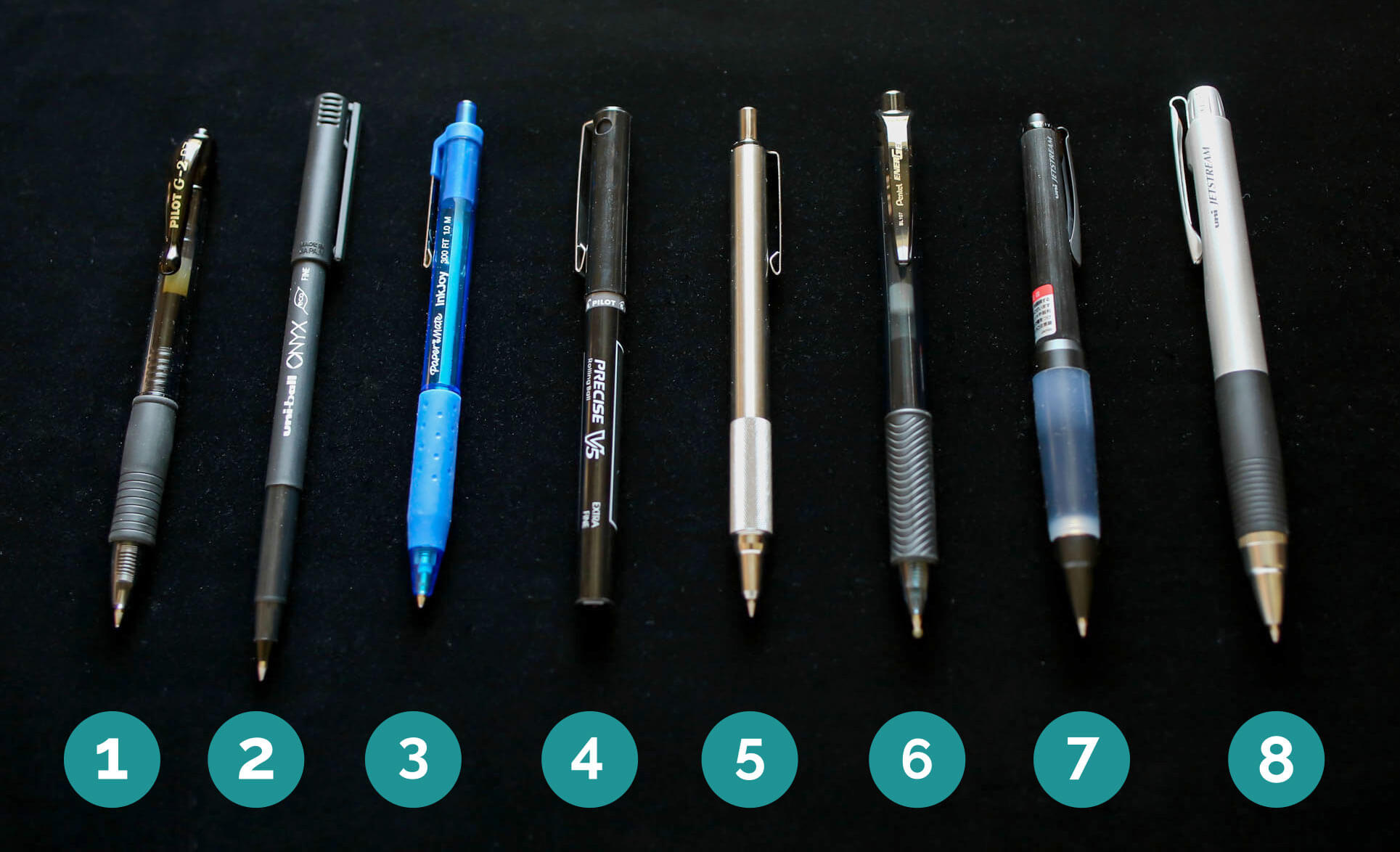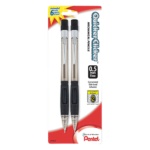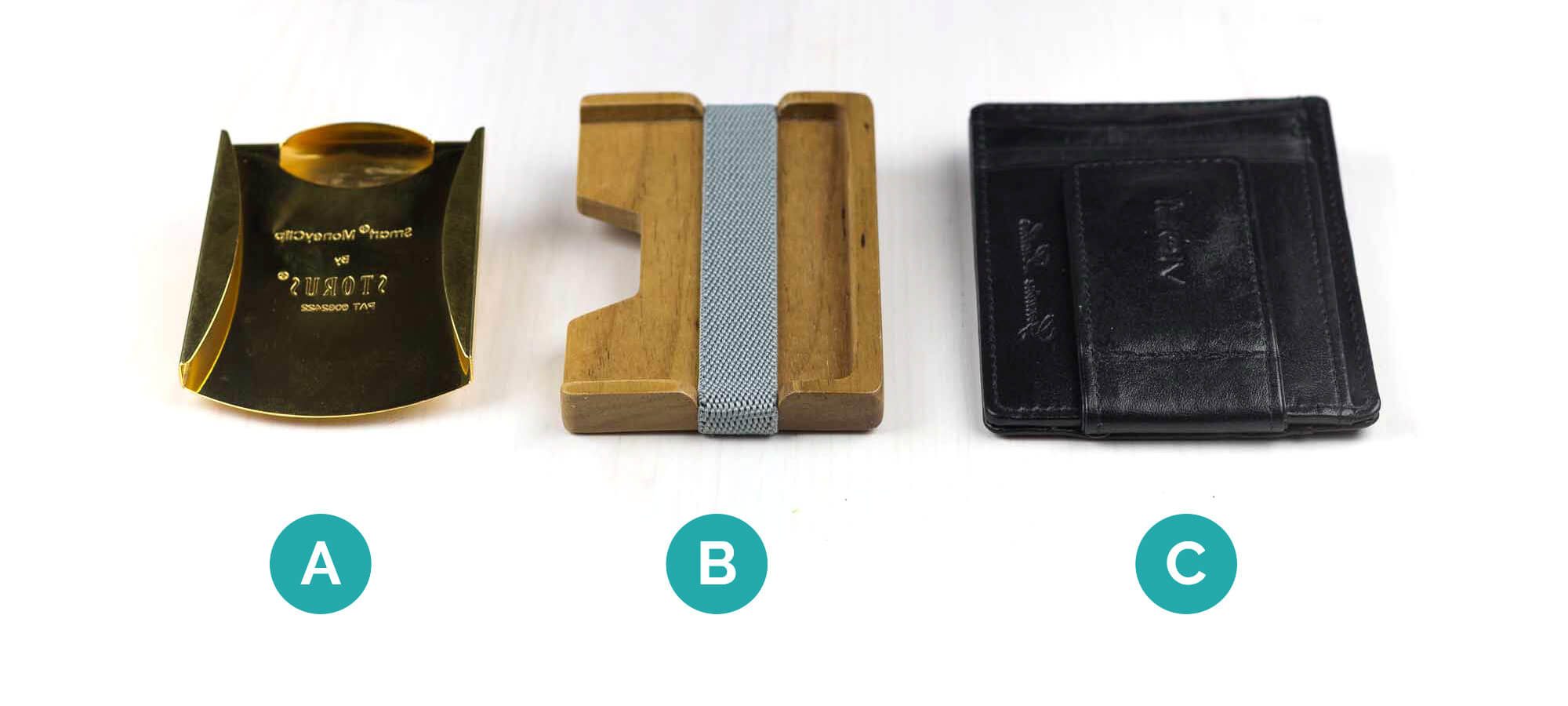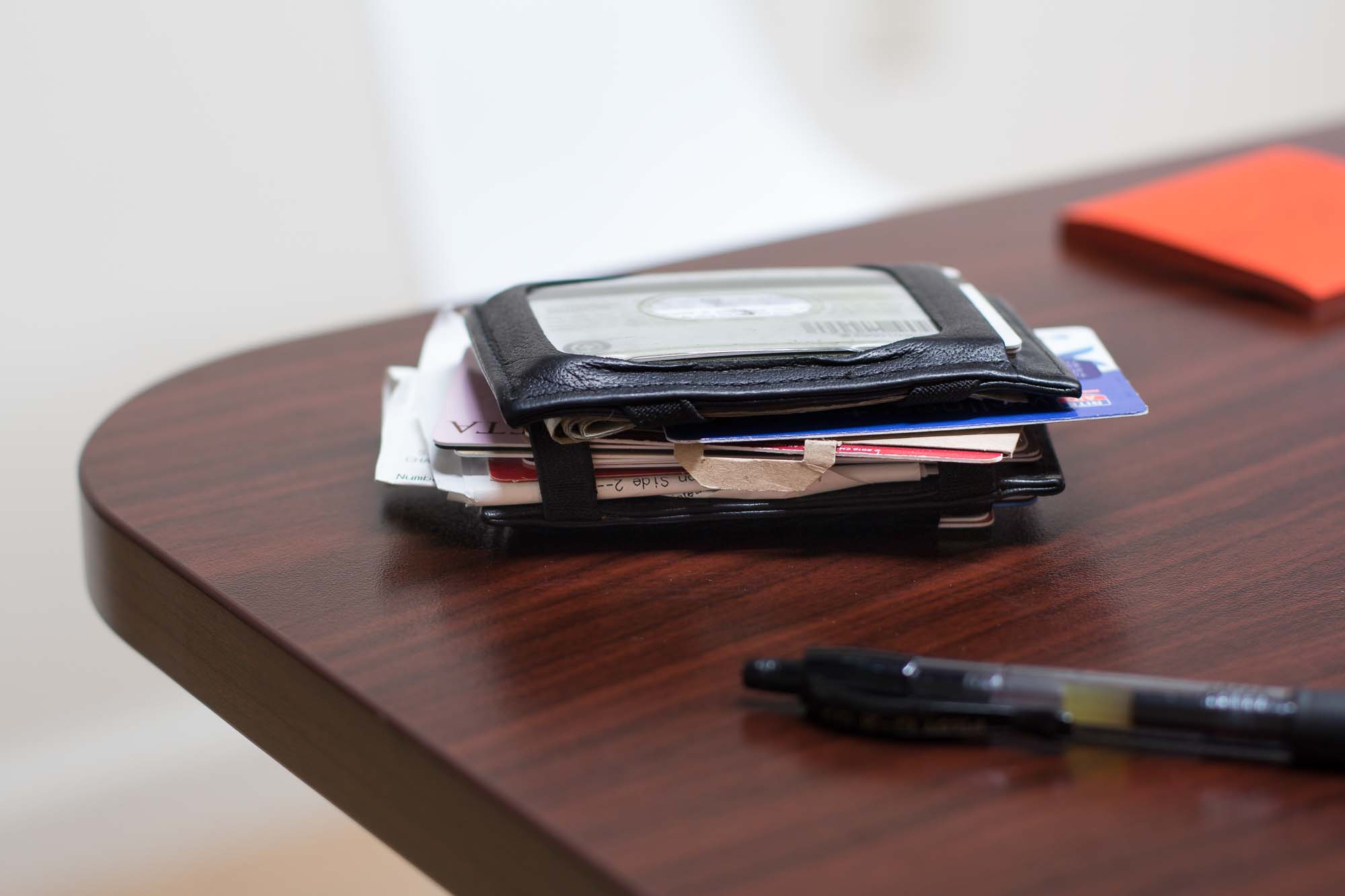The post The 12 Best Women’s Toiletry Bags appeared first on Your Best Digs.
]]>Travel is more enjoyable when you have the right gear. We’ve reviewed travel jewelry cases and packing cubes, but also wanted to find the best bag to hold your squishable and sometimes expensive toiletries and cosmetics. The ideal toiletry bag should be roomy enough for deodorant and tweezers or safety razors and magnetic eyelashes, while also protecting them from anything that might spill during transport.
The post The 12 Best Women’s Toiletry Bags appeared first on Your Best Digs.
]]>The post The Best Book Subscription Boxes appeared first on Your Best Digs.
]]>How we selected book boxes to test
We chose to test the most popular book box subscriptions across a variety of types and genres, which we found by selecting the boxes with the highest number of reviews and scores on Cratejoy. We tested at least two boxes from every subscription and checked for shipping or quality issues. For those that came with extras, such as coffee or bath goods, we considered their quality in rating each box. We also took into account late deliveries or poor customer service.
How you should select a box to purchase
If you’re considering purchasing a book subscription box, reading is probably a passion for you. There’s nothing more comforting than snuggling into a comfy sit-up pillow with the latest bestseller or tried-and-true classic and reading beneath the best book light.
Although some boxes are higher quality than others, most of your selection will come down to personal taste. We suggest looking at the Instagram hashtags for the box you’re interested in to see what it’s like.
You should note that most of the subscriptions lack a corporate finesse; the delivery dates can be unreliable, and nothing feels systematized. (That said, this is less true of our winning boxes, Once Upon a Book Club and Coffee and a Classic.)
You should also note that most subscriptions auto-renew, so keep an eye on your bank statement.
We suggest that you check out the CrateJoy page for your book box of interest to learn about subscription options and prices, as these can fluctuate.
The post The Best Book Subscription Boxes appeared first on Your Best Digs.
]]>The post The Best Sleep Masks appeared first on Your Best Digs.
]]>Table of contents
- Compare the best sleep masks
- 1. The top pick: Bucky – 40 Blinks
- 2. The budget pick: Mack’s – Dreamweaver
- 3. The luxury pick: Tempur-Pedic
- Other finalists we tested
- How we selected finalists to test
- How we tested
- Who needs a sleep mask?
- Important features to consider
- The bottom line
Compare the best sleep masks
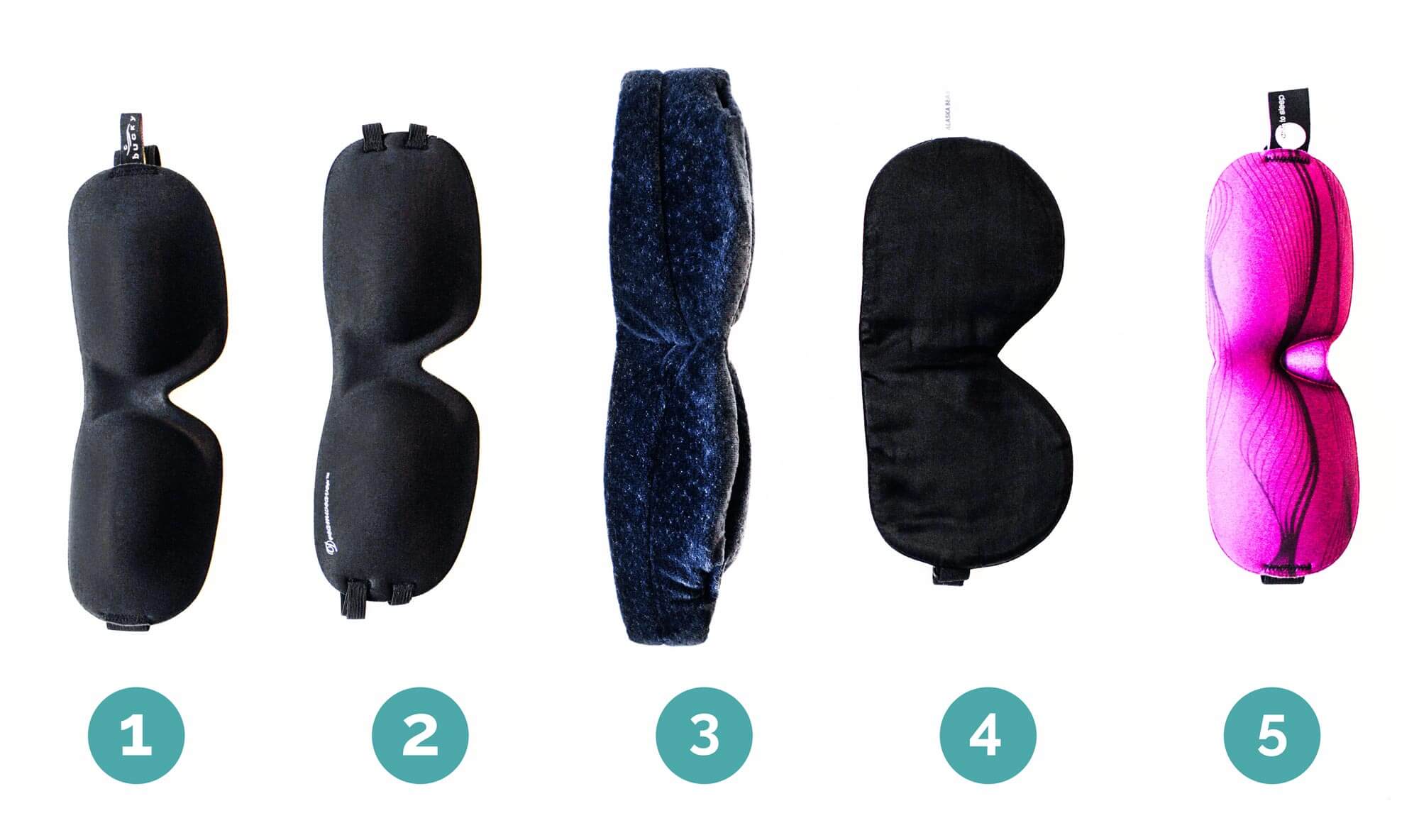
| Product | Price | Material |
|---|---|---|
| 1. Bucky | $$ | Polyester interlock and polyurethane foam |
| 2. Mack’s | $ | Artificial silk |
| 3. Tempurpedic | $$$ | Memory foam |
| 4. Alaska Bear | $ | Silk |
| 5. Drift to Sleep | $$ | Quick-dry material |
1. The top pick: Bucky – 40 Blinks
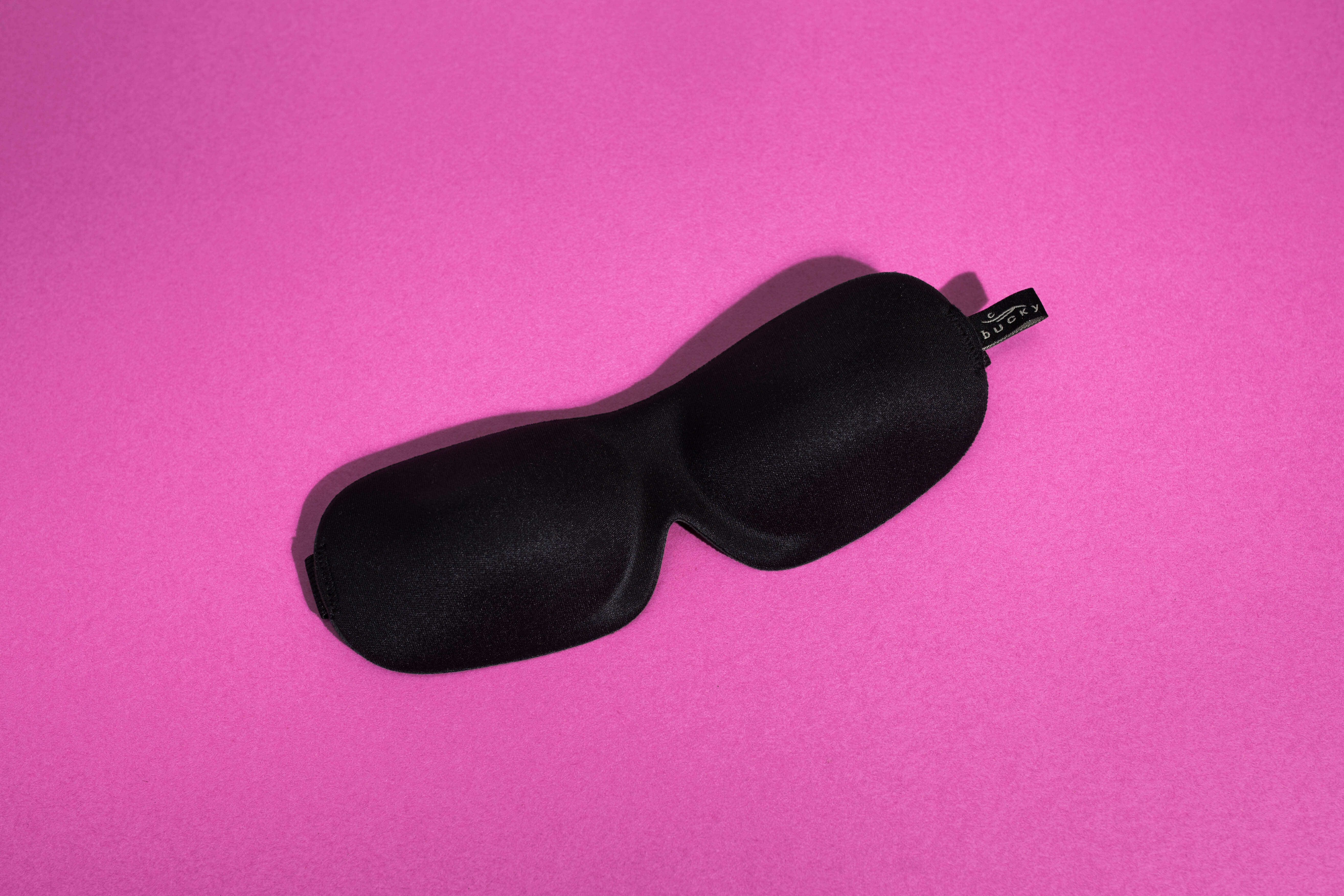
We’re not the first people to find the Bucky – 40 Blinks Eye Mask awesome. In fact, it was the most frequently recommended eye mask in the travel and health forums we visited. Reminiscent of your favorite pair of swim goggles, it has molded cups that keep pressure off your eyelids and an adjustable velcro strap to keep it secure on your face.
Our testers found that it didn’t irritate their skin or interfere with their blinking. The mask let their skin breathe, and it blocked light from every angle. (This, one of our testers pointed out, is impressive. They said their small nose leads to light seeping in through the bridge of other masks.) The Bucky didn’t leave any marks on faces in our testing, and our testers found the strap comfortable and high quality.
In our fluorescent lighting test, the Bucky still passed with flying colors. Each tester who tried it on said it blocked the harsh light from every angle. And though it’s not the cheapest mask on our list, it’s still a bargain at about 10 dollars.
Bucky — a Seattle-based company — started out making naturally-filled neck pillows, and has since expanded to more comfort-oriented products, like their PVC-free eye mask. Though Bucky says some of their products are made in the USA, they don’t specify if the eye masks are one of their domestic products.
Regardless of where this eye mask originates, we almost guarantee it’ll give you a good night’s sleep. We love that this mask is hypoallergenic, hand-washable and weighs less than an ounce. And with molded convex eye cups, it shouldn’t mess with your REM sleep or your eyelash extensions.
If there’s one thing we don’t like about the Bucky mask, it’s that its strap will not adjust to fit a child’s head.
Key takeaways:
- The Bucky – 40 Blinks is hypoallergenic and hand-washable, with molded eye cups.
- It blocks light from every angle, even in a bright, fluorescent-lit room.
- At less than an ounce, this mask doesn’t feel weighty or leave your face sweaty.
2. The budget pick: Mack’s – Dreamweaver

Very similar in design to the Bucky, the Mack’s Dreamweaver sleep mask rings in at just a few dollars cheaper. And while still a good mask, the few dollars may make a difference when it comes to blocking light. Some of our testers complained that the Mack’s had a tendency to let in light underneath the eyes if it’s not positioned on your face properly.
That being said, they liked its convex design and two straps, which help it stay positioned on your head more securely. This means it also stays put on kids, which the Bucky, according to their website, will not.
The Mack’s also came with an included set of earplugs, which we were ambivalent about, but might be helpful if you pick this mask up before a flight.
Overall, we recommend the Mack’s if you plan to use it just a few times per year for travel. If you want a mask to sleep with every night, go with the Bucky.
Key takeaways:
- The Mack’s Dreamweaver is our budget pick; at around seven dollars, it also comes with earplugs.
- It has convex eye cups and two straps, ensuring it stays in place on your head.
- If not positioned properly, the Mack’s can let in some light under your eyes.
3. The luxury pick: Tempur-Pedic
When we first heard of the Tempur-Pedic — a sleep mask made of memory foam — we thought it was over-indulgent. With a price tag of almost $30, it felt like an unnecessary splurge. However, rave reviews on many-a-forum led us to give it a shot.
Perhaps unsurprisingly, our testers loved it. So much so that the first person to wear it insisted on getting it back after testing. They found that despite its plushness, it didn’t feel heavy, interfere with their blinking or irritate or feel heavy on their skin. Furthermore, they found that its strap, combined with all of the extra cushioning, helped it stay securely in place.
Our subsequent testers, who tried on the Tempur-Pedic in a bright room, found that it did a superb job of blocking out all light.
So is it worth the relatively high price point? It depends. We’d say it performs just as well (and not better) than our number one pick, the Bucky, which costs about 20 dollars less. However, if you plan to use the Tempur-pedic in uncomfortable travel situations, like sleeping against the back of an airplane seat, we can see how the extra padding would give it a leg-up against the competition.
Key takeaways:
- At around 30 dollars, the memory foam Tempur-pedic mask is our luxury pick.
- It blocks light effectively and provides extra cushioning, without feeling heavy.
- While no more effective than our top pick, the Tempur-pedic may be preferable for travelers forced to sleep in uncomfortable positions.
Other finalists we tested
Sleep masks we recommend

Alaska Bear – Natural Silk Sleep Mask: As soft as the name implies, the Alaska Bear felt luxurious resting against our eyes — even though it only costs about ten dollars. Our testers loved the way it let their skin breathe, but did find that the silky material can slip around on rare occasion, causing light to seep through the bottom of the mask. Those who slept with the mask also liked that it was easy to breathe with it on. It didn’t put any pressure on their nose. And for those of us who wake up and head directly to work or class in the morning, it’s good to know that this one doesn’t leave any awkward red marks on our face.

Drift to Sleep – Unisex Sleep Mask: A couple dollars more than our top pick, the Drift to Sleep performed almost as well. This one is definitely the most flashy of the eye masks we tested. Though rest assured that you can get it in plain patternless colors if you don’t like the purple design. It has molded eye cups that won’t interfere with blinking, and it comes with molded ear plugs. However, if you toss around a lot in your sleep, this mask may not be for you. One of our testers who is a restless sleeper found that it moved in their sleep.
Sleep masks we don’t recommend

Dream Essentials – Sweet Dreams Contoured Sleep Mask: Unfortunately, the Dream Essentials was one of a few masks in our tests that felt too “heavy” on our testers’ faces, leading to irritated and sweaty skin in the morning. Moreover, its material felt rough, and our focus group testers found that light seeped through the top and bottom of the mask in a well-lit room.
Sleep Mask by Bedtime Bliss: Of all of the masks we tested, the Bedtime Bliss performed the worst. We found this interesting since it also had the most reviews of any of the masks we tested. Our testers found that it felt heavy and left their skin feeling sweaty and that the velcro strap continually caught in their hair. Moreover, one of our testers found that the mask had such a noxious artificial smell that they had to abandon wearing it after a couple nights. And, both they and our focus group testers found that light seeped into the mask under the eyes.
Happy Wraps – Hot Cold Lavender Eye Pillow: While this lavender-scented pillow is great for soothing headaches or helping you relax, its lack of strap renders it virtually useless as a sleep mask. Some users who reviewed it said it worked well because they exclusively sleep on their back, but unless that’s you, we don’t recommend it. The pillow does come with an inexpensive-looking conventional eye mask as a bonus. We tried it on but found that it felt like a cheap and flimsy afterthought.
Sleeping Eye Mask by Simple Health: Almost every tester who tried the Simple Health hated it. They found that it was too tight, put pressure on their eyes and slipped around while they were sleeping. We like the idea of an eye mask with gel inserts, so it’s a shame that this one didn’t perform well.
Jersey Slumber – 100% Silk Sleep Mask: While a silk mask seems like a good idea in theory, it may not be so great in practice. Our testers found that the Jersey Slumber slipped around on their faces as they slept, while the straps simultaneously dug into their scalps.
Sleep Master – Sleep Mask: The Sleep Master, inarguably the most unique looking mask on our list, got mixed reviews when it came to blocking light. Some testers found that it blocked all light efficiently, while others found that light filtered in under the eyes and through the bridge of the nose. We think the effectiveness of this mask depends on the shape of your face. Some testers also reported an uncomfortable pressing feeling on their eyelids.
How we selected
Perhaps unsurprisingly, a search for “sleep mask” yields a staggering number of results on Amazon. So, we started by filtering out masks with under four stars and less than several hundred reviews.
To further separate the wheat from the chaff, we took to forums like Mark’s Daily Apple (a health site) and Flyertalk (a frequent flyer blog). There, we heard from avid proponents of a good night’s sleep and frequent travelers who strive to get it. We used their suggestions for the best sleep mask to pare down our list of contenders.
We found that some of the most frequently-reviewed masks on Amazon were also the most recommended on the forums; so those ones made it to our list of finalists. We also added a memory foam mask from Tempurpedic, which many consumers loved.
Finally we took to our burgeoning list of finalists with a fine tooth comb, weeding out masks that seemed too redundant in material, design or both.
How we tested
We rounded up eight sleepy testers and asked them to select masks from our list of 11. Then we sent them home to hit the hay, asking that they sleep with each mask every night for a week. At the end of each week, they completed a survey about their experience. We asked them to answer questions like:
- Did your mask interfere with your ability to blink or flutter your eyelids?
- Does this mask block light from every angle? If not, where does the light come in?
- Does the strap fit and stay put comfortably? If not, why?
Next, we pulled hard on the straps and on the fabric of each mask, noting how well each stood up to the abuse. We found that each mask we tested stood up to aggression, and each mask’s straps snapped firmly back into place.
After that, we asked each tester to try on each mask in bright, fluorescent lighting, then document where light came through, if anywhere.
Finally, we hand-washed each mask to see how well it held up. Happily, each mask stood up well to a thorough scrubbing.
Who needs a sleep mask?
Two vocal groups in our search for the perfect sleep mask were night-shift workers (especially doctors and nurses) and frequent flyers. Both needed a way to block light while sleeping during the day or on a plane. Many city-dwellers also professed their need for a sleep mask, blaming metropolitan lights for a bad night’s sleep. Others still needed a sleep mask because their bedmate needed the light on.
We spoke with Chris Brantner, Certified Sleep Science Coach at SleepZoo.com, who told us that “darkness is essential for sleep. In fact, the dimming of light triggers the pineal gland to begin producing melatonin. Melatonin is crucial to make you feel sleepy. Not only is it necessary to fall asleep, but it also increases as you sleep to push you farther into the sleep cycle. On the flip side, when light hits your eyes, it inhibits melatonin production.”
So really, anyone who doesn’t have a totally dark sleep environment may want to wear a mask.
Important features to consider
Fit: Always choose a mask with an adjustable strap, so you can fit it to your head. Masks that only cover the eyes (and not the bridge of the nose) are also preferable, because they’ll fit regardless of your facial features. All of our top picks cover only the eyes and have adjustable straps.
Quality: Choose a mask that doesn’t seem too delicate; it will need to stand up to nightly use or at least being tossed around in your luggage. It should also stand up to a gentle hand-washing in water mixed with detergent.
Material: Your mask should be made of a material that won’t feel heavy or make you sweat. (Our top pick was a polyester blend.) Silk is often touted as luxurious choice for a sleep mask, but our testers who tried the silk masks found that they slipped around too much on their faces.
Shape: Many people prefer eye masks with molded eye cups, because they don’t interfere with blinking or damage eyelashes.
The bottom line
Few things are more important than a good night’s sleep. For a sleep mask that’ll make sure you get it, choose the Bucky – 40 Blinks. At just around 10 bucks, you may want to get one for your nightstand and another for your carry on bag.
If you’re looking for something even cheaper to use just once in a while, grab the Mack’s Dreamweaver. And if you’re feeling indulgent, the Tempur-Pedic is a luxury pick that won’t disappoint.
The post The Best Sleep Masks appeared first on Your Best Digs.
]]>The post The Best Pens appeared first on Your Best Digs.
]]>Table of contents
- How we selected finalists to test
- Compare the best pens
- Pen types and sizes
- Important features to consider
- How we tested
- The best overall: Pilot – G2
- The best rollerball: uni-ball – Onyx
- The best ballpoint: Paper Mate – InkJoy
- Other finalists we tested
- The bottom line
How we selected pens to test
If you’ve searched online for pens, you know that there are hundreds and hundreds from which to choose. So, we narrowed down our prospects by focusing only on gel, ballpoint and rollerball pens. These are the pens most commonly used in people’s everyday lives, rather than fountain or calligraphy pens. If you’re only interested in gel pens, we’ve also exclusively reviewed the best gel pens in another post.
We only tested pens that were rated well among online retailers, and for the most part, we selected pens that cost well under $5. (The one exception is the Cross rollerball pen, which was mentioned frequently enough in forums that we had to give it a test.)
We consulted forums like /r/pens/ to find out what inexpensive pens the aficionados were recommending. We browsed through the Pen Addict’s blog for inspiration and consulted The Wirecutter’s pen review, too.
Finally, we chose to focus primarily on .7 mm pens, which create medium-sized lines and are a good writing choice for a lot of people. However, we also tested some smaller and larger pens for those who want range.
It should be noted that while some of our testers used the pens to freehand draw or doodle, we did not test pens that were created explicitly for drawing purposes. (That’s another review for another time!)
Compare the best pens
| Pen | Cost | Ink Type | Available Line Width (mm) | Features |
|---|---|---|---|---|
| 1. Pilot - G2 | $$ | Gel | 0.38, 0.5, 0.7, 1.0 | Rubber grip, refillable |
| 2. Uni-ball - Onyx | $ | Dry rollerball | 0.5, 0.7 | Made from recycled electronics |
| 3. Paper Mate - InkJoy | $ | Gel | 05, 0.7, 1.0 | Quick dry |
| 4. Pilot - Precise V5 | $$ | Rollerball | 0.5 | Visible ink supply |
| 5. Zebra - F701 | $$$ | Ballpoint | 0.7 | Stainless steel tip, barrel and clip |
| 6. Pentel - Energel | $$ | Gel | 0.5, 0.7 | Quick dry, latex-free grip |
| 7. Uni - Jetstream Alpha-Gel Grip | $$$ | Quick-dry gel | 0.7 | Soft cushion grip |
| 8. uni-ball - Jetstream Premier | $$$ | Quick-dry Gel | 1.0 | Quick dry ink, embossed grip |
Pen types and sizes
Ballpoint pens
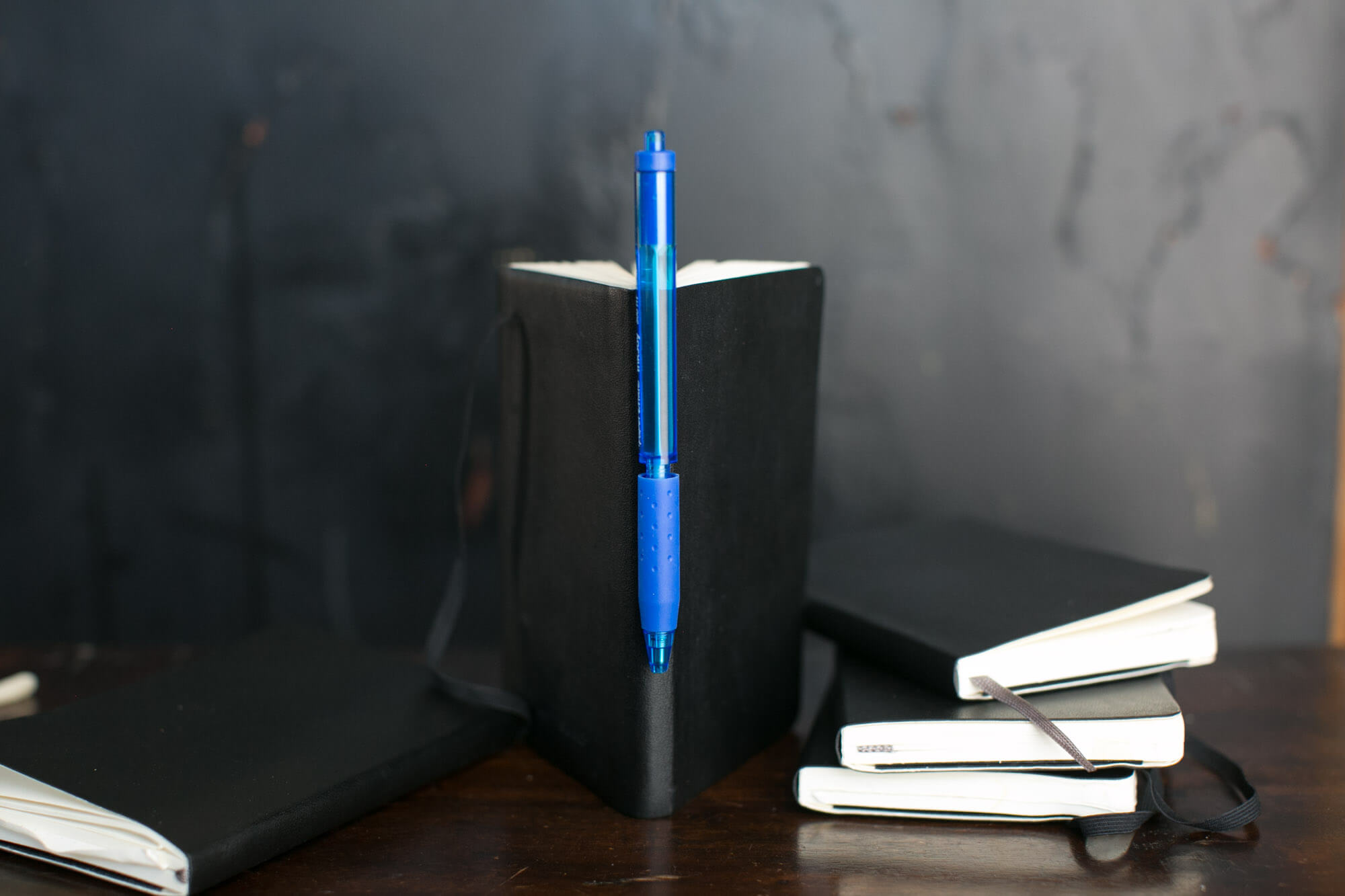
Ballpoint pens are arguably the most popular for everyday use, and for good reason. Their ink writes smoothly and dries quickly. Their refills also last longer than other types of ink. However, the oil-based ballpoint ink can occasionally get messy and blobby at the tip, making it less-than-ideal for longform writing and journaling. Conventional ballpoint pens come in three sizes: fine (making lines .8 mm wide and thinner), medium (1.0 mm to 1.2 mm) and bold (1.4 mm and wider).
Gel pens
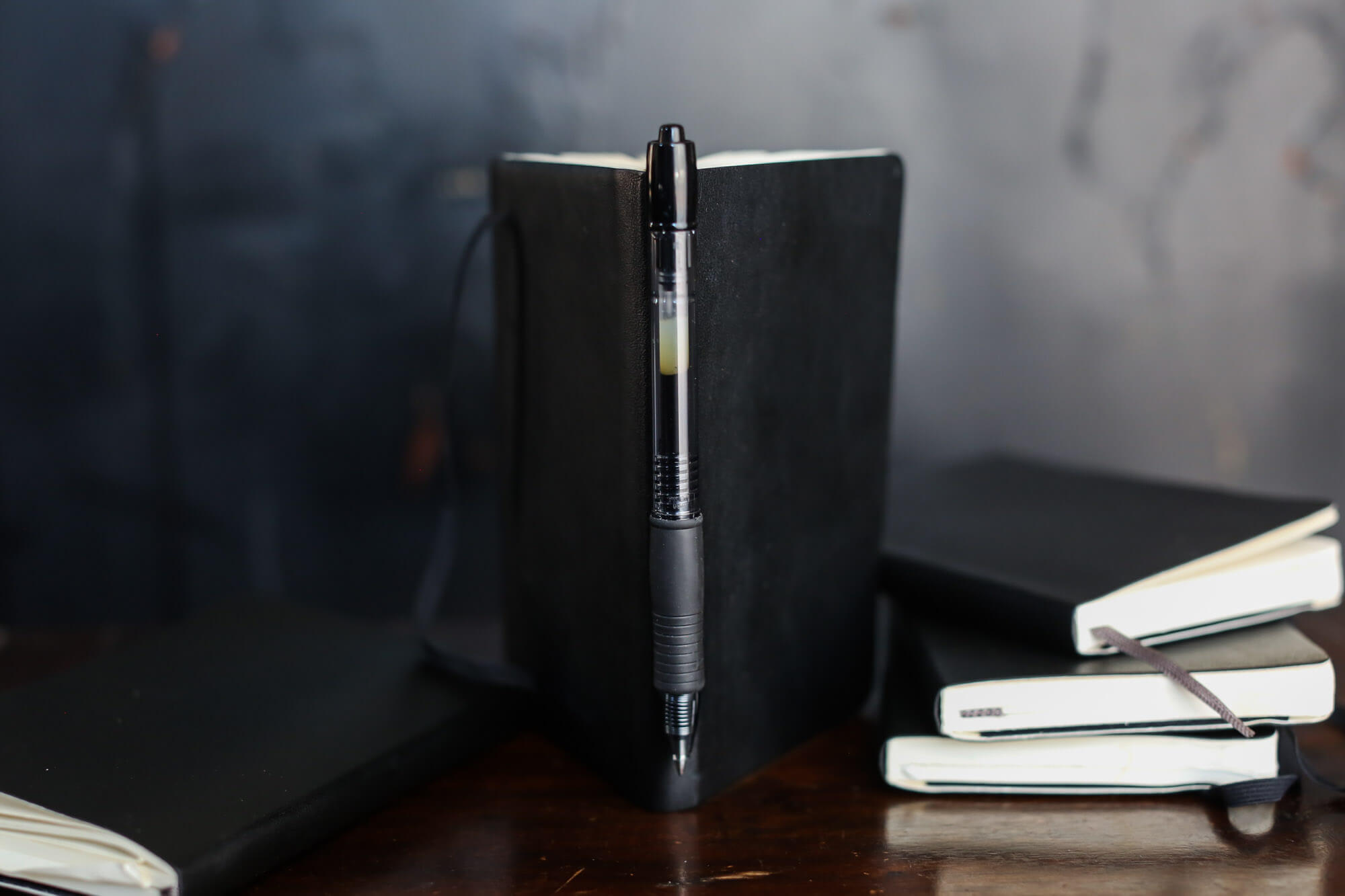
Many of us remember the thick-lined, metallic and opaque pens of our childhood, often with whimsical product names like “moonlight” and “stardust.” These type of pens get a bad rap from adults, who can see them as impractical. One of our designer-testers even specified that they’ll test “anything but gel pens, please!”
But while there are a number of youthful-looking gel pens on the market (like the Gelly Roll we tested), there are also plenty of quality, businesslike pens that you may not know use gel ink. Gel ink is simply pigment in water-based gel. If you’re looking for strong colors and sharp, featherless lines, then a gel pen is probably a great choice for you.
That being said, if you’re left-handed, you should stay away from gel. It doesn’t dry as quickly as its ballpoint and rollerball counterparts. If you want to learn the best types of gel pens for any job, see our review.
Conventional gel pens come in three sizes: micro (making lines .5 mm wide and thinner), medium (.7 mm) and bold (1.0 mm).
Rollerball pens
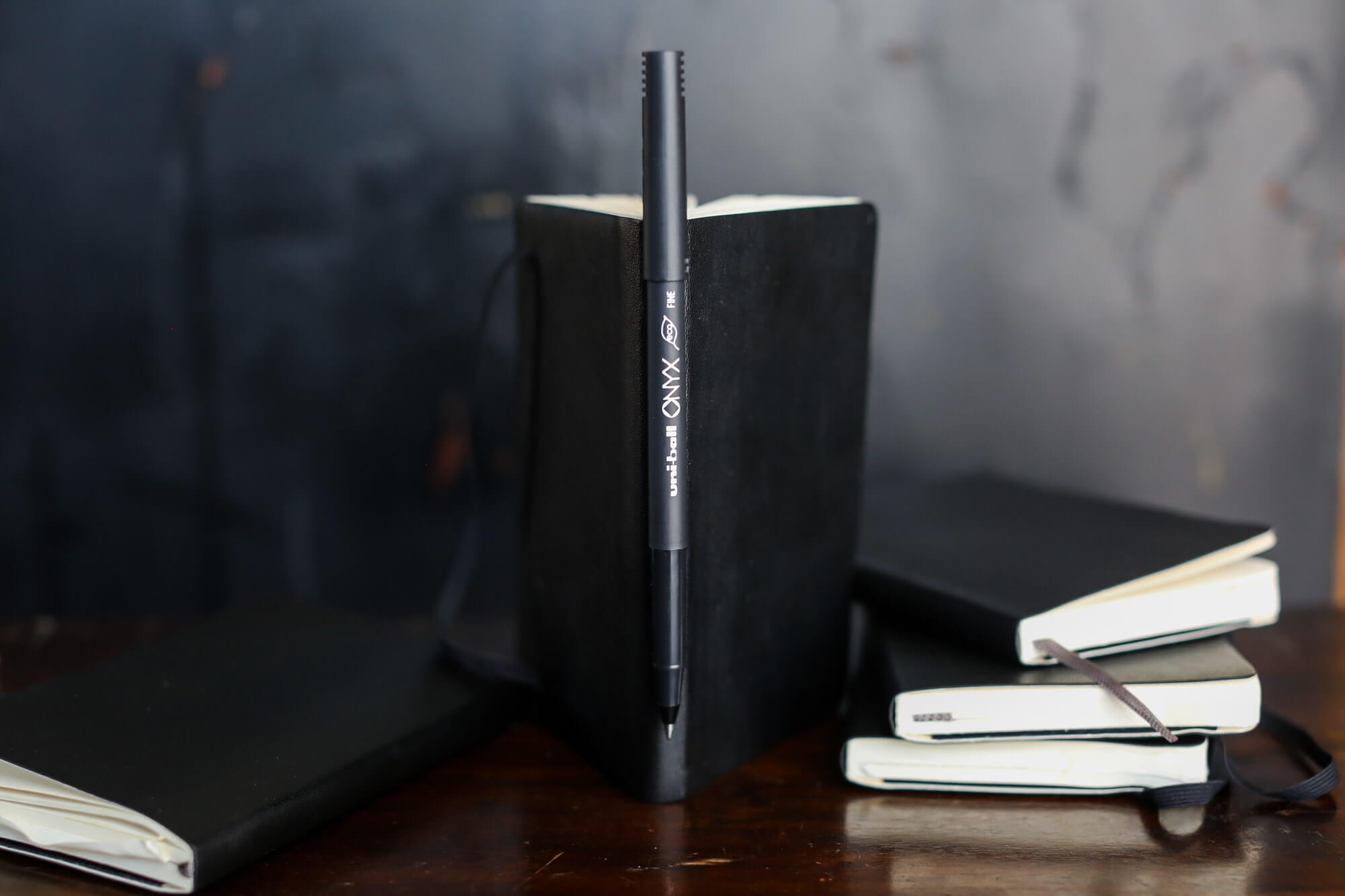
Rollerball pens use a dark, saturated, fast-flowing liquid ink. They create finer lines than a conventional ballpoint pen, and unlike gel pens, the ink dries quickly enough for left-handers. Because of the free-flowing ink, rollerball pens require less pressure, making them more comfortable to write with.
However, a rollerball’s intense ink can sometimes bleed through paper if you’re not careful, and the pen can leak if it’s left uncapped or taken to high altitudes. Conventional rollerball pens come in three sizes: micro (.5 mm), fine (.7 mm) and bold (.8 mm and wider).
Important features to consider
A pen can seem like a deceptively simple product, but there’s a lot that goes into making one great. Ask any pen aficionado and they can wax poetic about nibs and ink flow for hours. However, for the purposes of the everyday pen user, there are only a few things you need to keep in mind:
Ink flow: You want a pen that creates a clean, consistent line. It shouldn’t skip, bleed through the paper, or feather out into more tiny lines. Similarly, the ink should come out easily, requiring you to put very little pressure on the pen.
Comfort and aesthetics: The pen should look nice sitting out on your desk, but more importantly it should be designed to hold comfortably. Look for lighter pens. They will be easier on your hand than heavy ones. And don’t be fooled by pens with soft grips included on them; they’re not necessarily any more comfortable.
You can make your pen even more comfortable to hold by using it correctly. This may seem like an elementary skill, but many of us are doing it wrong (or have forgotten proper form in the age of the keyboard). Remember to:
- Press down only as much as you need to get a smooth line
- Use good posture to prevent writing fatigue
- Write from your arms and shoulders, rather than your fingertips
- Use quality paper; we tested our pens on classic Moleskine notebooks
Line width: Most pens are marketed with a millimeter measurement somewhere on the package. This measurement refers to the width of the line your pen will create. Many people enjoy writing with a .7 mm pen, which is a medium width. If you like to write with smaller letters, you can get pens in .5 mm, and some brands make them even finer than that.
If you like to make big, bold strokes, you can pick something with a 1.0 mm width or greater. Some consumers find that they like a certain brand and model of pen, but only in a certain size. So if you think a pen is a good fit for you, but you don’t quite love how it writes, try sizing up or down.
How we tested
We started by rounding up a group of designers at our content marketing agency in San Diego, and gave them each a few pens and a Moleskine notebook to call their own. In the weeks leading up to our formal focus group testing, they were encouraged to use the pens daily, whether it be for journaling, making grocery lists, signing cards or sketching out plans for the next photoshoot.
Then, we asked them to join us in a focus group, where they wrote assigned sentences (using every letter of the alphabet). Then, they had “free time” to use the pen however they pleased. After this process was complete, they filled out a survey about the experience using each pen.
The survey asked questions including (but not limited to):
- How much pressure did you have to exert on the pen to write?
- Was it comfortable to use this pen? Why or why not?
- Does the pen ink smear if you touch it soon after writing?
- What has been your overall experience using this pen?
After the focus group, we tested our worst offender and best pens on cheaper notebook and scratch paper, to see how they’d act. We found the results to be just about what we expected; lesser-quality pens wrote even more poorly on cheap paper, and good quality pens wrote about the same, save for a slightly less-smooth flow.
The best overall: Pilot – G2

Like a popular celebrity, the Pilot- G2 inspires polarized opinions. People seem to either love or hate the G2 — and we have our suspicions that some hate it just because it’s so well-loved!
When we started our testing, we didn’t know which side of the fence we stood on for the great G2 debate. (Though we always lean toward skepticism.) After testing, though, it was clear that the G2 was the best pen overall, and by default the best gel pen. Our testers loved the writing experience with this one: a smooth flow of ink with no skipping, no feathering and no bleeding. The ink dried quickly as they wrote, meaning it’s a good pen for left handers. They also noted that the G2 had a pleasing haptic feedback when you clicked it, and that it looks professional enough to use in a meeting.
The G2 is retractable, meaning you can carry it around in your pocket without being jabbed. It’s also refillable, but according to Pilot, you won’t have to refill it often. They say that their pen is “proven to last longer than the average of competitive gel ink brands.”
It’s available in four sizes (.38 mm, .5 mm, .7 mm and 1.0 mm) and comes with a comfort grip. (Though, many pen enthusiasts will tell you that these included rubber grips don’t necessarily add to the comfort.)
One thing to beware of with the G2 in finer sizes: its thin point allows you to create beautifully thin and close-together characters, but won’t mask any shakiness in your hands. So if you don’t have a steady grip (or tend to go hard on the caffeine), you may want to choose a different pen — or opt for a bolder point. If you do choose the G2 in a fine point, it should set you back less than a $1.50 per pen.
The best rollerball: uni-ball – Onyx

If you’re looking for a pen of the rollerball variety, we recommend the uni-ball – Onyx. Sleek, black and professional looking, our testers gave the Onyx high marks for its lightweight and fine tip. It doesn’t bleed or feather or skip when you’re writing with it, and it creates a nice uniform line.
The Onyx does require slightly more pressure to write with (and has a lighter-pigmented ink) than our top pick, but for the more heavy-handed writers, this may be a welcome feature.
What prevented the Onyx from being our No. 1 pick? It can smudge if you touch it too quickly after writing, which makes it non-ideal for left-handed writers. One tester also remarked that “this pen was [their] favorite … but [they] could tell it was an overall cheaper model.” We don’t consider this a fatal flaw though; at less than 50 cents a pen, it is a cheaper model.
Those who aim to be more eco-friendly will like that the Onyx is made from 80 percent post-consumer recycled electronics — a fact uni-ball is proud of, as evidenced by the “eco” logo on each pen. uni-ball says that their Onyx ink also protects against “water, fading and fraud.” However, we didn’t test for this.
The best ballpoint: Paper Mate – InkJoy
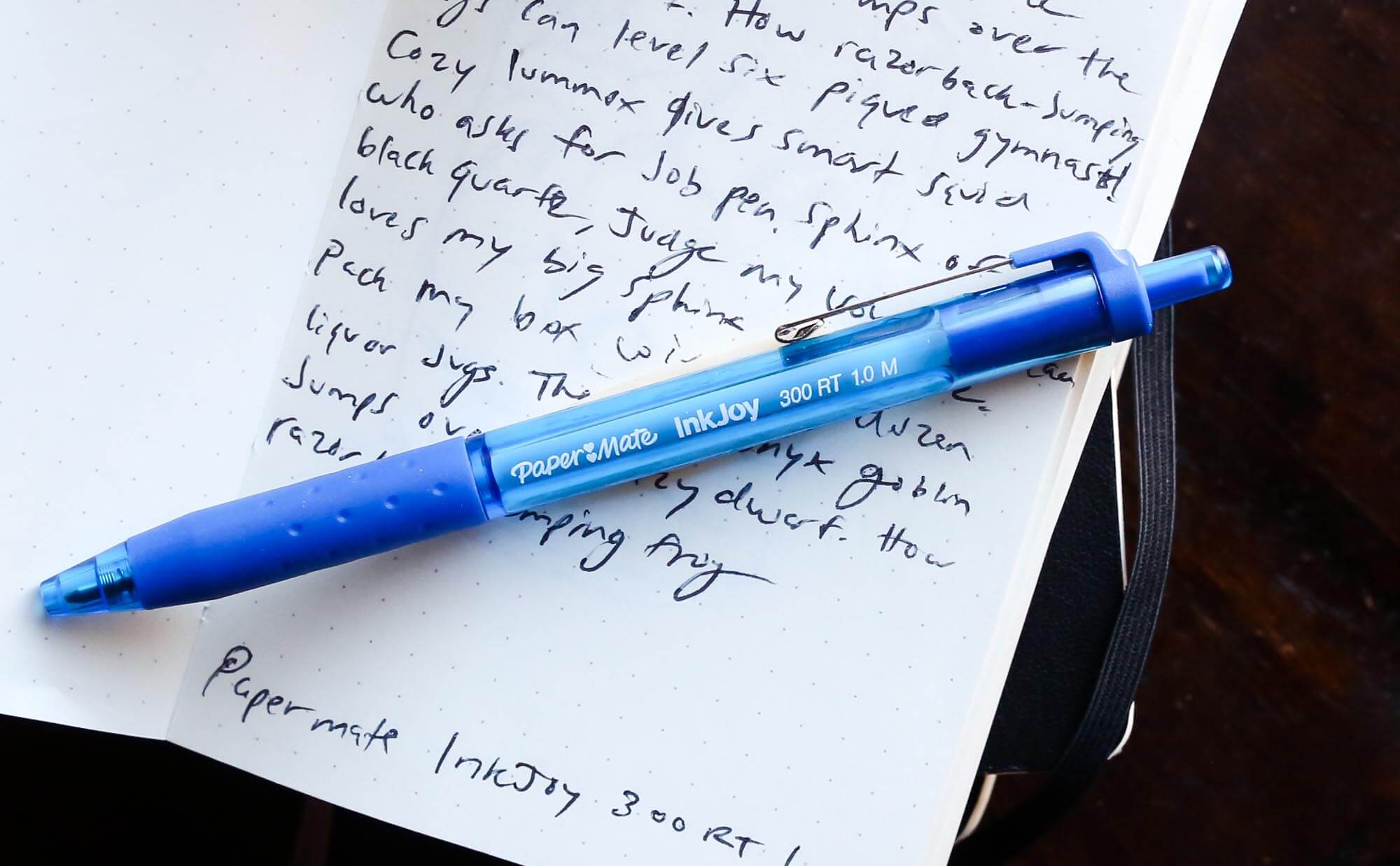
Ballpoint is the most popular type of pen, so it’s surprising that our top pick is a somewhat less popular brand. Sure, Paper Mate products are ubiquitous in the office supply world, but their pens have notably fewer reviews on Amazon — and are hardly discussed by pen enthusiasts. In the interest of diversity, we tested a few Paper Mate’s anyway, and we’re glad we did. Our testers loved the InkJoy Ballpoint.
They found that the pen didn’t bleed or feather, and it didn’t smudge either. They thought the pen’s grip was solid and comfortable, which led to nice, uniform lines. The one minor discrepancy with the Paper Mate was that each new pen requires a bit of “warming up” the first time around before it stops skipping and starts writing smoothly. At most retailers, the InkJoy will cost you well under a dollar per pen.
Other finalists we tested
Pens we recommend

Pentel – Energel-X (gel): The Pentel – Energel is another pen that most people either love or hate. We fell somewhere on the like end of that spectrum. On the plus side, it has a nice grip, requires little pressure to write with and doesn’t bleed. It creates a uniform lines and the ink flows smoothly. However, the Pentel does have a tendency to feather, and it can smear if you touch it right after writing. For these reasons, one tester claimed that it made them “write messier than [they] already do.” So, buy this one at your own risk — if you have nice handwriting and prefer a dark, saturated ink, it may still be a great pen for you. The Energel-X will likely cost you over $2, making it a little bit more of an investment than your typical office supply pen.
Zebra – F-701 (ballpoint): Zebra is an esteemed name in the world of writing utensils, and after testing their F-701, we can see why. Aesthetically, it stands out from the other pens with its sleek, all-metal body. Our testers said it felt sturdy, and they liked the textured grip. It met all the basic requirements of a good pen: no skipping, bleeding or feathering and a smooth and uniform ink flow. It also doesn’t smudge when you touch it. Our testers’ primary complaint is that the ink is relatively light in color — something you may not expect from a pen that costs over $5.
uni-ball – Jetstream Premier (ballpoint): A crowd favorite, uni-ball makes a slew of good quality pens, and the Jetstream Premier (about $7) is one of them. Testers especially appreciated some design features of this pen, namely the softened click action and large grip. The only flaws we found were that its ink doesn’t dry very quickly, and it requires a moderate amount of pressure to write.
Uni – Jetstream (ballpoint): We also liked the Uni – Jetstream: a pen with a bit of cult following. Different in design from the Premier with its thick gel grip, testers were a fan of its smudge free ink and comfortable hold. One tester noted that though it writes well, they wish the “grip was a little less squishy.” They felt like they “lost a little control with how thick it is.” One of the most expensive pens on our list, the Uni will cost you over $10 at most retailers.
Pilot – Precise V5 (ballpoint): Pilot, the makers of our best pen overall, also did a good job with the V5. Our testers loved the way this pen writes, and appreciated its uniform and even ink flow. It didn’t bleed or feather, and it required only a small amount of pressure to write. Our only gripe with the V5? It doesn’t have much of a grip, which can make it hard to hold.
Pens we don’t recommend
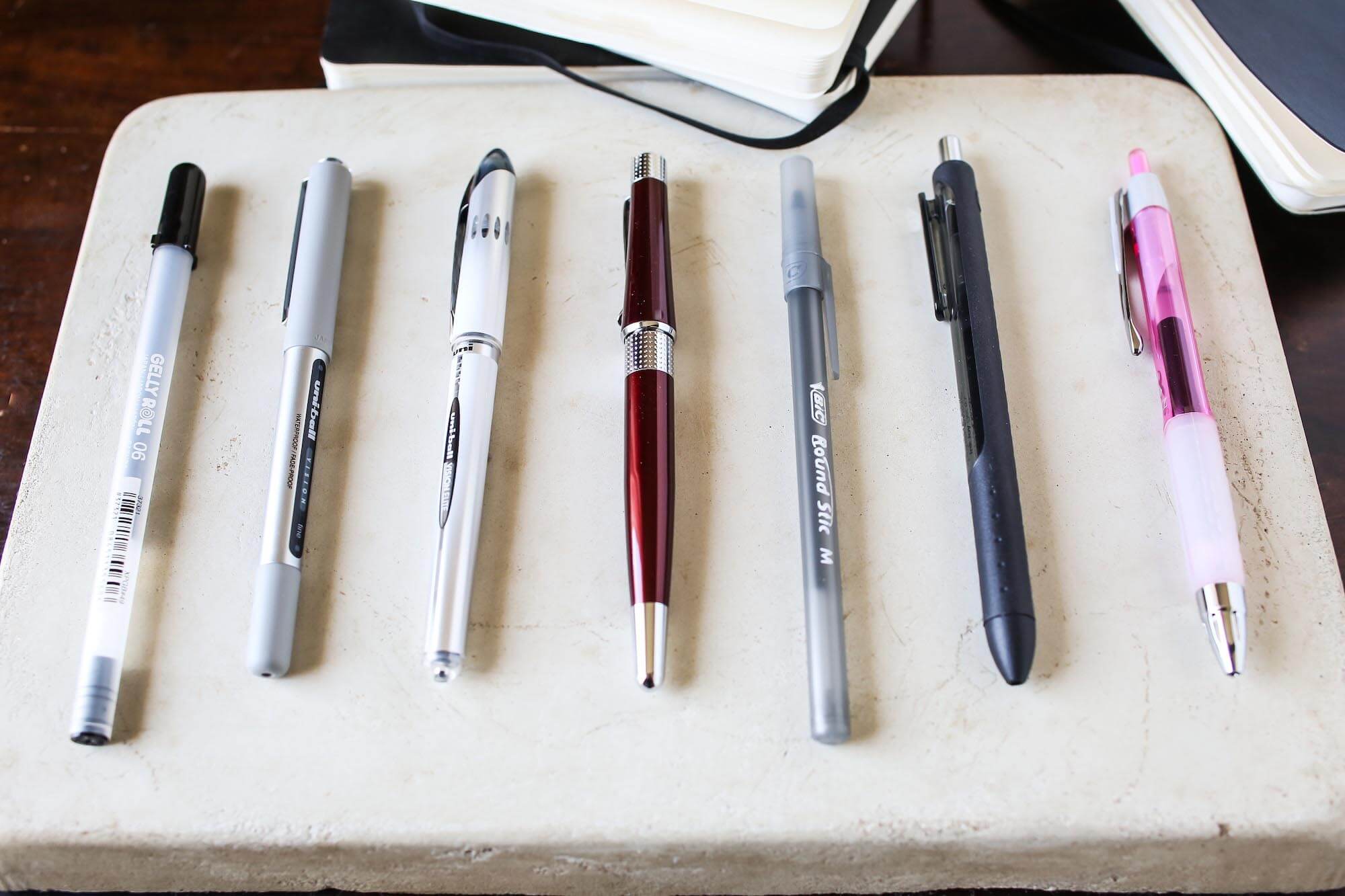
Sakura – Gelly Roll Classic (gel): Sakura makes many of the fun, glittery gel pens that added color to our childhood, so we were hoping we’d like their office-appropriate black gel pen. However, we found it very uncomfortable to write with. It also skipped more than the other pens we tested.
Cross – Beverly (gel): Cross is known for making higher-end pens that can cost as much as $10,000 (like their discontinued AT0086-107G). We tested one that costs significantly less than that; their Beverley pen rings in at about $30. Even though the Beverley is on the (very) low end of the cost spectrum for Cross, it’s still significantly more expensive than the other pens we tested. So, we expected excellent results. To our dismay, the Beverly was uncomfortable to write with, tended to feather, bleed and smudge and had a confusing design that made the cap seem like it was on backwards.
uni-ball – 207 Retractable (gel): uni-ball may be popular among writers everywhere, but they missed the mark on their 207 gel pen. Our testers found that uni-ball’s gel formula feathered and didn’t create very uniform lines.
Paper Mate – InkJoy (gel): Though Paper Mate’s ballpoint version of the InkJoy was the best in our tests, we weren’t as impressed by the gel version. We found that it feathered, bled and tended to smudge.
Bic – Round Stic Xtra Life (ballpoint): The Bic felt like a standard, uninspired office pen. It was uncomfortable to hold, required a decent amount of pressure to write with, and the ink often felt dry and uneven.
uni-ball – Vision & Vision Elite (rollerball): Both uni-ball’s Vision and Vision Elite feathered, bled and smudged. The Vision also failed to deliver a smooth flow or a uniform line.
The bottom line
A good pen can make the everyday tasks, from taking notes in a meeting to making a grocery list, a little bit more pleasant. And the good news is, they don’t have to cost you a fortune. All of our top pens cost under $5, and some of them cost under $1. If you’re looking for the perfect all around pen, we recommend the Pilot – G2 gel pen. If you need a rollerball pen, choose the uni-ball Onyx for clean-writing lines, and if you prefer the more utilitarian ballpoint style, opt for the Paper Mate InkJoy. And if you’re looking for something a little less permanent, check out our review of the best mechanical pencils.
The post The Best Pens appeared first on Your Best Digs.
]]>The post The Best Mechanical Pencils appeared first on Your Best Digs.
]]>Table of contents
- How we selected finalists to test
- Compare the best mechanical pencils
- Why use them?
- Important features to consider
- How we tested
- The best overall: Pentel – Quicker Clicker
- The runner-up: Uni-ball – Kuru Toga
- The budget pick: Paper Mate – Clearpoint
- Other finalists we tested
- The bottom line
How we selected finalists to test
To find the best mechanical pencil, we scoured forums like r/mechanicalpencil and blogs like The Pen Addict (Brad and his friends also love pencils) and Bleistift to get an idea of the pencils the obsessives like best. We also consulted Wirecutter’s and Wired’s reviews of mechanical pencils. Then, we took to Amazon to find the most popular and highly-rated pencils loved by consumers.
We mostly chose pencils sized 0.5 mm to 0.7 mm, but we also tested some larger sizes for those who like range. We know that different people are looking for different levels of quality (and “keepability”) in a mechanical pencil, so we also tested a range of price points, from around 15 cents to 25 dollars per pencil. We tested brands known for their mechanical pencils (like Pentel) and the big two technical drawing brands, as well as some traditionally cheaper brands like Paper Mate.
Compare the best mechanical pencils
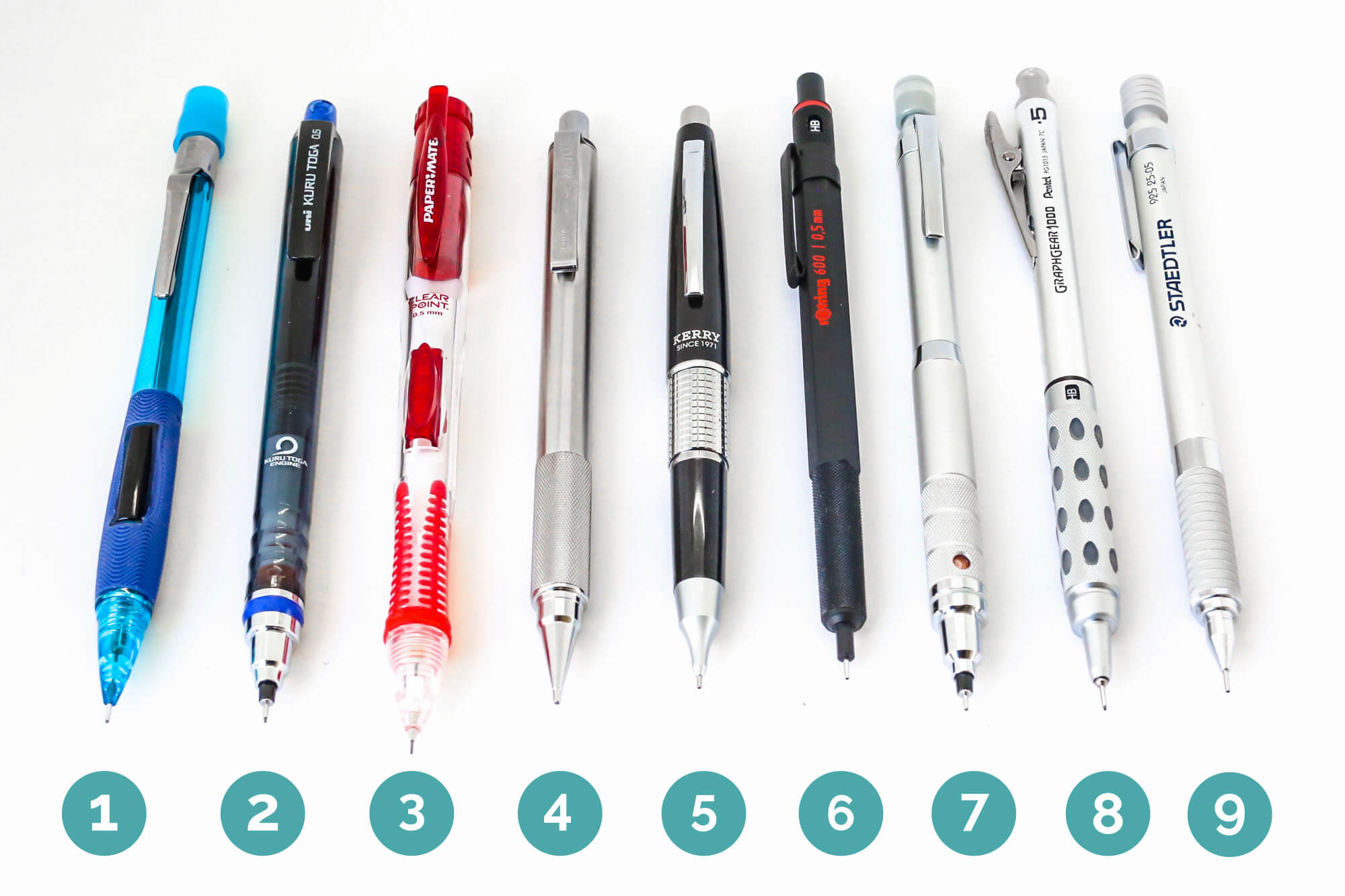
| Product + Size | Cost | Available Sizes (mm) | Features |
|---|---|---|---|
| 1. Pentel – Quicker Clicker (0.5mm) | $ | 0.5, 0.7, 0.9 | Side-click lead advance |
| 2. Uni-ball – Kuru Toga (0.5mm) | $ | 0.5 | Rotating lead mechanism |
| 3. Paper Mate – 34666PP Clearpoint (0.5mm) | $ | 0.5 | Side-click lead advance |
| 4. Zebra – M701 (0.7mm) | $$ | 0.7 | Professional grade stainless steel |
| 5. Pentel – Sharp Kerry (0.5mm) | $$ | 0.5, 0.7 | Pen-like cap |
| 6. rOtring – 600 (0.7mm) | $$$ | 0.5, 0.7 | Hexagon-shape prevents rolling |
| 7. Uni – Kuru Toga Roulette (0.5mm) | $$$ | 0.5 | Rotating lead mechanism |
| 8. Pentel – GraphGear 1000 (0.5mm) | $$ | 0.3, 0.5, 0.7, 0.9 | Chiseled metallic grip |
| 9. Staetdler – Silver Series (0.5mm) | $$$ | 03, 0.5, 0.7, 0.9, 1.3, 2.0 | Push button lead advance |
Why use them?
A good mechanical pencil can create smooth, consistent lines (without the need for sharpening). It’s convenient for travel, and is guaranteed not to stain your pocket with ink. There are plenty of studies that show that handwriting engages your brain better than typing, and some would argue that the more tactile experience of graphite on paper connects you even more to your writing.
A mechanical pencil is refillable and looks more professional than a traditional pencil. Best (and most obvious) of all, its lead is erasable. So you can leave the correction fluid in the drawer. Tradition dictates that pencils should be used for rough sketches, arithmetic, and any other time that you might need to erase or change the marks you’ve made.
A high-quality mechanical pencil will almost always cost you less than a high-quality pen. And lest style be a concern, rest assured that there are plenty of attractive (and even pen-like) mechanical pencils on the market these days.
Important features to consider
Lead size and grade: Most people will like a 0.5mm or 0.7mm width pencil (the width refers to the size of the lead and the line it creates), but there are smaller and larger widths available if you prefer. Lead can also vary in hardness, which changes the shade and the strength of the tip. If you’re a heavy-handed writer or don’t want smudging, you may want to go with a lighter and harder lead; mechanical pencils often use different grades than regular pencils so they can make the leads stronger so interpreting the grades is tricky.
Cost: Mechanical pencil costs can vary dramatically. But just like we learned testing pens, the most expensive isn’t always the best. You should be able to find a mechanical pencil you love for just a few dollars or less.
Grip: A pencil grip won’t necessarily make your pencil more comfortable to use, and some people actually find them cumbersome. But if you want a pencil with a big, squishy grip, we know the perfect one for you. Surprisingly, our testers found the grips on some of the higher-end mechanical pencils more uncomfortable — perhaps because they’re designed to keep your grasp firmly in place, but not cushion your hand.
Lead advancement: The classic mechanical pencil model requires you to click the top to advance the lead. Some newer models have a side-click mechanism instead. Others still have a twist advance. What’s best for you comes down to preference, though the idea behind a side advance pencil is that it’s quicker and disrupts your writing flow less.
Retractable vs. capped: Standard mechanical pencils are retractable, but if you want to look more polished in the boardroom, Pentel makes a capped version.
Lead cushioning: Some mechanical pencils use a lead cushion or guard that reinforces the lead against rougher writing styles. If you’re aggressive with your writing utensils, you may want to consider it.
Materials and aesthetics: Just like other writing utensils, there are an array of colors and styles of mechanical pencils available. You can get ones that resemble a pen or a conventional woodcase pencil, or you can get something bright and colorful. As a general rule, don’t assume that the quality of the pencil’s “look” is equal to how well it writes.
How we tested
We recruited the same group of illustrators, hand lettering artists, bullet journalers and designers that we used for our best pen testing to test mechanical pencils. We gave them several weeks to use the pencils throughout their everyday lives, jotting down work notes, writing grocery lists and sketching designs. For quick notes and sketches like this, our testers found that almost all of the mechanical pencils were acceptable. The one exception? The Pilot – Eno pencils, which came with lead that broke immediately upon use.
Then, we conducted a focus group in which our testers used each pencil to write assigned sentences (that used every letter of the alphabet) and doodle their own whimsical creations. After that, each tester gave detailed feedback on the experience of using each pencil. From there, we did a qualitative analysis to determine which mechanical pencil was the best.
Unsurprisingly, our testers had much stronger opinions about each pencil after being forced to write for minutes on end with each one. Also unsurprising, most feedback had to do with comfort rather than how the pencil actually wrote.
The best overall: Pentel – Quicker Clicker
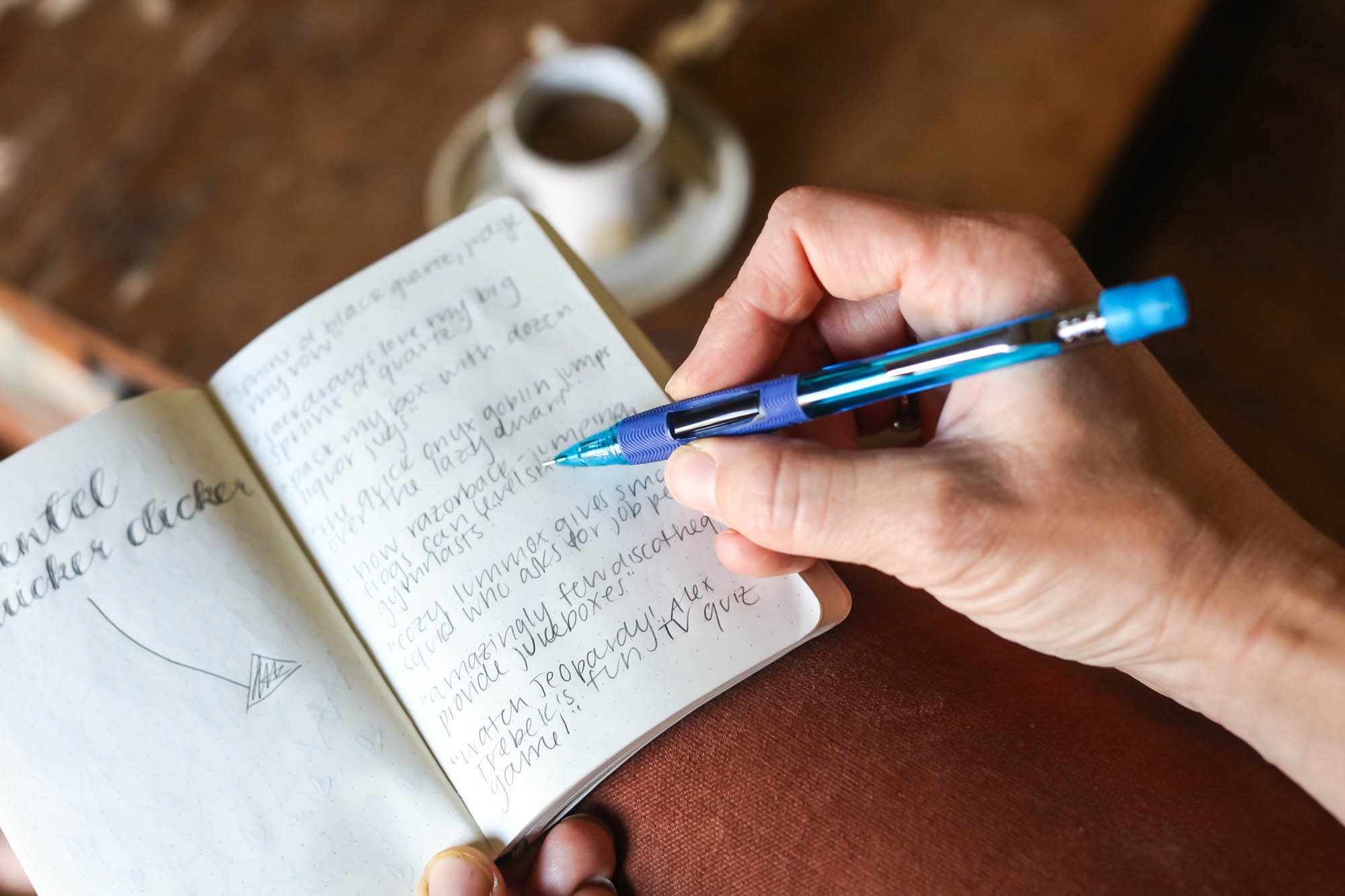
By a narrow margin, the Pentel – Quicker Clicker (0.5mm) took first place in our tests for best mechanical pencil for writing. We liked its slick design and its smooth feel, and at just a few dollars, it’s high quality for a low price. Refilling it was easy, and so was advancing the lead.
Pentel is a Japanese-held company that has been innovating in the stationery industry since the mid-forties. They’ve come up with a lot of “firsts,” including the Quicker Clicker mechanism — Pentel says it’s the “original side-advance mechanical pencil.” It comes standard with Pentel lead and eraser, a strong metal clip and a transparent barrel so you can see the status of your lead. You can purchase it in a myriad of colors, and we especially like the classy look of the sky blue.
There are many a loyal Quicker Clicker devotee out there. Unfortunately, many who have been using it for years don’t like the new and “improved” model with the rubber grip. Our testers weren’t bothered by the grip, but some didn’t like the side advance as much as a “traditional” mechanical pencil that requires you to click the top.
Top Pick: Pentel - Quicker Clicker
For a high-quality mechanical pencil at a reasonable price, you can’t go wrong with the sleek and smooth Pentel - Quicker Clicker. With smooth lead and a slick aesthetic, the Pentel - Quicker Clicker is both a joy to write with and attractive enough to leave out on your desk.
Though the Quicker Clicker has fine lead, it didn’t break when we were writing — even when used by a heavy-handed writer. It also required very little pressure to write with, which will save you from hand cramps if you’ll be writing for a while. The Quicker Clicker, which our testers described as “smooth and reliable,” comes in three line widths: 0.5mm, 0.7mm and 0.9mm. You can get its lead in the traditional graphite (No. 2 grade), or in shades of violet and blue.
The eraser on the Quicker Clicker is high quality, as far as attached mechanical pencil erasers go. In our testing and regular use, we didn’t notice a lot of residue or “smearing” left from erasing mistakes. One thing to be aware of: Some Amazon users complain that the eraser refills for the Quicker Clicker are hard to find in brick-and-mortar stores. That being said, they’re readily available online.
The runner-up: Uni-ball – Kuru Toga

Perhaps unsurprisingly, the Uni-ball Kuru Toga (0.5mm) was a standout in our tests. Uni-ball is one of the most highly regarded brands in the stationery world, and the Kuru Toga is one of the most frequently discussed (and recommended) mechanical pencils by the aficionados. We can see why. The lead is high-quality and doesn’t break when you write with it. It’s got a hardy plastic body and clear grip, and feels balanced in your hand.
Uni-ball was founded in Tokyo, so it’s no wonder that its name is Japanese. The Kuru Toga was named with a Japanese portmanteau of “rotating” and “to become sharp.” This aptly describes the pencil’s rotating lead mechanism which keeps lead, you guessed it, consistently sharp. For this reason, we think it’s one of the best mechanical pencils for writing longform.
Like with a traditional mechanical pencil, you click the top of the Kuru Toga to advance the lead, and from there it flows nice and smoothly. So why isn’t the Kuru Toga our first-choice pick? Changing the lead is a little more difficult than usual, due to the very small opening the pencil provides to insert the lead.
Even so, the Kuru Toga beats every other pick in terms of quality and smoothness of writing. And in those respects, it’s also right on par with the Quicker Clicker.
The budget pick: Paper Mate – Clearpoint
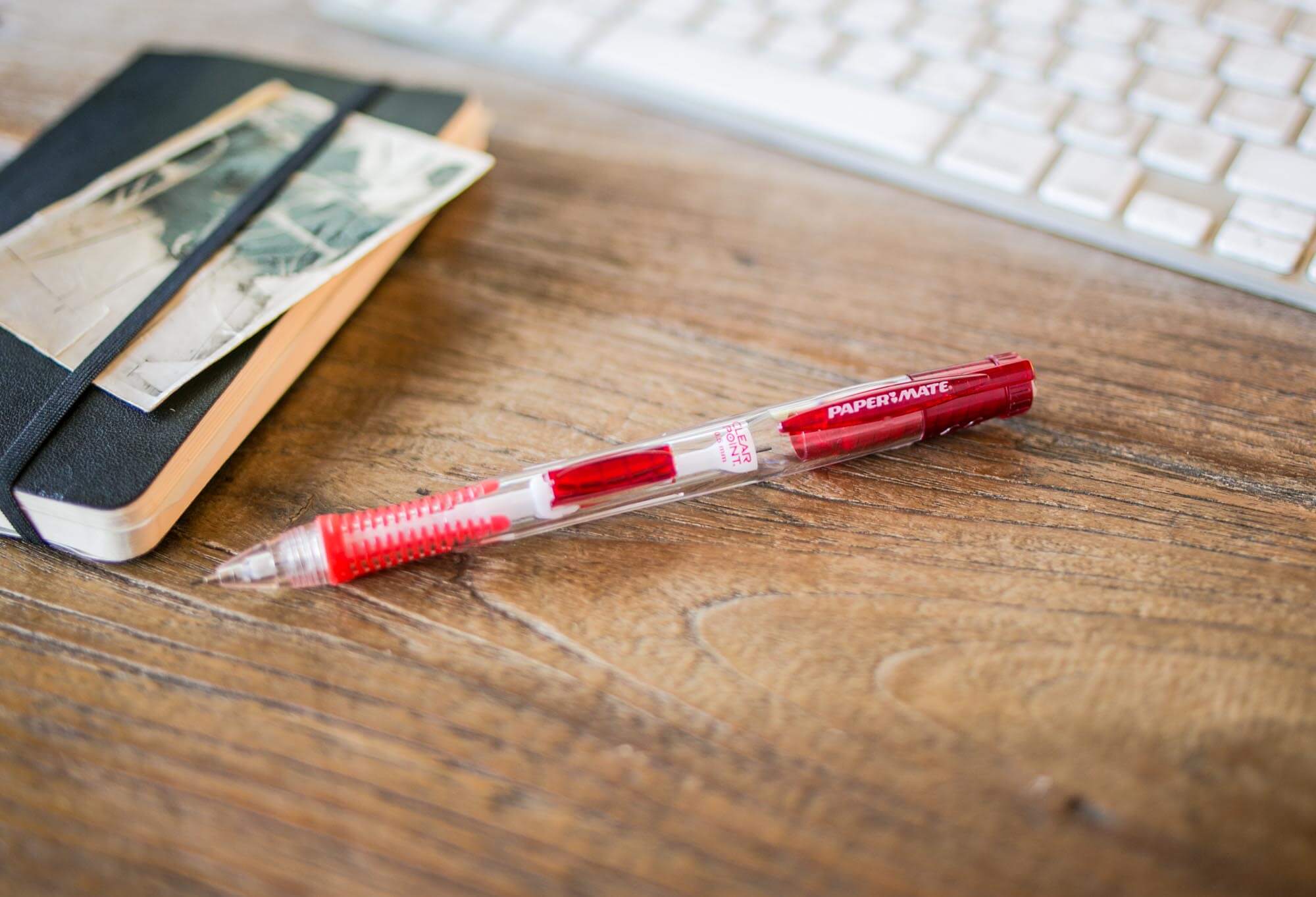
If you’re looking for something that feels good to write with, but doesn’t cause a panic if you lose it, we recommend the Paper Mate – 34666PP Clearpoint. At less than $1.50 per pencil, it delivers quality and value all wrapped up in an erasable package.
Our testers found this pencil comfortable and easy to use. One tester even went so far as to say that it was his favorite to write with — even more so than the expensive pencils. The only concern with the Paper Mate? The eraser doesn’t erase very well. But with the ubiquitous and cheap auxiliary erasers available on Amazon, we don’t consider this too big a problem. In fact, you could purchase one of these mechanical pencils and a separate eraser for less than the cost of some of the other pencils on our list.
Like our top pick, the Paper Mate requires you to click the side of the pencil to advance it. It’s got a clear barrel so you can see the status of your lead, and it has a textured grip that some users will like. It’s worth noting that this one also comes in a colored pencil version with an array of rainbow leads available.
Others finalists we tested
Pencils we recommend

Zebra – M701: Zebra is a big name in writing utensils, and we’re generally impressed with their products. The M701 is not an exception. It’s got the weighted, smooth feel of a high-quality pencil and it encourages neat handwriting. Plus, while the grip isn’t smooth, it also doesn’t dig into your hand. The Zebra lost points because it felt especially heavy, which can tire your hand out over time. Still, some writers may prefer a weightier pencil. At over five dollars, it’s more expensive than most of our pencil picks, but we also think it’s one of the best quality mechanical pencils out there.
Pentel – Sharp Kerry: There’s no doubt that the Quicker Clicker is the best Pentel mechanical pencil, but the Sharp Kerry is probably the classiest. It looks exactly like a capped pen until you remove the cap and see its point. Some testers found it a bit slippery and hard to hold on to. Nonetheless, it can’t be beat for its sophisticated look, and when all is said and done, it writes well.
rOtring – 600 Series: This is a classic design that has an avid following among designers; we’ll call the rOtring a luxury mechanical pencil. At more than 25 dollars, it’s certainly an investment. As we would hope, it performed well on almost all accounts: smooth, break-free lead and controlled writing included. If you want a pencil that doesn’t get in the way when you’re using a stencil or ruler, this is a great pick. The only thing we didn’t like was the tiny hole you’re forced to fit the lead through when you refill it. It’s a minor complaint, but for a pencil this expensive, we expect near perfection. The rOtring comes pretty close.
Uni – Kuru Toga Roulette: Similar to our runner up, but with an upgraded metal body and knurled grip. Our testers found the Uni – Kuru Toga Roulette to be “light and efficient” and an overall joy to use. There’s not much to pick on with this pencil — we love its performance. This is a good thing, since one will cost you about ten dollars. If we had to pick something to dislike, we’d say the eraser on this pencil is a little small.
Pentel – GraphGear 1000 Automatic Drafting: Our testers found the GraphGear 1000 to be delightfully “futuristic,” and they also liked that the top clicks into place like a pen when you advance the lead. It’s nicely weighted (not too heavy or too light) and writes well and smoothly. The only downsides? Some testers found the lead filling process a little cumbersome and the lead itself a little weak.
Staedtler – Silver Series: A pencil with the name “Silver Series” (and a price point of over ten dollars) invites some big expectations, and for the most part the Staetdler didn’t disappoint. It’s available with an extra-sharp 0.3mm size and writes precisely and smoothly. Like the rOtring, this is a technical pencil well-known among architects, planners, and designers. Our testers’ biggest complaint with this pencil was the grip; most found it somewhat uncomfortable. If you’re not writing longform content though, this pencil might still be for you.
Paper Mate – 1.3mm Mechanical Pencils Paper Mate markets these as an alternative to the traditional woodcase pencils, and they do look like a fat and colorful version of the original. The 1.3mm are targeted toward young children who are just learning to write — the larger width of these utensils makes them easier for little hands to control. However, there were plenty of user comments from full-grown adults who love these pencils and the thick lines they create. Are they right for you? It comes down to taste. Most of our testers found them very comfortable to write with.
Pencils we don’t recommend
BIC – Xtra Sparkle: With a name like “Xtra Sparkle,” we didn’t expect this BIC to deliver high-octane pencil performance. Still, with nearly 2,000 Amazon reviews, we had to give it a go. Unsurprisingly, it was sub-par in almost every way. When asked to describe it in two words, one tester said “meh” and “whatever.” For quality, we give this one a 50 percent. For jazzing up your kid’s pencil box? A solid 100.
Pilot – Color Eno: The Color Eno are the only “colored pencils” we tested, again due to their high number of reviews. Their primary tester, a designer, actually loved their hues. However, he found that the lead broke easily and that the pencils were overall “not super reliable.”
Pentel – Sharp Automatic: The Sharp Automatic is another pencil that probably lands somewhere in the “meh” and “whatever” zone. It doesn’t stand out for much except its uncomfortable grip and the distinctive way it makes you feel not-in-control of your own writing.
Pentel – Twist Erase: The Twist Erase has a cool name, but the lead is too light, thick and dull. Our testers found that you have to press harder than is comfortable to use it. Another complaint: It doesn’t allow for very good control of your writing.
Pentel – GraphGear 500: We loved the GraphGear 1000, but its little brother didn’t make the same impression. We found the 500 to be dull and fragile, with lead that breaks too easily and a lead changing process that’s too time-consuming. This one isn’t worth paying over five dollars for.
Alvin – Draft-Matic: The Alvin, another “luxury” pencil at over ten dollars for one, disappointed us. It’s sleek and cool looking, but it’s uncomfortable to hold, it’s too hard to change the lead and it made our writing uneven and scratchy.
The bottom line
We tend to treat mechanical pencils like they’re disposable, but really, a good one should last you a long time. For one you’ll want to keep around, we recommend the all-around impressive Pentel – Quicker Clicker. If for some reason you can’t get your hands on that one, the Uni-ball – Kuru Toga is also a good bet. And if you do want one you can treat like a disposable, then choose the Paper Mate – 34666PP Clearpoint. It’s great quality for a very low price.
The post The Best Mechanical Pencils appeared first on Your Best Digs.
]]>The post The 12 Best Steam Irons appeared first on Your Best Digs.
]]>Table of contents
- The 12 steam irons we tested
- Best overall: Rowenta – DW5280 Focus
- Also great: Singer – Steam Logic Plus
- Budget pick: Mueller – MU-77X
- How we selected
- How we tested
- Important features to consider
- How do steam irons work?
- The bottom line
The 12 steam irons we tested
| Product | Price | Soleplate Material | Temp. Control | Wattage |
|---|---|---|---|---|
| Rowenta - DW5280 Focus | $$ | Stainless steel | Dial | 1725 |
| Singer - SteamLogic Pro-770 | $$ | Ceramic | Button | 1775 |
| Mueller - MU-77X | $ | Stainless steel | Dial | 1500 |
| Oliso - Pro TG1600 Smart Iron | $$$$$ | Stainless steel | Dial | 1800 |
| Rowenta - DW5080 Focus | $$ | Stainless steel | Dial | 1700 |
| Beautural | $$ | Ceramic | Button | 1800 |
| Panasonic - NI-W950A | $$$ | Aluminum | Dial | 1700 |
| Panasonic - NI-L70SRW Cordless Iron | $$ | Stainless steel | Button | 1600 |
| Sunbeam - Steam Master GCSBSP-201-FFP | $ | Stainless steel | Dial | 1400 |
| BLACK+DECKER - Digital Advantage Pro (Discontinued) | $$ | Stainless steel | Digital | 1500 |
| Maytag - M400 (Discontinued) | $$ | Stainless steel | Dial | 1500 |
| T-fal - FV4495 Ultraglide (Discontinued) | $$ | Ceramic | Dial | 1725 |
Best overall: Rowenta – DW5280 Focus
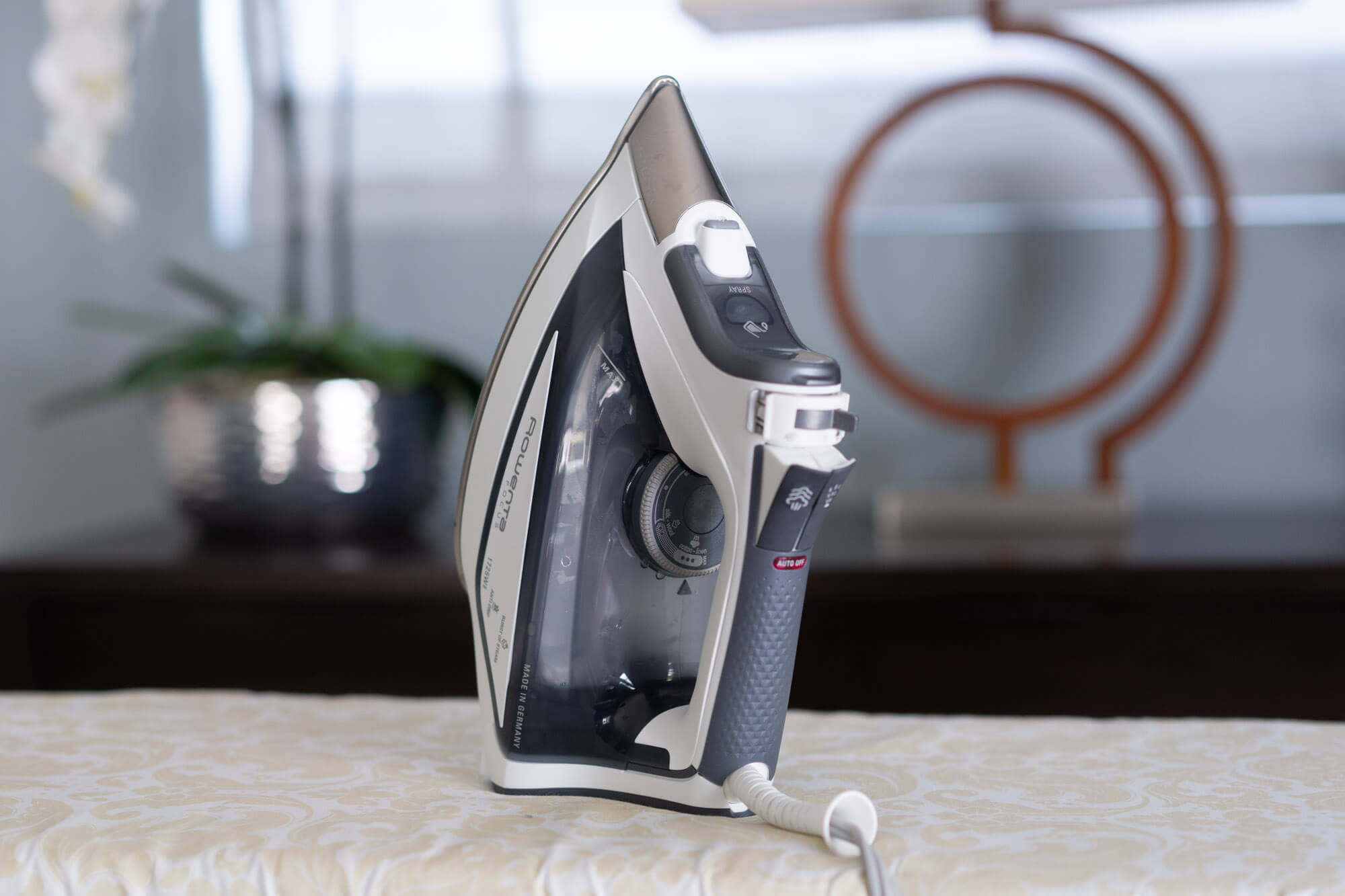
Our former top pick, the Rowenta – DW5080, has been upgraded to the Rowenta – DW5280 Focus, and although it wasn’t as strong a contender this time around as the previous model, it’s still an excellent iron for heavy-duty ironing. Of the four new irons we tested for this 2022 update, the DW5280 was by far the easiest to fill. The iron was designed to be filled lying horizontally, and the extra-wide water-filling inlet makes it a breeze, whether filling with a cup or simply straight out of the faucet. It was also easy to see the maximum fill line since the water tank is see-through. (This wasn’t always the case with the other irons we tested.)
This model has a laser-etched stainless-steel soleplate with Rowenta’s patented Precision Tip for getting into corners and buttonholes. The iron stands very sturdily upright at a slight angle, so the handle fits ergonomically into the palm of your hand when you’re ready to lift it. Most impressive is its steam burst, which was the most powerful of the other irons tested and most effective at steaming wrinkles before and during ironing.
The DW5280 has an even steam dispersion but it didn’t seem to emit much steam, so we used the steam burst throughout. The iron has a very fine spray mist that didn’t spit and spatter, but although the Rowenta doesn’t leak, droplets occasionally drip out of the spray hole. The DW5280 heats up in a minute, and when it hits the desired temperature, an orange preheating light goes out. We would have preferred a more overt ready alert because it’s not really clear whether the light is a temperature alert or an indication that the iron is on.
The solidly constructed iron has a good weight so we didn’t need to press heavily or re-do areas. Overall, as with the previous model, the Rowenta – 5280 Focus relieves the burden of ironing and helps you get it done faster.
Key takeaways:
- The Rowenta – DW5280 Focus has a robust steam output that results in quicker and more efficient ironing.
- Its patented Precision Tip helps navigate around the collar, cuffs, and buttonholes of a shirt.
- The iron is designed, engineered, and manufactured in Germany.
Also great: Singer – SteamLogic Plus-770

Another worthy alternative to the Rowenta – 5280 is the Singer – SteamLogic Plus-770. This steam iron does have a couple of quirks, but overall it has more pluses than minuses. The Singer has a horseshoe-shaped ring of LED lights for four levels of heat that light up when the touchscreen power button is pressed. It hits the maximum temperature in one minute, and the ready alert beeps and the LED ceases flashing when the iron is hot enough.
Although this alert system is clear to see, one of the major bugs with the Singer is that the power button is located on the iron body exactly where your forefinger knuckle rests. Simply by gripping the iron’s handle, it’s much too easy for your knuckle to accidentally turn the iron off.
The Singer is easy to fill horizontally with the included well-designed pitcher, but like the Mueller, it’s hard to see the water level because the water tank is dark gray. When standing vertically, the Singer’s steam burst is unimpressive, but when holding it horizontally while ironing, the burst is strong. It also had excellent steam dispersion, and wrinkles were ironed out in a single pass. The Singer is leak-proof but every now and then a drop would emit from the spray.
This steam iron has an extra-long 12-foot cord but has no internal storage. Although the long cord was great for maneuvering around the ironing board, there is the issue of wrapping it up for storing the iron. The Singer has good weight without being too heavy and didn’t require much pressing down. It doesn’t have a precision tip, so it wasn’t good with corners and buttons, but generally, the Singer had very good glideability and coverage.
Key takeaways:
- The Singer – SteamLogic Plus-770 heats up quickly and has a very visible and audible temperature-ready alert.
- It has an extra-long power cord that’s great for maneuvering around the ironing board but it does require more storage space.
- The iron’s on/off and temperature set button are easy to accidentally turn off while ironing.
Budget pick: Mueller – MU-77X
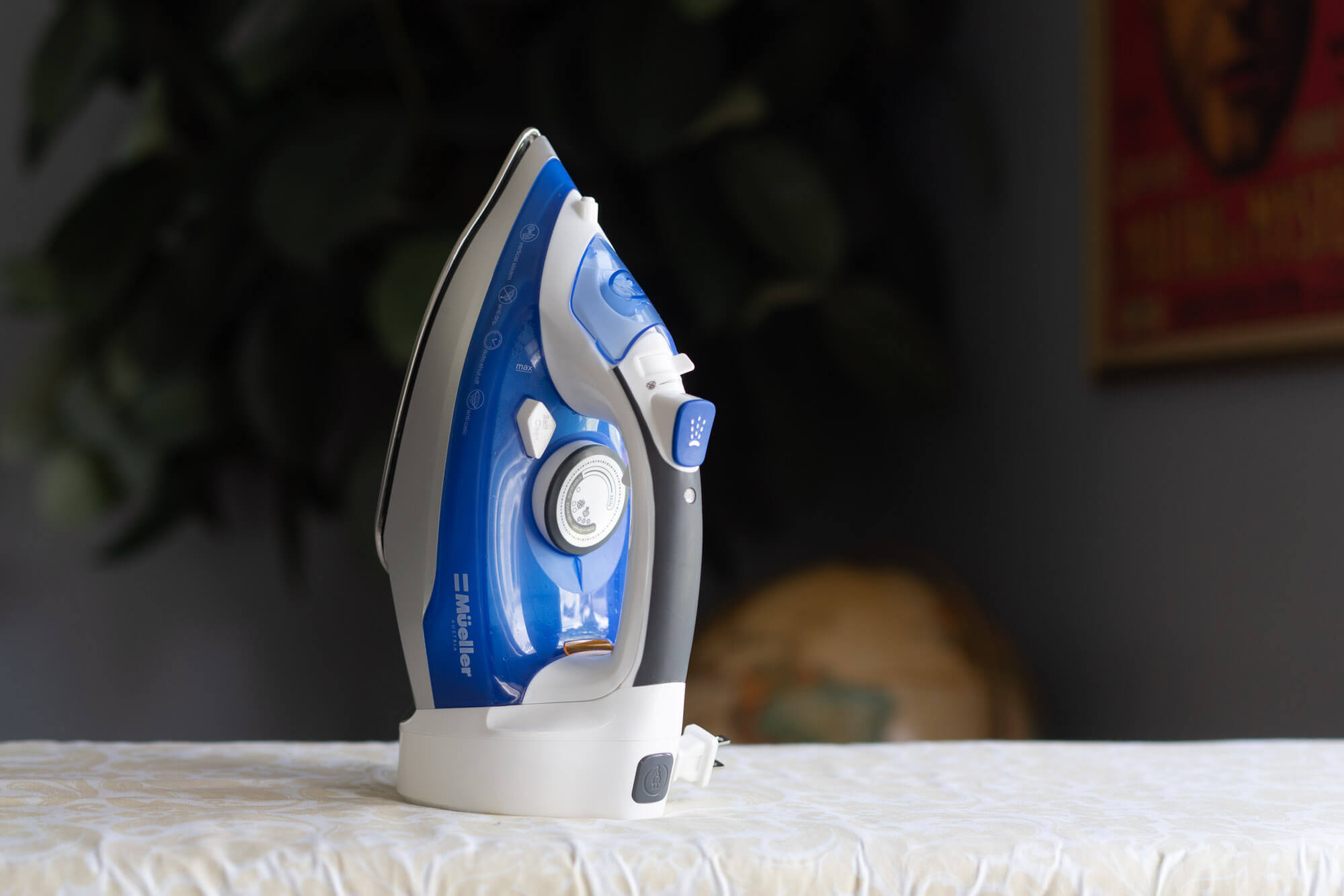
Mueller is another German company that’s well known for its kitchen appliances, and they score another hit with the incredibly affordable Mueller – MU-77X steam iron. The Mueller has some of the same attributes as the Rowenta. The iron can be filled horizontally, and though its water portal is slightly smaller (about the size of a dime), it was easy to fill without spilling directly from the faucet or with the included 200 ml water pitcher. The one issue we had is that the water tank is dark blue, and it was tricky to see the water level inside unless we tilted the iron at an angle. A big bonus, though, is that the Mueller is 100% leak-free.
The MU-77X has a slim profile and its soleplate has a precision tip just like the Rowenta. The Mueller heated up to high in only 50 seconds, and its orange temperature-ready alert light is easy to see because it’s offset against the dark blue water tank. Its steam burst wasn’t as robust as the Rowenta’s, but nevertheless, it shot out plenty of steam when we needed it. We also liked the steam burst trigger located under the handle exactly where your forefinger rests, so it was easy to squeeze. Steam dispersion was excellent, and we only needed to iron in one pass for deeply creased wrinkles.
The Mueller has a standard 8-foot power cord, but it was the only iron we tested for this 2022 update that had a retractable cord, which gets stored inside the iron by simply pushing a button. With all of its bells and whistles — and high performance — it’s surprising how inexpensive this iron is. It’s quite lightweight, so it may not be suited to heavy-duty ironing like the Rowenta, but for occasional ironing and quick touch-ups, the Mueller – MU-77X is a great budget choice.
Key takeaways:
- The Mueller – MU-77X has superb steam production and dispersion that’s even better than our top pick.
- Its water tank is easy to fill without spilling directly from the faucet, but its fill line is hard to see.
- This steam iron is lightweight and glides swiftly over all fabric types.
Best for crafters: Oliso – Pro TG1600 Smart Iron
Oliso – Pro TG1600 Smart Iron deserves special mention as an iron designed for creative types. It’s the most high-tech and forward-thinking of all the finalists with its unique innovations. Its construction and engineering are high-quality, well-executed, and on-par with our top pick, Rowenta.
Its most unique feature is its “iTouch Technology,” which enables touch sensors to mechanically lift the iron up when not in use to prevent burning and scorching of fabrics. With crafters and creators at the forefront, this feature is wonderful for those who need to multi-task and or work with sensitive fabrics. It works surprisingly well, speaking to its overall high-quality design.
In a line-up, its soleplate design also stands out. While stainless steel is notorious for sticking to crafting materials like transfers, Oliso overcomes this shortcoming by adding a textured surface. This solution gives us the benefit of higher conductivity of stainless steel without the usual stickiness. Ceramic would typically be the better choice for crafting and synthetic fabrics, but it has its own flaws of color transfer in higher temperatures and rubbing off over time. Oliso’s unique stainless steel soleplate gives us the advantages of both stainless steel and ceramic without their drawbacks.
Key takeaways:
- The Oliso – Pro TG1600 Smart Iron was specially designed for crafters, sewers and quilters.
- Its stainless steel soleplate is textured and has flat, minimal holes designed to work with transfers and adhesives.
- Oliso’s patented “iTouch Technology” is a clever feature that lifts the entire iron once it senses there is no movement, which makes it great for super sensitive fabrics or multi-tasking.
Beautural (not recommended)

The Beautural steam iron is a popular budget-priced choice, but it was the only iron for this 2022 update that we can’t recommend. Design-wise, it’s a bit of a mess. The iron has an LCD screen for denoting temperature levels, and though it’s certainly bright, when the iron is standing up vertically, you can’t actually see the screen unless you tip the iron forward. Its steam burst was the lowest of the other irons we tested, and its spray is too heavy and spits.
Spitting was also a problem when using the steam while ironing: Lots of drops spattered onto the fabric that we had to iron over. The steam button is too hard to press, and the on/off controls on either side of the LCD panel are confusing. The water port is tiny, and the tank is tricky to fill, even with the included (and pretty useless) filling cup. If you’re looking for an inexpensive iron, go with our budget pick, the Mueller – MU-77X.
Panasonic – NI-W950A
Panasonic’s second entry, the NI-W950A earned a #2 ranking on Consumer Reports and with good reason. It went neck to neck with our #1 pick, earning just a few points less. Though it’s the only iron with an aluminum soleplate within our finalists, the material difference was not noticeable in our iron testing. As with Rowenta, it performed very highly in steam output and is generally well made.
The soleplate’s unique shape, advertised as “Multi-directional” was an interesting feature that could be useful for those with more intricate ironing. The back of the plate comes to a point exactly like the front in a football shape.
Panasonic – NI-L70SRW Cordless Iron
For those wondering about cordless irons, Panasonic’s NI-L70SRW entry does a solid job. You might expect the heat and steam to be weak, but it really did not disappoint here. The biggest drawback is that it loses steam a little sooner, but we believe that it’s enough for regular use.
In general, this iron is well designed, engineered, and constructed. Controls are thoughtful and simple, and instructions are easy to understand. The main difference in function from corded irons is that you return the iron to the base instead of standing it on the heel when you make adjustments to your garments.
This model has a removable water reservoir, which means you can go to the sink to refill with tap water while leaving the iron in the base to charge. This also means that the heating element stays farther away from running water.
Most Amazon user reviews were favorable, expressing a similarly pleasant surprise at its strength. Some note that this iron is great for the elderly because of its lighter weight. It is also popular among those who need to iron for hours at a time.
Sunbeam – Steam Master GCSBSP-201-FFP
This Sunbeam iron represents the best of lower-budget irons and rightly so. Though the cheapest in price, it performed almost as well as the T-fal model which cost almost twice the amount.
The Sunbeam looks and feels more “budget,” but it has many of the same features as irons that are double, triple, quadruple, etc. in price (sevenfold for the Oliso model). In fact, the retractable cord is an added feature that none of the others have in-unit. The execution of this feature is almost there. The retracting button is too harsh, requiring attention to the receding end. However, the effort pays off with not having to deal with a long, dangling cord in storage.
Discontinued steam irons we tested
Rowenta – DW5080 Focus (discontinued)
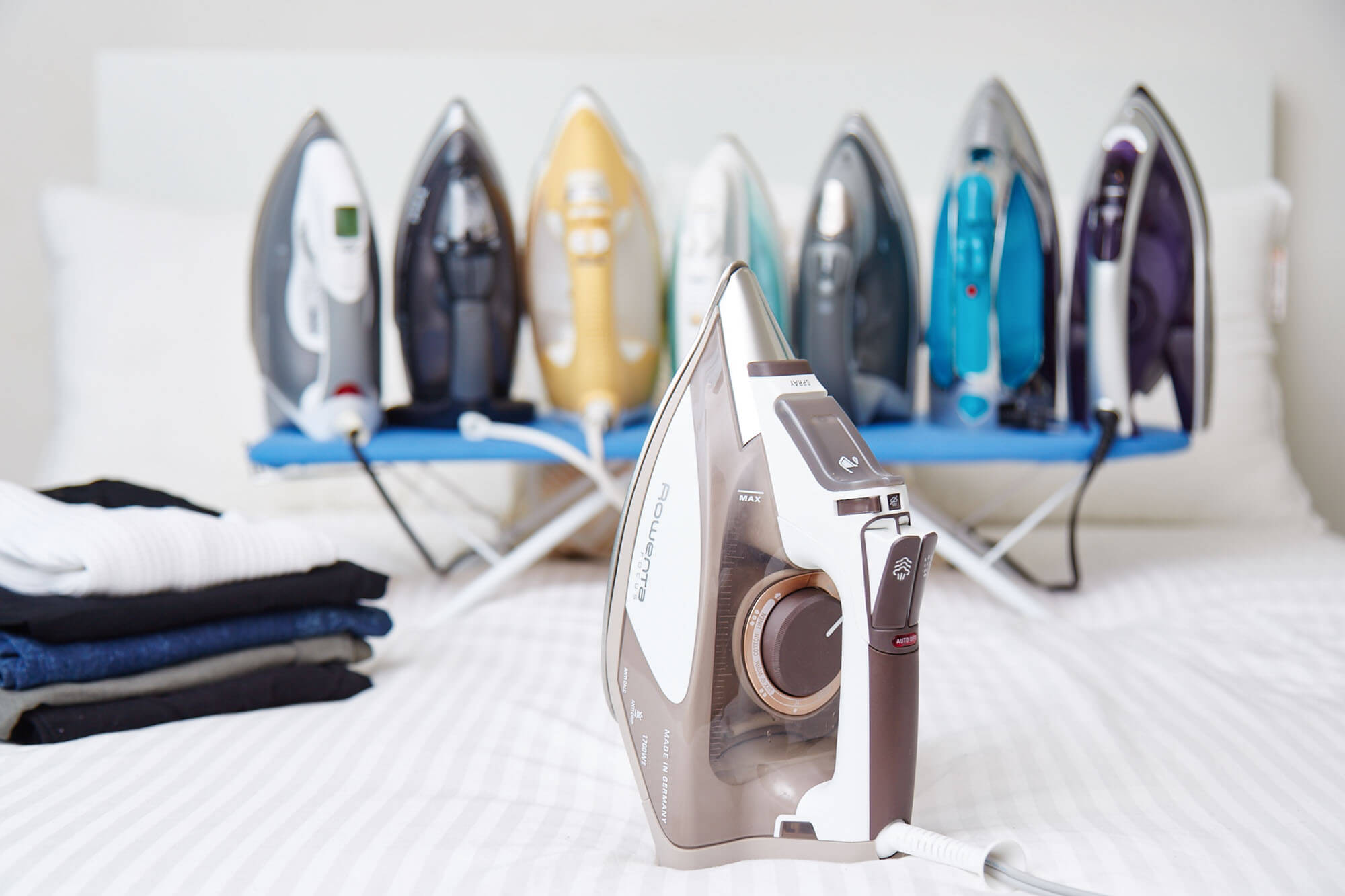
The Rowenta – DW5080 Focus had been our previous top pick, but it was recently upgraded to the Rowenta – DW5280 Focus. Our original review praised this model for its manual design, ironing and steam performance, and cleanup. It has a median price — not the cheapest and not the most expensive — but a sensible investment that can potentially save some time in the long run.
As a renowned name in irons since 1919, Rowenta boasts a long history of manufacturing home appliances. Paired with German engineering, the Focus steam iron achieves a superior feel from every button and dial, down to the soleplate. Unlike many irons, the DW5080 is manufactured in Germany, unlike the rest that are made in China.
Its “Precision Tip” soleplate design proved to be a simple yet effective innovation. While maintaining a sturdy, wide base that felt solid and substantial, the tapered tip allows for more nimble navigation around buttons and collars.
The Rowenta comes with a plastic water-filling cup, which worked well with its own filling spout, making water-filling a tidy no-brainer. The spout even has a slight spring-loaded action, which snaps in nicely when shut. The steam and spray buttons have a satisfying deep plunge action that doesn’t stick as it did with some of the other irons we tested.
Maytag – M400 (discontinued)
A long-trusted name in home appliances, Maytag’s M400 is a solid, if not unremarkable steam iron. It’s named the “Speed Heat Iron” and in that respect, it does not disappoint. It’s the fastest heating iron by six seconds. The box claims 55 seconds, but we clocked it in at 1 minute 3 seconds.
We liked that the water filling position is down flat, reminding you to unplug it before refilling. The water-filling hatch is easier to access because it’s more stable to hold than at an angle.
Steam output, however, is a weakness here, with the area of steam burst just a bit smaller than other top performers. It unsurprisingly struggles as a vertical steamer, not unlike the rest. Leak tests show below average results, leaking a little bit during the silk ironing test.
T-fal – FV4495 Ultraglide (discontinued)
The Ultraglide iron highlights its unique feature: a ceramic soleplate. Typically made of aluminum coated with ceramic, this material is best suited for ironing synthetic fabrics due to its resistance to static electricity. Natural fibers like cotton and wool can possibly rub off in high heat.
Ranking #4 on Consumer Reports, it fared satisfactorily in our testing. We weren’t too impressed by the instruction manual, which we found a little confusing and set in small type. However, it excelled in heating speed, only six seconds behind the fastest, clocking in at 1 minute 9 seconds to maximum heat.
Other quirks, like difficulty filling water and the fact that the “Ultraglide” was not so “ultra” knocked its grades down. The relatively smaller soleplate (which likely aided in quicker heating) leaves your hand closer to the steam, which may get slightly uncomfortable.
It performs notably well with continuous steam. This in combination with its relatively lighter weight makes the T-fal more practical as a vertical steamer.
BLACK+DECKER – Digital Advantage (discontinued)
BLACK+DECKER – Digital Advantage Professional is the best lower-priced alternative to the Rowenta. The digital interface is very simple, but well-implemented, including a feature that we think should be included in all steam irons: an audible beep to indicate that it’s ready to use.
In general, the technology behind steam irons remains quite basic and simple in comparison to all the wireless, voice-command, smart-appliance doodads out there. We have simple circuits that turn voltage to heat up a conductive soleplate. It’s almost comical that having a very basic digital readout is the crowning feature of this iron, but it does the job well and scores high in usability.
The Digital Advantage excels in one aspect we were baffled to find lacking in the others: “Temperature-ready” status going from higher to lower settings. The Oliso is the only other iron that does this but at a price that’s more than four times that of the BLACK+DECKER. The BLACK+DECKER’s alert is audible, which is more user-friendly than the Oliso to boot. Like the other finalists, Oliso’s temperature light switches off and on to indicate “ready” status. This works but is easily overlooked, requiring you to keep a close eye on the iron.
Another advantage to note is that the BLACK+DECKER is the only iron that doesn’t need to be emptied of water after each use. This is a boon for those who are always in a rush and rely on every spare second. Every other finalist emphasizes the need to be emptied or else risk build-up that would require extra time and care to clean. This is a great plus in our book. It’s a wonder why they don’t make this feature more prominent!
How we selected
We started by collecting the top-rated and reviewed items from retailers such as Amazon, Bed Bath & Beyond, and Target. A simple Google search revealed topics and concerns from relevant blogs and subreddits for obsessives like /r/BuyItForLife. Further digging revealed niche markets and hobbyists: in our case, crafters, quilters, and sewers.
We spoke to experts and professionals, like Nichole Ramirez, quilter and co-author of The Fussy Cut Sampler, who provided a deeper insight into the demands and needs of those who use steam irons comprehensively. Fashion designer Deanna Molina gave us insight into what she looks for in an iron.
Amateur reviews by real people on YouTube rounded out our sample group as we determined the most desired features in steam irons: heat-up speed, steam output, anti-drip, and safety. With these features in mind, we narrowed down our vast list to a concise but diverse group of finalists.
From there, we developed a rigorous routine of tests designed to address various issues like delicate fabrics, tough fabrics, water leakage and ease of use and storage. Considering speed and convenience, we also looked carefully at product and interface design from the process of filling up water to how the cord functions in operation and storage.
How we tested
Heating speed
| Product | Time to Max Temp (in seconds) | Heating Speed | Temperature Ready Alert |
|---|---|---|---|
| Rowenta - DW5280 Focus | 64 | ★★★★★ | ★★★★ |
| Mueller - MU-77X | 50 | ★★★★★ | ★★★★★ |
| Singer - SteamLogic Pro-770 | 61 | ★★★★ | ★★★★★ |
| Oliso - Pro TG1600 Smart Iron | 88 | ★★★ | ★★★ |
| Rowenta - DW5080 Focus | 75 | ★★★★ | ★★★★ |
| Beautural | 45 | ★★★★★ | ★★★ |
| Panasonic - NI-W950A | 86 | ★★★★ | ★★★ |
| Panasonic - NI-L70SRW Cordless Iron | 63 | ★★★★★ | ★★★ |
| Sunbeam - Steam Master GCSBSP-201-FFP | 97 | ★★★ | ★ |
| BLACK+DECKER - Digital Advantage Pro (Discontinued) | 76 | ★★★★ | ★★★★★ |
| Maytag - M400 (Discontinued) | 113 | ★★ | ★★★ |
| T-fal - FV4495 Ultraglide (Discontinued) | 69 | ★★★★★ | ★★★★ |
To test heating speeds, we timed how long each iron heated up to its maximum temperature (typically the linen and or cotton setting). This category takes both speed and usability into account for optimum efficiency.
We also considered how the iron indicated that it was ready to use, either by a light or sound. More discreet alerts may go off unnoticed, which may result in waiting longer than necessary. For instance, the Maytag has one light that simply shuts off when the iron has reached the set temperature. Some irons, like the Rowenta and T-fal do the same, except the indicator light is dedicated only to this purpose which is clearer. Others like Oliso and Panasonic – NI-L70SRW Cordless Iron have indicator lights that share other duties for indicating on/off or auto-off.
BLACK+DECKER – Digital Advantage Professional stands out here: Although it was not the fastest (13 seconds behind the fastest, Maytag), its digital dial with audible “beep” was the most user-friendly, which frees you from keeping an eye on the iron while you wait. Most notably, the Black+Decker was one of two brands that also indicated correct set temperature when going from higher to lower temperatures, the other being Oliso – Pro TG1600 Smart Iron.
When ironing multiple items, being able to switch temperatures without guesswork plays into overall efficiency and usability of the iron. Without any sort of indication, Sunbeam falls to the bottom in this category. It’s up to you to wait for two minutes, as the manual suggests. To be fair, it is the most inexpensive iron of our finalists, roughly seven times less than the most expensive (Oliso).
By our measurements, Sunbeam took about 1 minute 37 seconds to reach its max temperature, just ahead of the slowest, Panasonic – NI-L70SRW Cordless Iron, which clocked in at 1 minute 53 seconds.
With all irons heating up in under two minutes, we found that how the irons were designed to indicate a “ready” state was equally as important.
Steam output tests
| Product | Steam Burst | Steam Dispersion | Vertical Steam Performance | Ease of Water Filling |
|---|---|---|---|---|
| Rowenta - DW5280 Focus | ★★★★★ | ★★★★ | ★★★★★ | ★★★★★ |
| Mueller - MU-77X | ★★★★★ | ★★★★★ | ★★★★ | ★★★★★ |
| Singer - SteamLogic Pro-770 | ★★★ | ★★★★ | ★★★ | ★★★★★ |
| Oliso - Pro TG1600 Smart Iron | ★★★ | ★★★ | ★ | ★★★ |
| Rowenta - DW5080 Focus | ★★★★★ | ★★★★★ | ★★★★ | ★★★★★ |
| Beautural | ★★★ | ★★★ | ★★ | ★★★ |
| Panasonic - NI-W950A | ★★★★★ | ★★★★ | ★★★ | ★★★★ |
| Panasonic - NI-L70SRW Cordless Iron | ★★★★ | ★★★ | ★★ | ★★★★ |
| Sunbeam - Steam Master GCSBSP-201-FFP | ★★★ | ★★★ | ★ | ★★★ |
| BLACK+DECKER - Digital Advantage Pro (Discontinued) | ★★★★ | ★★★ | ★★★ | ★★★ |
| Maytag - M400 (Discontinued) | ★★★★ | ★★★★★ | ★ | ★★★★★ |
| T-fal - FV4495 Ultraglide (Discontinued) | ★★★★ | ★ | ★★★★ | ★★★ |
Steam is the jelly to heat’s peanut butter. They work okay on their own, but together they really excel. On a particularly wrinkly swatch of thick cotton, a dry iron can only get you so far. A couple of puffs of steam speed up the process considerably. Among the most-desired features of irons, we tested steam output in the following subcategories:
Steam burst: A feature of most new steam irons that shoots out a puff of steam from the soleplate. We graded the amount of steam and consistency from consecutive bursts.
Ease of use: Steam button and dial feel and responsiveness and general ease of use.
Steam dispersion: How well steam is dispersed and general functionality of steam during ironing.
Vertical steam: Another method of removing wrinkles by holding the irons upright and subjecting the fabric to steam without the pressure and contact of the heated soleplate. We graded the functionality of this secondary feature.
Ease of filling water: An important aspect of using steam, grading the design and functionality of the water intake.
Electronics and water don’t mix, so it’s up to each brand to design an experience that is both safe, easy, and minimal in drippage. We started by filling each iron with water to capacity. Irons that have tricky hatches, hard-to-read “max” lines, or just feel plain awkward can be difficult or uncomfortable to use. The last thing we want is to iron atop a damp board or have to wipe off the counter afterward.
Oliso and Rowenta delivered top scores in water filling scores. They both came with plastic water filling cups well suited to their respective filling spouts. Both were remarkably drip-free on the first try. BLACK+DECKER and Maytag included identical filling cups, which were difficult to pour without spilling.
Panasonic – NI-L70SRW Cordless Iron deserves special mention as it has a removable water reservoir that can be accessed even as the iron recharges. Since you can fill it under the sink, there is no worry about spillage.
Next, we graded the power of each iron’s steam bursts. This feature now comes standard on nearly every contemporary steam iron; the functionality is identical to one another. A button atop the handle has somewhat of a hydraulic action that pushes extra air through the steam. The extra burst of steam adds extra wrinkle-busting power where it’s needed, stubborn cotton or linens, especially.

To grade steam dispersion, we graded both continuous steam output and steam bursts on the highest heat setting. BLACK+DECKER, Maytag, and Sunbeam models fell short here because the steam burst function got uncomfortably hot on the handle with repeated use. On the other hand, the Rowenta impresses again with a forceful steam burst that also felt well-controlled and dispersed.
Each one of our finalists lists vertical steam as a feature, but we found that they were all not well-suited for this task, and some were worse than others. This feature hopes to double its function as both a heavy iron and a steamer used on hanging clothing. It’s best left to dedicated steamers which have a lightweight hose end with an easier to press button. Here, the user must press and or pump the same steam burst button in order to output usable steam.
With all the weight of an iron without the advantage of pressure, their use as a vertical steamer is pretty dubious. We concluded that if you really have to use one, steam irons might somewhat work as a vertical steamer. If this is an important feature for you, definitely stick to either Panasonic – NI-W950A or Rowenta.
Overall, Rowenta wins in overall steam output with Panasonic – NI-W950A not too far behind. Despite being cordless, Panasonic – NI-L70SRW Cordless Iron surprised us in strength, coming in third. It suffered low marks as a vertical steamer because it did have trouble with leaking during continuous use.
In fact, all of the steam irons start leaking water at some point due to continuous usage of steam burst. By nature, steam and especially steam bursts push water vapor which cools down the soleplate. Eventually, the soleplate and water aren’t hot enough to vaporize. Oliso addresses this issue in their instruction manual, stating that the user must wait three seconds between every steam burst.
Safety tests
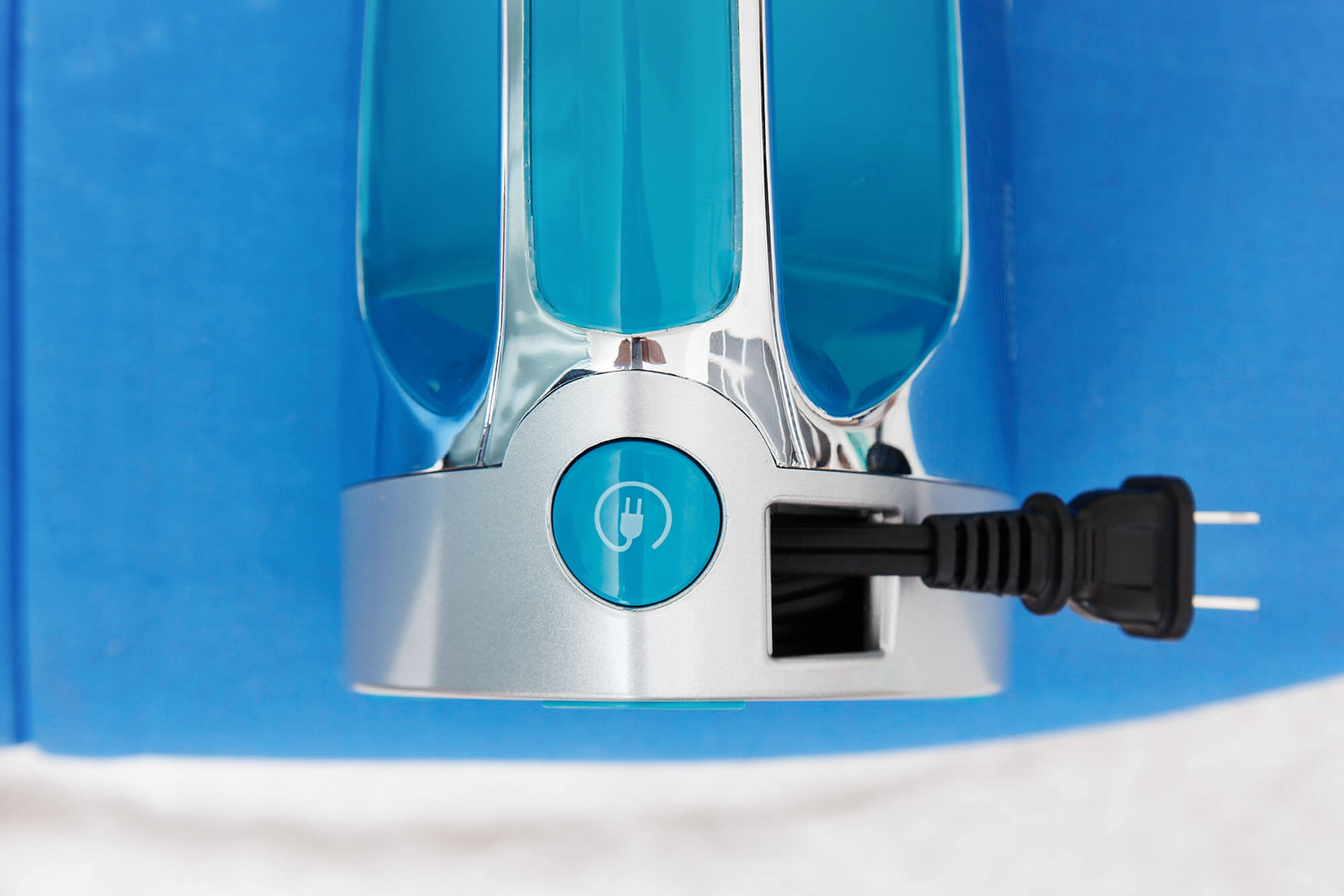
The ubiquity of steam irons might cause you to forget that it is a high-watt appliance that can cause serious damage without caution. Fortunately, the automatic safety features mostly come standard now. Design and construction also contribute to the overall safety of steam irons. We took a look at a few subcategories and graded each for effectiveness and quality:
Stability on heel: We applied some force in different directions to determine the stability and balance of each iron while standing on the heel.
Cord design: A crucial point in design with steam irons. We grade how well it stays out of the way, how it packs for storage, and its overall quality.
Auto shut-off: Some irons have multi-way auto shut-offs, safeguarding your fabric and your home from scorching or fire.
Overall construction: Considering metal and plastic parts near high heat and high-wattage electrical heating elements, quality construction is a must. We graded the overall feel and construction of each iron.
As far as stability while standing on its heel, all of the irons were great. From our lowest price to our highest, all of them scored top marks. By the feel of stability, they all felt like high-quality irons that were weighted and balanced well.
When it came to cord design, Panasonic – NI-L70SRW Cordless Iron was our favorite. Its charging base had a nice retractable cord that worked well and cleaned up easily. As for the iron itself, there was no cord to contend with, meaning high mobility and lightness.
Rowenta edged out the other finalists with Oliso and T-fal not far behind. These three had small hooks to help wrap the ends of a cable to itself, making things a little easier and tidier.
While retractable cables are a great usability feature, the Sunbeam was a little difficult to use. It was a common negative comment among Amazon reviews, and we agreed. The release button was too fast and forceful, which made retracting the cable more of a hassle than it should be. It’s liable to cause minor injury if allowed to snap back without manual guidance. Otherwise, once it’s retracted, it’s nice and easy to store with no danger of tripping or getting pulled by the wire.
In general, all finalists had well-designed cords that were strong and effective at staying away and being hardly noticeable. A feature we are happy to see standard now is a ball-bearing joint that attaches the cable to the iron.
Auto shut-off features varied with each model but its goal is common: prevent burns. All finalists performed as expected. Maytag, Rowenta, Sunbeam, and T-fal scored best marks for having multi-way auto shut-off with visual indication.
Oliso takes auto shut-off to the next level with a feature that lifts the iron up when it senses it’s stopped moving. Though impressive, it was almost too responsive, lifting at any hesitation, which caused some dragging on the fabric of the lifters when moved again. Luckily there is an on and off switch to disable this feature.
For overall construction, Oliso and Rowenta impressed us the most. With easy-to-press buttons and an overall professional and well-engineered feel, we believe they would last longer and be less likely to fail mechanically.
In total, it’s Rowenta again, followed by Panasonic – NI-L70SRW Cordless Iron and T-fal / Oliso in a tie for third as our top safest irons. Thankfully, the rest of the finalists rank average or above.
Performance tests
| Product | Overall Ease of Use | Interface Design | Shirt Iron Test | Linen Iron Test |
|---|---|---|---|---|
| Rowenta - DW5280 Focus | ★★★★★ | ★★★★ | ★★★★★ | ★★★★ |
| Singer - SteamLogic Pro-770 | ★★★★★ | ★★★ | ★★★★ | ★★★★ |
| Mueller - MU-77X | ★★★★★ | ★★★★★ | ★★★★ | ★★★★★ |
| Oliso - Pro TG1600 Smart Iron | ★★★★ | ★★★★ | ★★★ | ★★★★★ |
| Rowenta - DW5080 Focus | ★★★★ | ★★★★ | ★★★★ | ★★★★ |
| Beautural | ★★★ | ★★★ | ★★★★ | ★★★★ |
| Panasonic - NI-W950A | ★★★★ | ★★★★ | ★★★★ | ★★★★ |
| Panasonic - NI-L70SRW Cordless Iron | ★★★★ | ★★★ | ★★ | ★★★★ |
| Sunbeam - Steam Master GCSBSP-201-FFP | ★★★★ | ★★★★ | ★★★★ | ★★★★ |
| BLACK+DECKER - Digital Advantage Pro (Discontinued) | ★★★★ | ★★★★ | ★★★★ | ★★★★ |
| Maytag - M400 (Discontinued) | ★★★★ | ★★★★ | ★★ | ★★★ |
| T-fal - FV4495 Ultraglide (Discontinued) | ★★★★ | ★★★ | ★★★ | ★★★★ |
In a series of performance tests, we put our finalists through the real test: ironing different types of fabrics. We took the following criteria into account:
- General ease of use – A culmination of good design and construction.
- Interface design – We grade the functionality of parts and features and how they affect overall usability.
- Ironing samples – Real samples of fabrics to test the variable temperature settings and steam in action: Cotton, silk and linen.
- “Glideability” – Smoothness of soleplate while in use.
- Ease of clean-up and storage – We measure the ease of emptying water and putting the iron away.
BLACK+DECKER was a favorite in interface design, with its easy-to-read digital screen and audible beep indicating it’s ready. The compact and easy-to-use and read dials of Sunbeam and Oliso are our favorites of the dial types.

Maytag and Panasonic – NI-W950A suffered from poorly designed dials, which were hard to read. The arrows indicating selected choice were not immediately obvious. While using the Maytag, we accidentally moved the dial, switching the fabric option to linen from cotton. The dial on the Panasonic got noticeably hot during use.
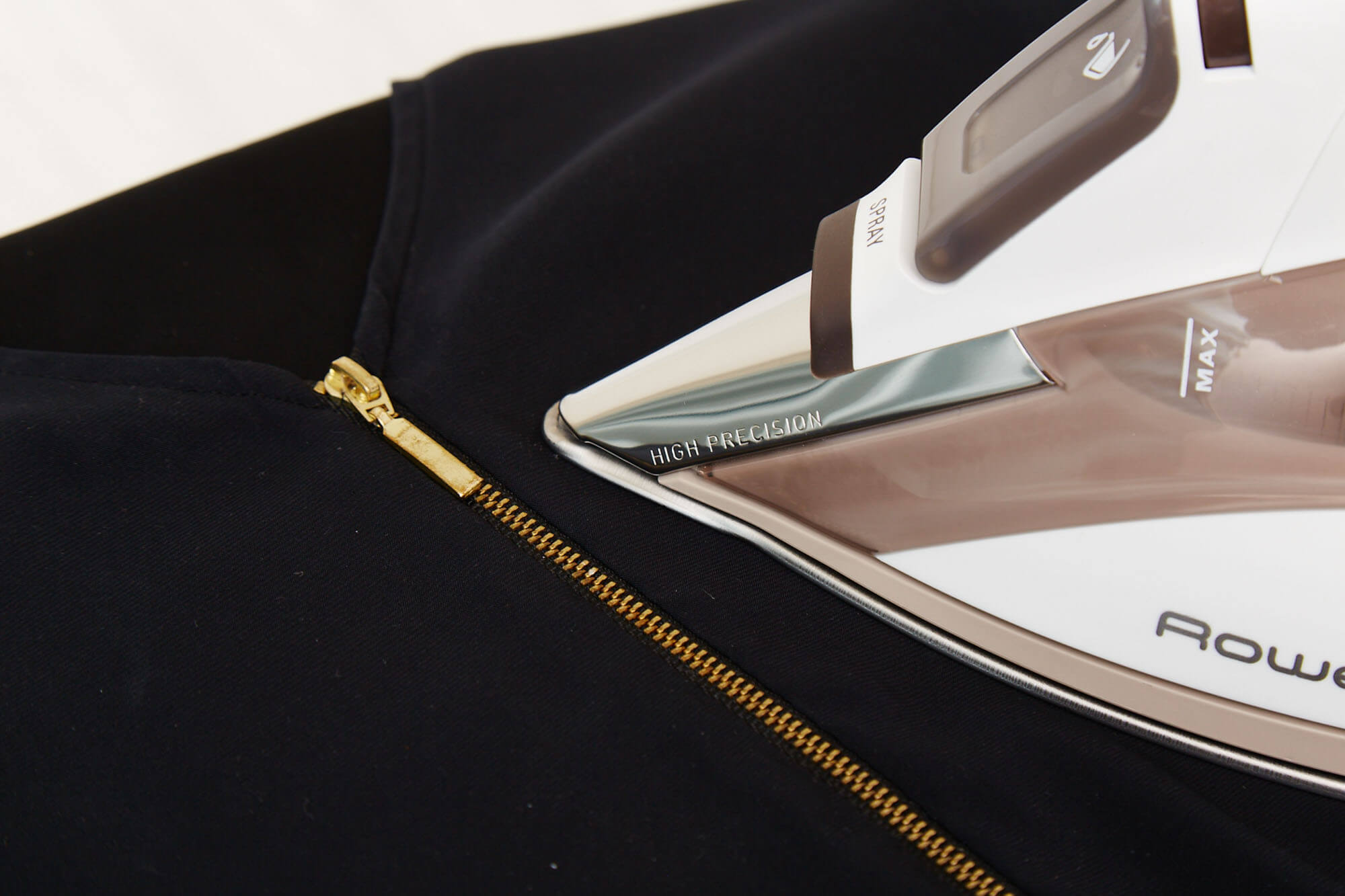
One aspect we were eager to test was claims made by different brands, especially of their soleplate. Rowenta is known for its “Precision Tip,” a slight tapering towards the tip of the iron. In our testing, it did feel slightly more nimble, especially going around buttons. We felt that it did make a difference in usability, which we scored high across all three ironing samples.
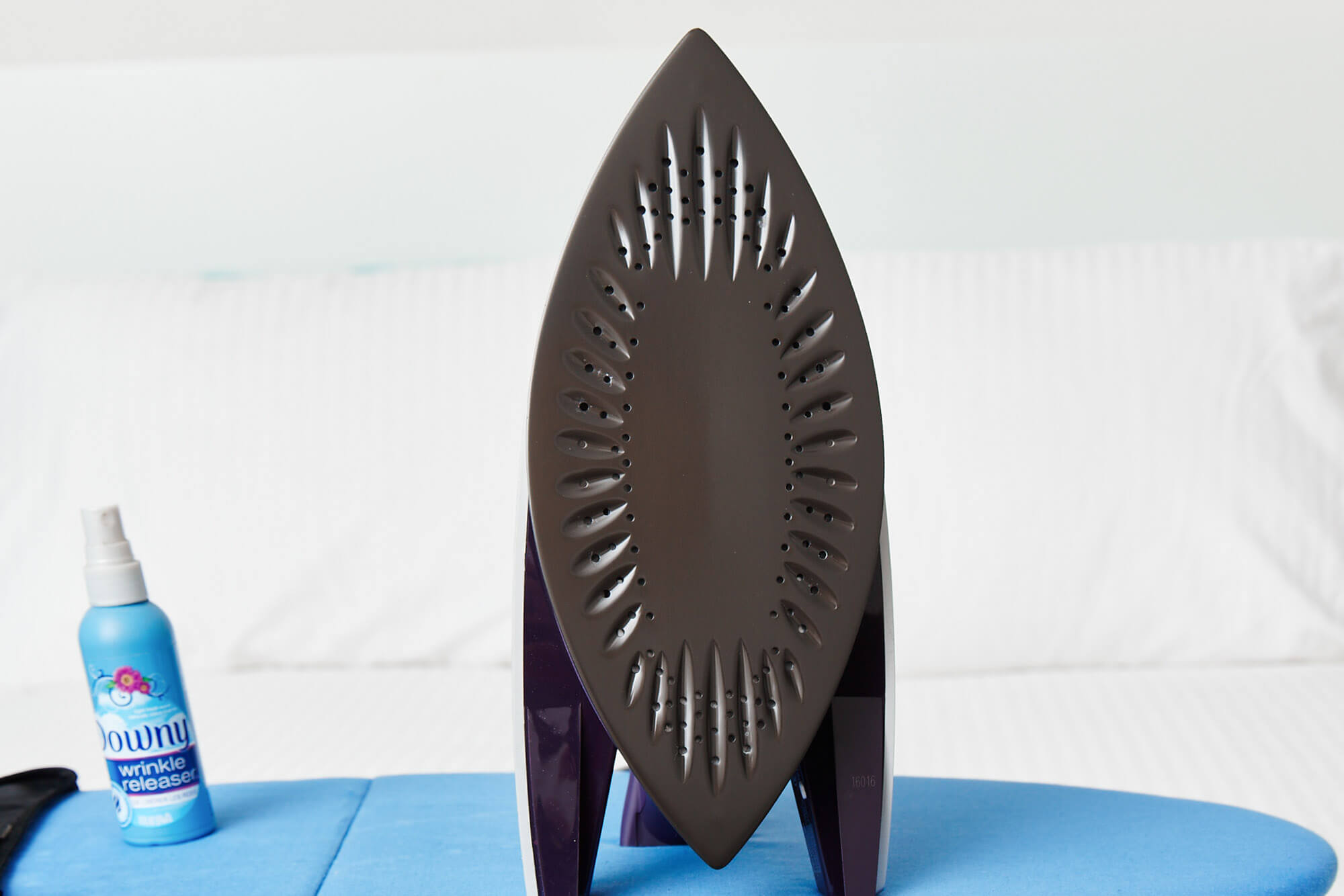
Panasonic – NI-W950A has a unique symmetrical eyeball shape that promised a “multi-directional” experience. We experienced a slight advantage in maneuverability. It was possible to back up into more spaces, like around buttons and around edges and iron from the back. Of course, the surface area of the soleplate is slightly reduced, but we didn’t feel a difference in terms of coverage. We can see how sneaking back into fine spaces could be useful for more intricate garments.
T-fal went so far as to trademark the word “ultraglide,” but that only brought us disappointment. The only ceramic soleplate of the bunch, the T-fal, did not impress. We thought that even our low-budget finalist, the Sunbeam, gave us a smoother ride. It particularly faltered in our silk test, feeling slightly sticky in comparison to the rest.
Since ceramic soleplates are favored for resisting static cling, T-fal may be a better choice if you iron a lot of synthetic fabrics. But for cotton, linen and silk, its grades are middling.
Panasonic – NI-L70SRW Cordless Iron offers a few unique features that may appeal to those with specific needs. Professional crafter and co-author Nichole Ramirez cited the usefulness of lightweight and cordless irons for those who need to iron for hours at a time.
Though the Panasonic’s test results were about average, the fact that it’s easier to use for longer stretches of time could make all the difference. That it comes with a cover, a retractable cord (for the base) and a removable water tank make it an appealing choice for crafters and those who favor lighter irons.
Leak tests
Last, but certainly not least, we have our series of leak tests. Water leaks can hamper your overall speed of ironing. The more leaks you get, the more you need to slow down as the soleplate needs more time to heat back up.
In order to test for leaks, we agitated the irons with repeated steam bursts in three different states:
- Upright
- Down and flat
- While ironing
To test the anti-drip features, we set the irons to a high setting and then turned them down. This feature closes off the holes in lower temperatures where the water has trouble vaporizing due to reduced heat.
Again, Rowenta sweeps the top, next to Panasonic – NI-W950A in second and T-fal in a close third.
Important features to consider
Efficient heat-up and temperature-ready alert: Time is money, and the sooner you can start ironing, the sooner you’ll be done. For those who rush in the morning to those who just want to be done quicker, a fast heat-up time will give you a slight bump. In our study, we found that the indicator light or sound to signal when the iron is ready for use is just as crucial as the time it takes to heat up. We favored more obvious indications, like an audible “beep” or obvious indicator light, and factored this feature in our score for heating speed.
Steam output: The more steam, the quicker the job. This category includes a grading of steam burst, ease of use, and an oft-touted feature called “vertical steaming,” which turns a horizontal iron into a freehand steamer that removes wrinkles without direct contact.
Anti-drip: One of the most annoying yet unavoidable symptoms of a steam iron is dripping water. When the temperature of the soleplate drops down to silk and synthetic ironing temperatures, it is not hot enough to produce steam, potentially dripping water. Anti-drip measures aim to prevent drippage when set to lower temperatures.
Compatibility with tap water (anti-scale / anti-calcium): These days, many irons accept tap water almost exclusively. Gone are the days of buying a big jug of distilled water solely for the purpose of ironing. Good riddance! However, most manuals state that if you have very hard water, you can mix it 50/50 with distilled water.
Auto shut-off: High-powered heat and forgetfulness do not mix. An auto shut-off feature ensures that if you accidentally leave the iron plugged in or face down on fabric, it will not cause a fire.
Soleplate material: Depending on your needs, you should consider the soleplate material. The main types are:
- Stainless steel: Better option if you iron more natural fabrics like cotton and wool, as it conducts heat better, resulting in better steam. It is also better than ceramic for pressing creases on sleeves and pant legs. Crafters should be aware that stainless steel plates can stick to glues and decals at higher temperatures.
- Aluminum: A slightly cheaper soleplate to manufacture, also better at distributing heat evenly across garments.
- Ceramic: Typically made of aluminum that is coated with a ceramic layer. If you need to iron a lot of synthetic fabrics, ceramic resists static but is more likely to absorb colors from natural fibers like cotton and wool. Ceramic can also peel or wear down over time.
Warranty: Steam iron warranties tend to range from one to three years.
How do steam irons work?
Dating back at least a thousand years, the practice of using heat to smooth fabrics has seen many technological advances, culminating in the modern electric iron we see in most households today. Steam now comes standard with consumer-grade irons, making ironing tougher fabrics like cotton and linen much easier.
The combined force of heat and steam work together on a molecular level to get your fibers in line. More particularly, the long chains of polymer molecules can be moved and shaped with the application of heat and then cooled in place. This is the reason why ironing experts suggest cooling just-ironed clothing before wearing them. Reader’s Digest even suggests cooling for hours to allow creases to set.
Professor Mark Lorch at the University of Hull explains that wrinkles happen when water comes into contact with fabrics, such as in a washing machine. He explains “water molecules insert themselves between the cellulose molecules, break up the hydrogen bonds and act like a lubricant, allowing the cellulose molecules to slide over each other.”
The application of heat and steam works to break these hydrogen bonds again, and the weight of the iron forces the cellulose molecules to line up, in effect “ironing” the fabric flat.
Until 2012, it was believed that steam and water help loosen cotton fibers and other tough fabrics, which makes the straightening of polymers easier. Researchers at Laboratoire de Physique de la Matiere Condensee et Nanostructures de Lyon found that water vapor acts on the contacts between fibers of woven material. Over time, a crease will unfold itself very slowly as the capillary bridges between fibers reorganize themselves. The study found that raising the level of humidity considerably speeds up this process.
This explains why the application of steam helps get out wrinkles more quickly and effectively. An iron with more steam will therefore help you get through the pile of clothes more quickly.
What about starch and wrinkle-free fabrics?
Starch has been used as early as 800 BC to aid in ironing. When starch penetrates cotton fibers and dries, its molecules bind to one another and stiffen the fiber. It is a temporary solution and will keep the cellulose molecules in line until the next washing.
Formaldehyde had first been used in the 1930s to treat fabrics as a permanent solution to those wretched wrinkles. Formaldehyde — a human carcinogen — emits a foul odor, and in the 1990s, manufacturers started squeezing out excess formaldehyde with large rollers and curing the fabrics in ovens to decrease its output from finished fabrics.
Formaldehyde was then combined with other chemicals to form “cross-links,” which help keep the formaldehyde at bay. However, newly developed cross-linking agents like dimethyloldihydroxyethyleneurea (DMDHEU) and ethylene-urea/melamine-formaldehyde (EUMF) still output small amounts of formaldehyde. Manufacturers of “permanent-press” instituted a “Sealed Jar Test” to measure the amount of formaldehyde released from fabric in order to better monitor its levels.
Since the 1960s, polyester fabrics gave us another wrinkle-free alternative. Since this notoriously uncomfortable fabric has fallen in and out of favor over the years, permanent-press cotton is still popular. Formaldehyde-free agents such as dimethylurea glyoxal (DMUG) exist, but they are expensive and not as effective.
As such, formaldehyde-emitting permanent-press fabrics are still used today, though they are ten times less harmful than its original formulations. It’s best for those with sensitive to skin allergies to avoid permanent-press fabrics altogether and go back to the ironing board.
The bottom line
Clothing steam irons are the type of item you want to purchase far and few in between. We expect it to be well-constructed and last a long time, which we believe indicates an ultimately safer iron. Fast heating, robust steam, and good engineering and design are the cornerstones of a steam iron that can save you time.
Our top choice for this 2022 update is the Rowenta – DW5280 Focus, an upgrade from our previous top pick. This model has supreme glideability, thanks to its robust steam burst and dispersion and precision tip technology. Our budget pick is the Mueller – MU-77X, an incredibly affordable steam iron with many of the same features as our top pick. We also recommend the Singer – SteamLogic Plus-770 that’s a great option for heavy-duty ironing.
The post The 12 Best Steam Irons appeared first on Your Best Digs.
]]>The post The Best Book Lights appeared first on Your Best Digs.
]]>Table of contents
- How we selected finalists to test
- Compare the best book lights
- Best overall: LuminoLite
- Runner-up: Ecologic Mart
- Best for e-readers: TFY
- Other finalists we tested
- Important features to consider
- How we tested
- The bottom line
Compare the best book lights
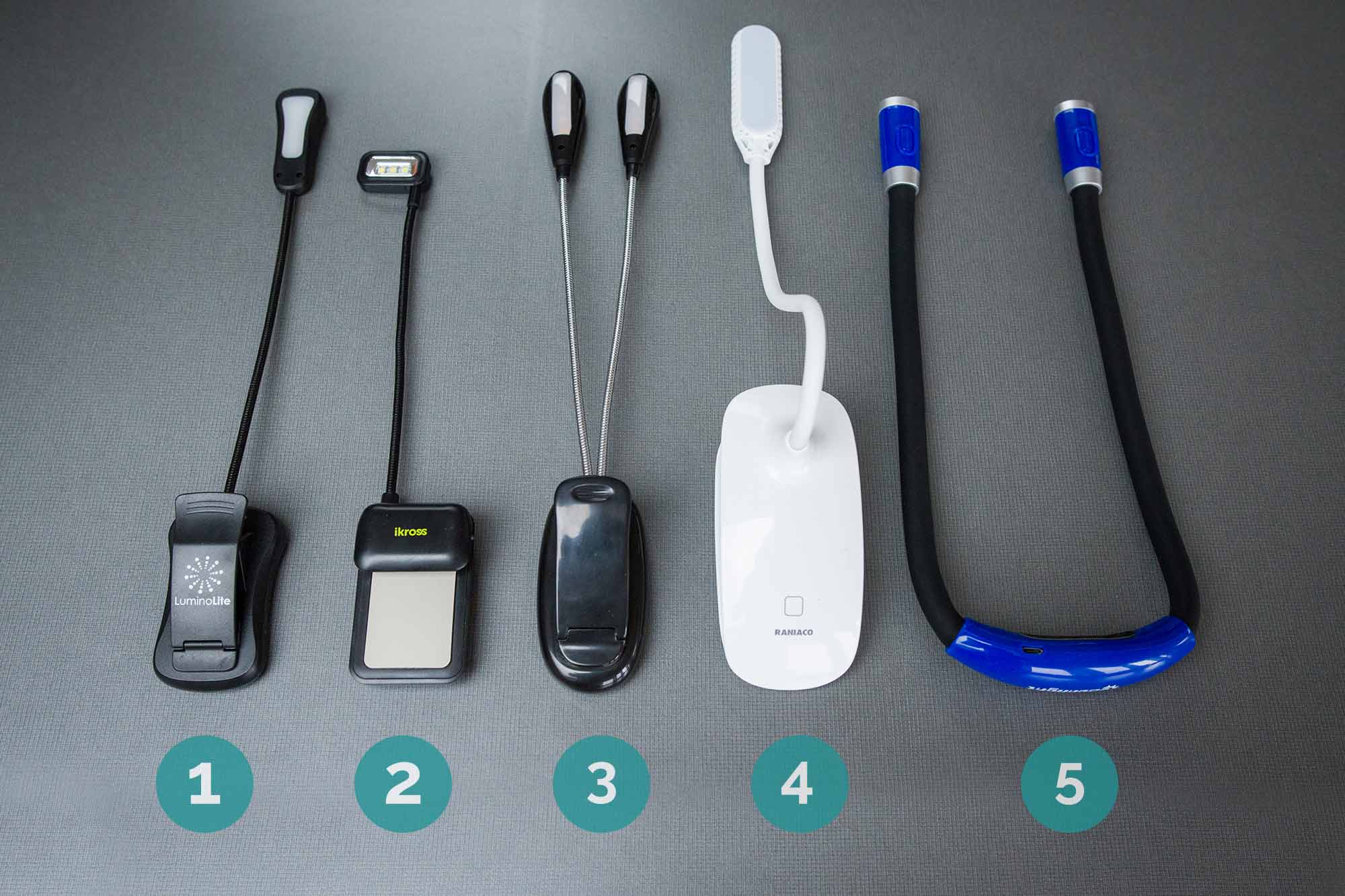
| Product | Price | Number of Heads | Brightness Levels | Power Source |
|---|---|---|---|---|
| 1. LuminoLite - Rechargeable LED | $$ | 1 | 2 | USB-rechargeable |
| 2. iKross - LED Clip On Light | $ | 1 | 2 | 3 AAA batteries |
| 3. Ecologic Mart - Eye Care Warm Booklight | $$ | 2 | 8 | USB-rechargeable |
| 4. Raniaco - Touch Switch Booklight | $$ | 1 | 3 | USB-rechargeable |
| 5. Cesunlight | $ | 2 | 4 | USB-rechargeable |
Best overall: LuminoLite
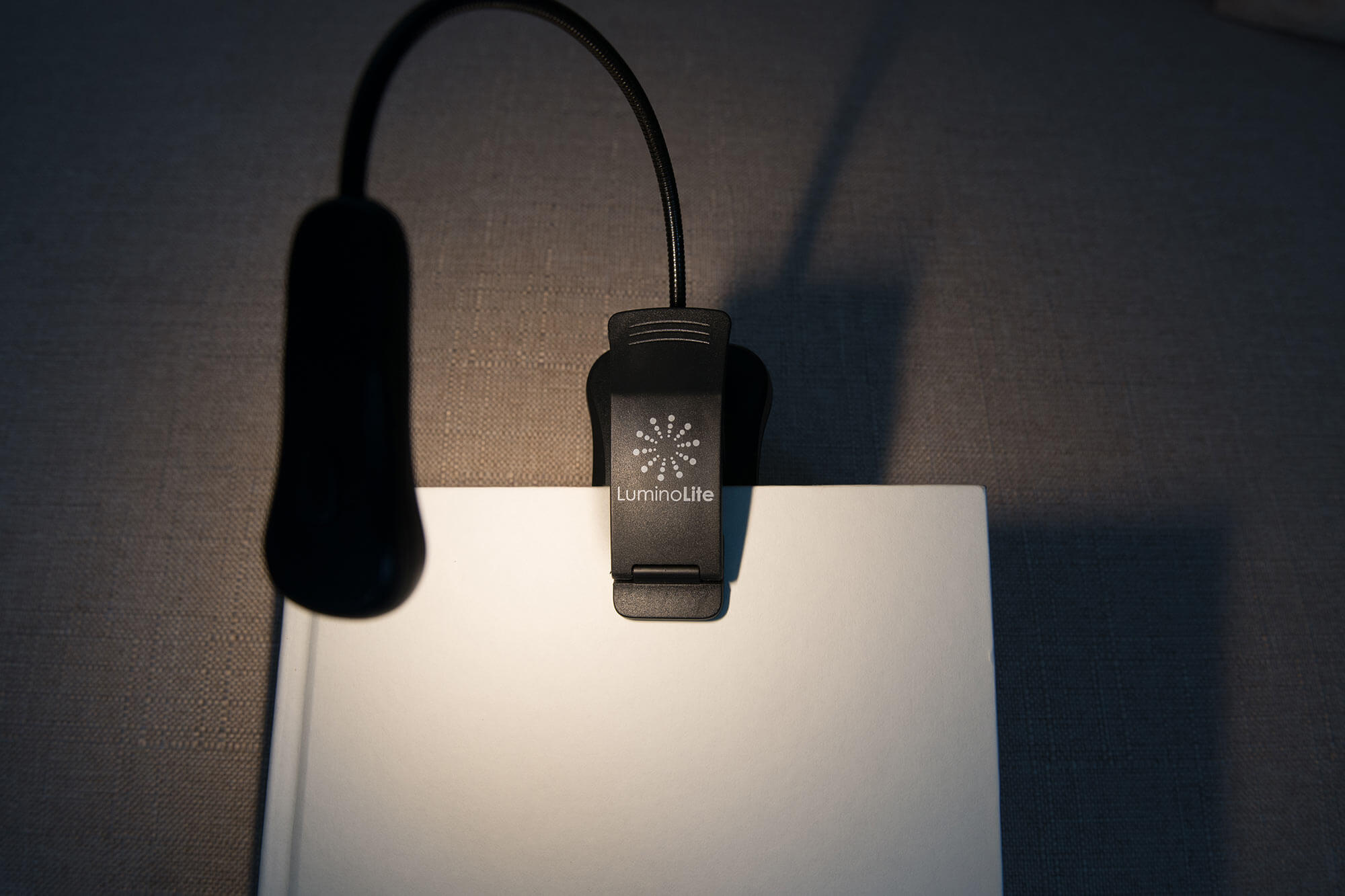
So what is the best book light for reading in bed? After hours of before-bed reading, we’ve determined that the LuminoLite – Rechargeable LED book light is the best book light. It casts a warm, buttery-colored glow that felt easier on our eyes than some of the whiter-toned lights. We also liked that it had two different light settings. The brighter setting was illuminating (but not abrasive) when reading in bed with the lights off. The dimmer setting was perfect for reading on a red-eye flight, where we didn’t want to disturb our sleeping seatmate. And speaking of flights, this light was also easy to travel with. The lightweight, flexible neck and durability of this little gadget made it easy to stuff into a coat pocket on layovers.
Plus, the LuminoLite’s micro-USB charging cord made it easy to plug into our laptop while waiting at the terminal. The diffused lights on this gadget also meant our whole book was illuminated at one time.
The only thing we didn’t love about the LuminoLite was its clip. While it worked well on hardcover books and laptops, it was ever-so-slightly too heavy and unwieldy to use on most paperbacks. Our tester ended up holding the clip in their hand when reading anything paperback.
Runner-up: Ecologic Mart
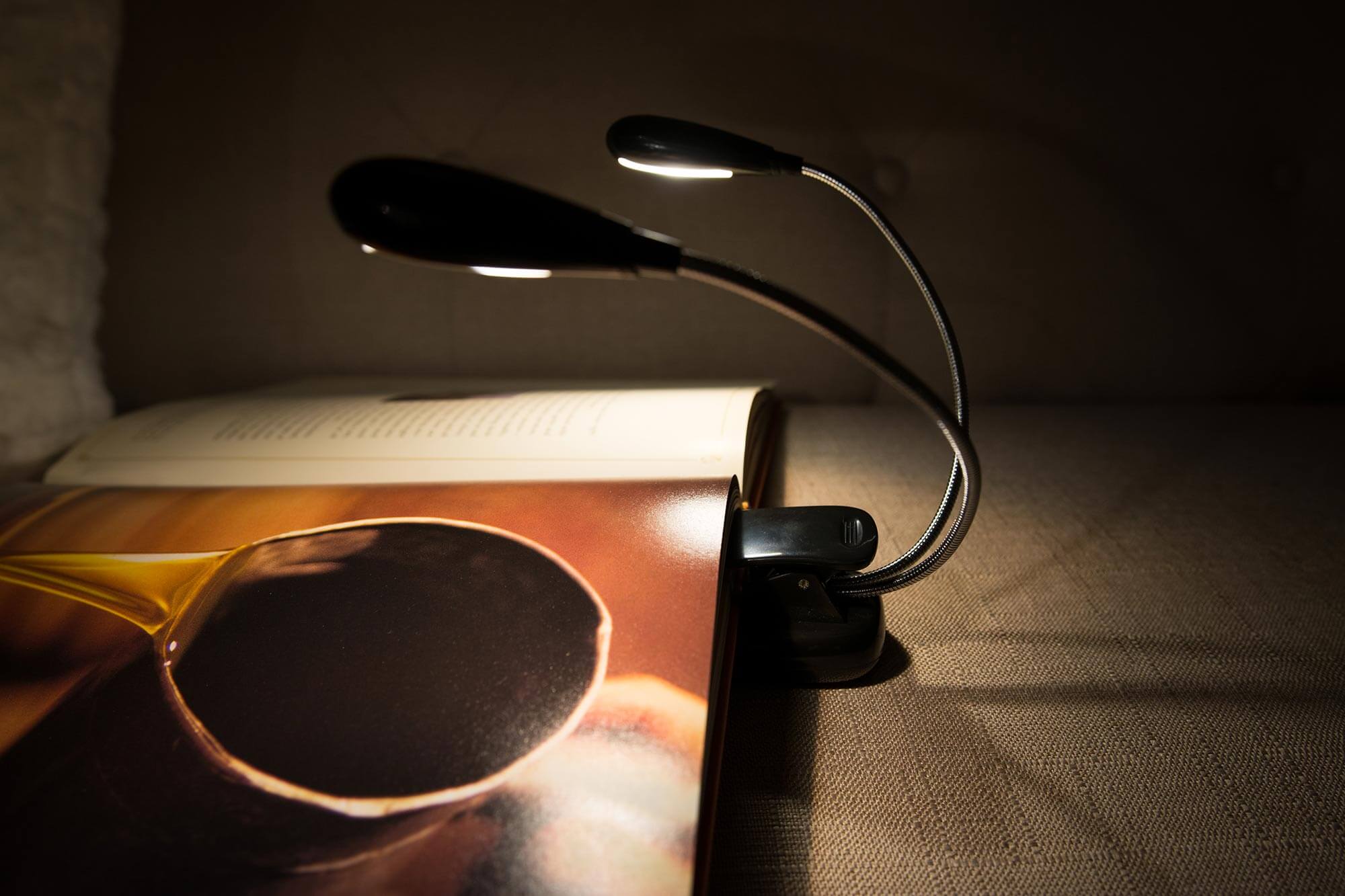
As a runner-up, we also liked the Ecologic Mart – Eye Care Warm Booklight. This one also has a warmer yellow light. More specifically, it has double the warm yellow light, since it has two heads. Our tester was skeptical about this feature at first, but ended up loving the way that it illuminated both pages at once. Our tester found that the grip worked well for every kind of book, paperbacks included. They also appreciated that this light is lightweight and easy to use in any position.
It comes with a rechargeable battery that held strong throughout the testing process, and it was easy to charge when we plugged it in (via USB cable) as well. The Ecologic Mart light was also the most expensive on our list, at just over $20, but we feel confident saying that it’s worth the (relatively small) investment.
The only downside we found to the Ecologic Mart? It has multiple settings, which is great, but you have to click through all of them to get to whichever one you want to use.
Best for e-readers: TFY

Editors note: like many of these book lights, the item we chose as the winner for this category was discontinued, but has an exact replica made under the brand TFY. We’ve replaced with all mentions on this review of ikross with the identical product from TFY. The only difference is the TFY comes in white.
For those who prefer the digitized version of their daily read, we suggest the TFY – LED clip On Light. Our tester used this on their Kindle and found that it stayed gripped in place no matter how they sat with it. They also liked that it had an adjustable arm, which meant they could move the light’s focus and shadows on the Kindle screen were never an issue. The two levels of luminosity on this light also offered flexibility for reading in a variety of settings.
What didn’t we like about the TFY? Though it’s advertised for use on both e-readers and traditional books, our tester found that it didn’t work on the latter because it was too awkward to turn the pages. Plus, unlike the rechargeable book lights, this one required us to keep three AAA batteries on hand.
Other finalists we tested
CeSunlight – Rechargeable Book Light
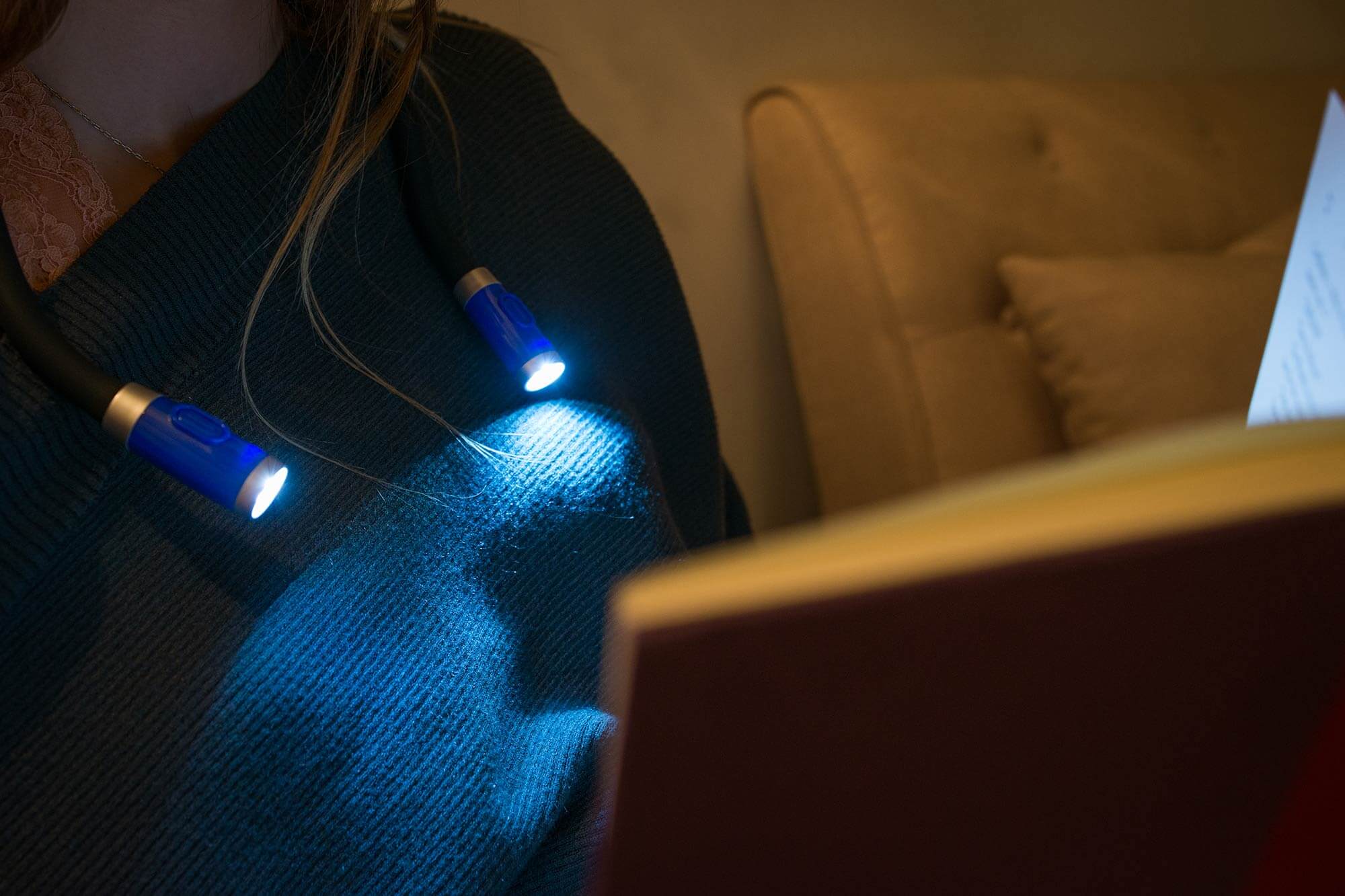
The CeSunlight was the most unique book light we tested, with a design meant to wrap around your neck rather than clip onto your novel. It’s also a multipurpose tool. Our tester used it as a flashlight, to walk the dog at night and more. Because it has multiple brightness settings (from a direct concentrated spotlight to a wider, diffused light), it can be used in almost any situation.
It also came with a pre-charged lithium battery that lasted throughout our entire testing period. However, we tested its battery charging feature anyway. You simply plug one end of the included cord into the light’s charging port, and the other into the USB port on your computer. We loved being able to do this, rather than keeping regular batteries on hand to power it.
While the CeSunlight is great for sitting up in bed and reading in just the right position, it can present a challenge if you want to relax any other way. Our tester found that laying on their side to read with this light was impossible because the book light leaned to the side along with them. They also found that they had to hold the book at a certain height so that the light emanating from around their neck could illuminate it properly. Simply put, this light will work for you, but only if you find the right reading position and stay there.
Raniaco – Touch Switch Book Light
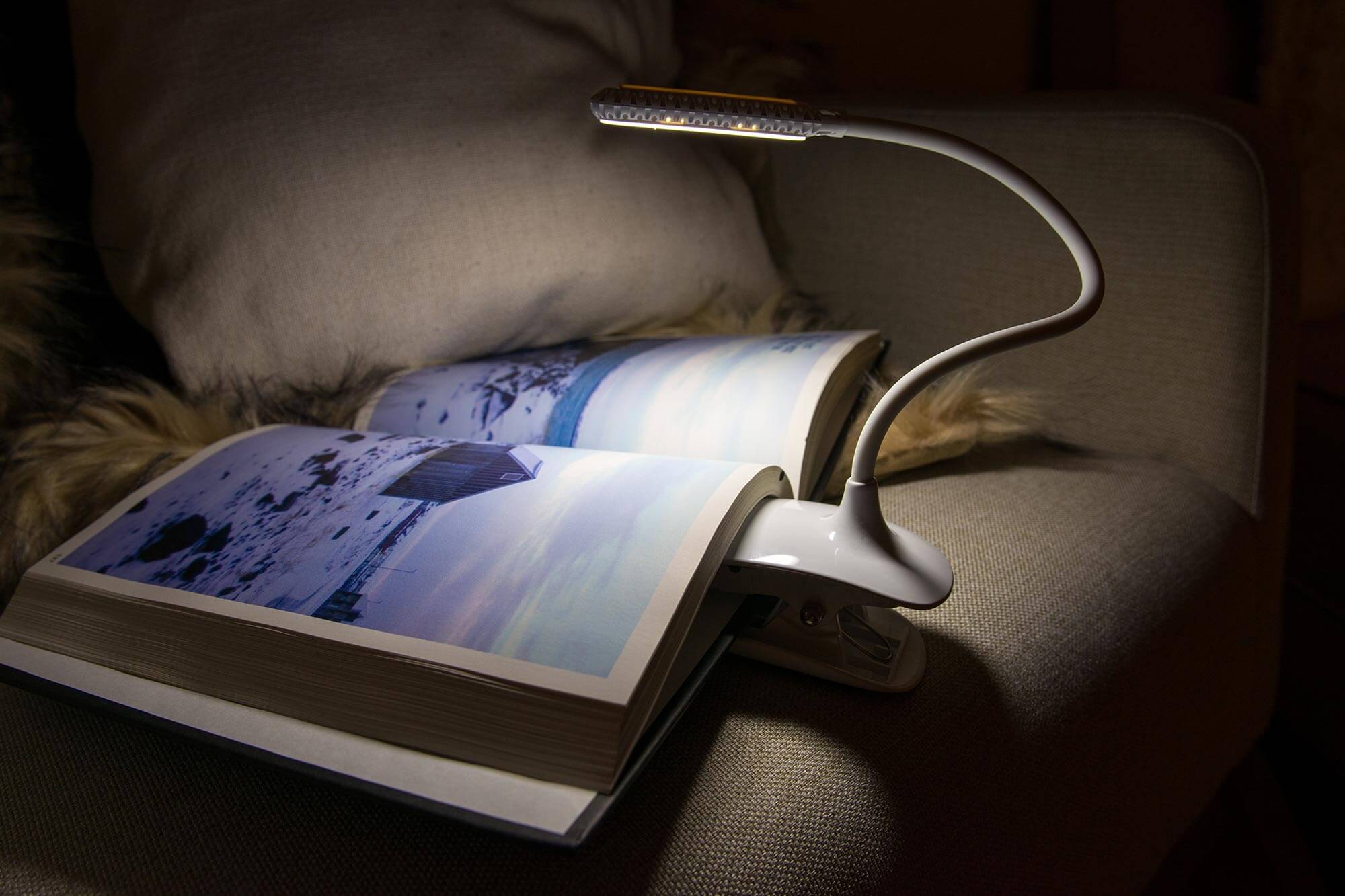
The Raniaco is the sleekest and modern of the lights we tested, with an all-white design and buttonless touch-lamp feature. It’s USB-chargeable and has a wide clip that fits onto a desk edge for late-night work. The small details on the Raniaco, like the anti-slip silicone and frosted lampshade, make it feel a step above the rest in terms of quality. All of that being said, our tester was not a fan. In fact, though they liked the actual light, they “loathed it from the neck down.”
Why? They found the touch button unnecessarily difficult to use when an on/off switch could have performed the same feature. Plus, they found that the bulky clip made it difficult to turn pages. Moreover, it was awkwardly shaped and obscured the pages, making it nearly impossible to clip onto a book.
Long story short, if you’re looking for a modern, attractive clip-on desk lamp, the sub-$20 Raniaco still may be for you. However, if you’re looking for a compact book light for reading in bed, we don’t recommend it.
How we selected finalists to test
First, we combed through hundreds of book light reviews on Amazon to find the lights users liked best. Then, we took to sites like Book Riot and Hooked to Books to see what the literary-minded section of the internet recommends. We also scoured the forums on Goodreads to see what passionate readers are looking for in a book light. Finally, we consulted with one of our own testers, who reads an average of four books per month. Then we used all of this information to select our top contenders.
We avoided book lights that exceeded $25. Why? We found that any models above this price point were similar or identical in design to their lower-priced counterparts. We also chose to only test a couple of the most highly-rated e-book lights, since many electronic reading devices are already illuminated enough on their own.
Important features to consider
If you’re considering purchasing a book light, you probably already enjoy cuddling up in your sit-up pillow with the latest bestseller from a book subscription box. A book light is a pretty simple purchase, but there are still some factors to keep in mind while selecting one.
Light and brightness: When it comes to book lights, it’s no surprise that brightness is the number one factor you should consider. You want a light that’s bright enough to prevent eye strain, but not so bright that it’s painful to read. If you’re purchasing a book light to use before bed, choose one with warm-colored bulbs. Cool-colored bulbs may be too stimulating. (We also found this to be true in our night lights review.)
You may also want to look for a light with multiple brightness settings, so you can choose the one that’s most conducive to your task or the time of day. Most of the book lights on the market today use LED bulbs, which are the most energy-efficient option.
Storage, portability and aesthetics: Some book lights are designed for travel, so they’re extra light and durable. Others are more sturdy and meant to hold firmly in place while you work.
Style and features: There are almost as many styles of book lights as there are genres of books. Some have a flexible neck (or even two) while others wrap around your neck. Some are designed to clip onto an e-reader while others are well-suited for a flimsy paperback.
Some lights also come with helpful features, like a shut-off timer that prevents you from sleeping with the light on.
Power source: While most of our book light contenders came with rechargeable batteries, one uses removable AAA batteries. Consider what’s most suitable for your situation. Equally important is how long each light holds a charge.
How we tested
We divided our book lights amongst a group of three insatiable readers. Then, we asked them to use the lights to read every night over a two-week period for at least 30 minutes. After that, we had our readers answer a slew of survey questions about their experience. Some of the questions we asked included:
- Do your eyes hurt after you use your book light to read?
- Does the light make turning the pages of your book inconvenient?
- Do you have to hold your arms at an awkward or tiring angle while using it?
- Is it lightweight enough to clip onto a paperback book?
We used all of these survey answers to do qualitative analysis. We also examined each light’s construction, noting any parts or materials that felt especially flimsy or durable. And finally, we tried charging the rechargeable lights (even if they didn’t need it yet), so we could see how well the process worked.
The bottom line
If you find the time to read regularly, you should be rewarded with the best book light on the market. Luckily, even the best-functioning ones we’ve found don’t surpass the $25 mark. Our number one pick, the LuminoLite, costs far less than that and is simple, convenient to use and easy on your eyes. For e-reader fans, we recommend the TFY, which clips firmly to your e-reader and won’t cast shadows on the screen.
The post The Best Book Lights appeared first on Your Best Digs.
]]>The post The Best Artificial Christmas Trees appeared first on Your Best Digs.
]]>Table of contents
- Real Christmas trees vs. fake Christmas trees
- Important features to consider
- How we selected finalists and winners
- Best fake Christmas tree: Best Choice Products
- The runner-up: National Tree Company
- Best small artificial Christmas tree: Home Accents Holiday
- How to fluff an artificial Christmas tree
- The bottom line
Real Christmas trees vs. fake Christmas trees
Real vs. fake. Which is better? It’s a highly contested topic each holiday season, and it’s one that the American Christmas Tree Association (the organization representing the artificial tree industry) and the National Christmas Tree Association (the organization representing the real tree industry) take seriously. Both groups make their cases for selecting either a real or faux tree, and we used them to inform our comparison.
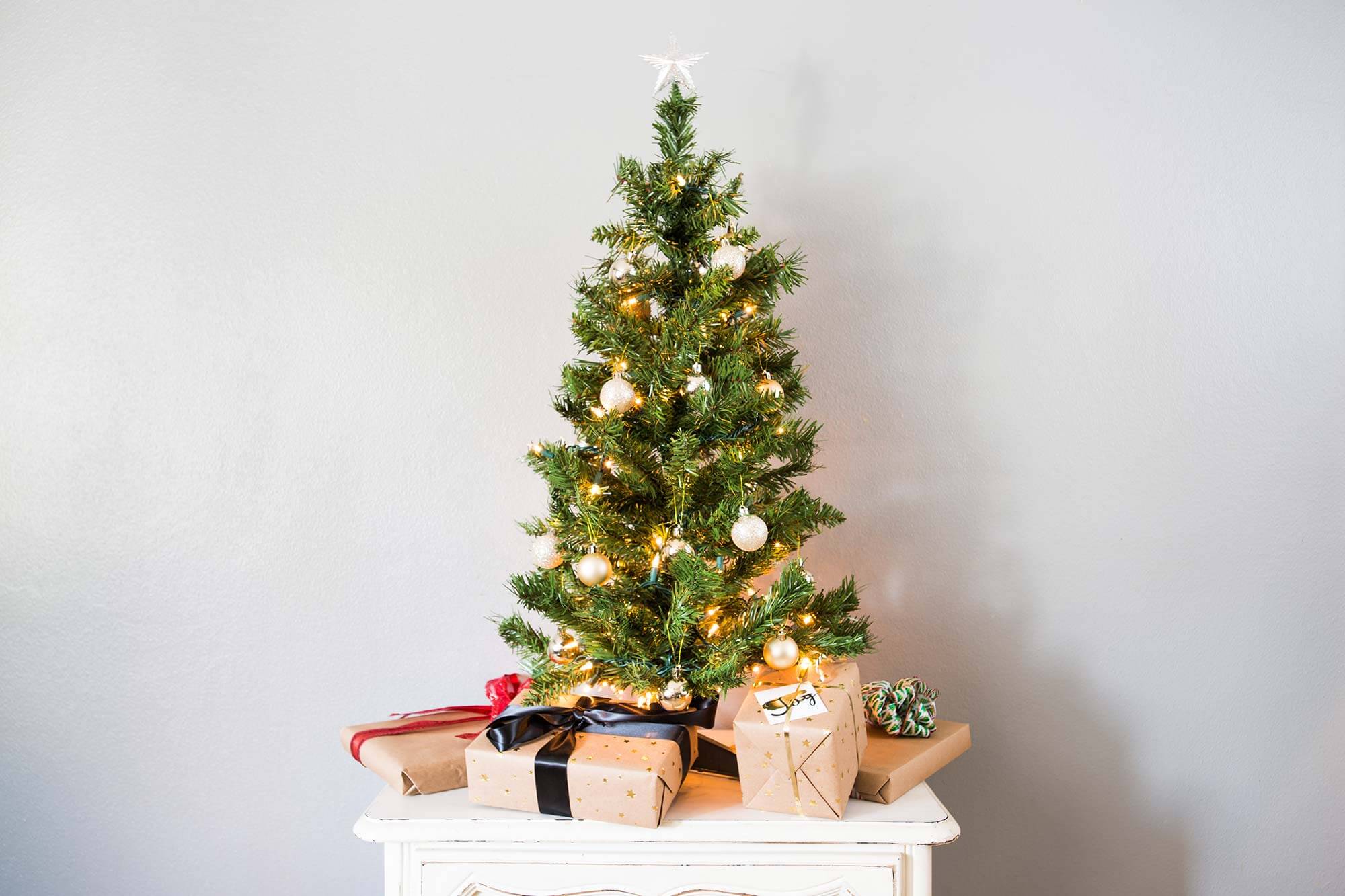
Fake Christmas tree pros
- While some faux Christmas trees may seem costly up front, they typically last between ten and fifteen years, making them a sounder financial investment than real trees.
- Artificial Christmas trees are convenient, typically requiring only simple assembly and fluffing once a season.
- You don’t have to worry about watering or maintaining your artificial tree throughout the season.
- You are not cutting down a live tree and disturbing animals that may inhabit it.
Real Christmas trees pros
- You get the quintessential holiday experience of going to the farm (or tree lot) to select a tree with your family.
- Though modern candles and air fresheners come close, nothing can exactly replicate the invigorating scent of natural pine.
- Most sources indicate that real Christmas trees have a slight advantage when it comes to environmental friendliness.
- Buying a real Christmas tree eliminates lead concerns. Many artificial trees are made with PVC, which can contain lead. There is no federal regulation for the lead in artificial Christmas trees. And you probably won’t find a faux Christmas tree without PVC in it.
Important features to consider
If you decide to go artificial, there are a few buying factors to keep in mind. An artificial tree can last a decade or more, so it’s worth investing the time to find the perfect one for you. Here are some key features to consider:
Number of branch tips and shedding: If you’ve already started perusing through faux trees online, you’ve noticed that many companies specify the number of branch tips on their trees. This is because there’s a direct connection between the number of tips and realism. More tips yield a more realistic tree. Just like real Christmas trees, these branch tips are also bound to shed some needles. This is especially true the first time you take the tree out of the box and set it up. The best fake Christmas trees will shed less with each year of use.
Type of branches: The type of branches on the tree also has an impact on its assembly. You may want a tree with hinged branches, rather than the type you screw in because it makes assembly easier.
Material and flocking: Consider whether you want a tree flocked with fake snow (or glitter) or if you want something more realistic. You may also want to choose a tree that’s made with more Polyethylene (PE) than PVC since PE is thought to pose less health risk. If you read the fine print, many tree companies will tell you what percentage of PE their tree is made with (if any).
Ease of assembly, disassembly and storage: Most of the artificial trees on the market (including the ones on our list) come in three parts that are easy to click together. However, the process of “fluffing” the tree (spreading the tips apart and arranging the branches) can be time-consuming. The more time you spend fluffing your tree, the better it will look. More on that later.
If you can’t fit the tree back into its original box when it’s time to put it away (who can?), just ensure that it’s covered and stored in a cool, dry location (or put it in a Christmas tree bag).

Height and dimensions: Consider the height of the tree you’d like to purchase, bearing in mind that you’ll need to access the top of the tree for decorating. If the ceilings in your home are within the standard (American) eight to nine-foot range, a 7.5-foot tree is probably ideal for you. The dimensions of the tree you purchase should be dependent on where you’re displaying it. If you’re placing it in a small corner, a narrow tree is best, whereas a tree with a wide girth is best for a front and center display.
Pre-lit trees and type of lights: While deciding whether to buy a pre-lit tree is a personal decision, we suggest that you don’t. Though the quality of string lights has improved in the past several years, you still risk the lights on your tree burning out before you’ve gotten full use of the tree. Furthermore, you usually cannot remove the lights from the tree.
If you do purchase a pre-lit tree, you should look for one that has about 100 lights per foot-and-a-half of tree. You can find both incandescent-lit and LED-lit trees on the market. However, LED lights are the by far the favored choice for their energy saving and long-lasting qualities.
Cost: The cost of artificial Christmas trees varies dramatically. While it’s true that higher cost is usually synonymous with a higher branch tip count and better looking tree, there are some bargains out there that look pretty realistic for an affordable price. The trees on our list run the gamut in cost, starting at about $20 (for a tiny apartment-sized tree) to over $100 for one of our top contenders. Though all of our picks fall under $200, it’s not unheard of to drop nearly half a grand for a tree.
Want to get the best deal on your tree? Some experts suggest you buy during the first two weeks of December.
How we selected finalists and winners
We started our quest for the best artificial Christmas tree to buy by researching the artificial Christmas tree market. While there are quite a few brands out there, many of the trees that are sold are almost (if not completely) identical in material and composition. Many of them are just renamed for different brands. We also found that some stores, like Walmart, sold multiple brands online but only had their in-house brand in our local brick and mortar stores.
We also searched the web, scouring Amazon, Home Depot, Lowes and Target for the most-reviewed and highest-rated trees. We stuck with trees under 8 feet tall since that’s the height of the average American ceiling.
Next, we consulted review sites like Wirecutter and cultivation sites like New York Magazine to get a more well-rounded view of the trees on the market. Finally, we browsed home-decorating sites like Good Housekeeping to see which artificial trees they recommended. From there, we charted all of the trees and their specs (like height and material) to compare and contrast which ones were best.
The Christmas tree you choose will come down largely to personal taste, like which toothpaste you use or what you eat for breakfast. So, we didn’t get overly technical with our tree comparisons. Instead, we simply considered objective factors like the number of branch tips on each of our top contenders. We took an in-depth look at the material composition of each tree. Then we looked at what it took to assemble and disassemble each one and considered each tree’s cost.
Finally, we piled on our sweaters and headed to the stores to see our picks in person. We took pictures and notes and examined their textures up close. Then, we took the top contenders home and assembled, decorated (and photographed) them ourselves, to make sure they lived up to the hype.
Our finalists were trees that had a good needle count for the price, looked good both decorated and undecorated and were a breeze to set up.
The best fake Christmas tree: Best Choice Products
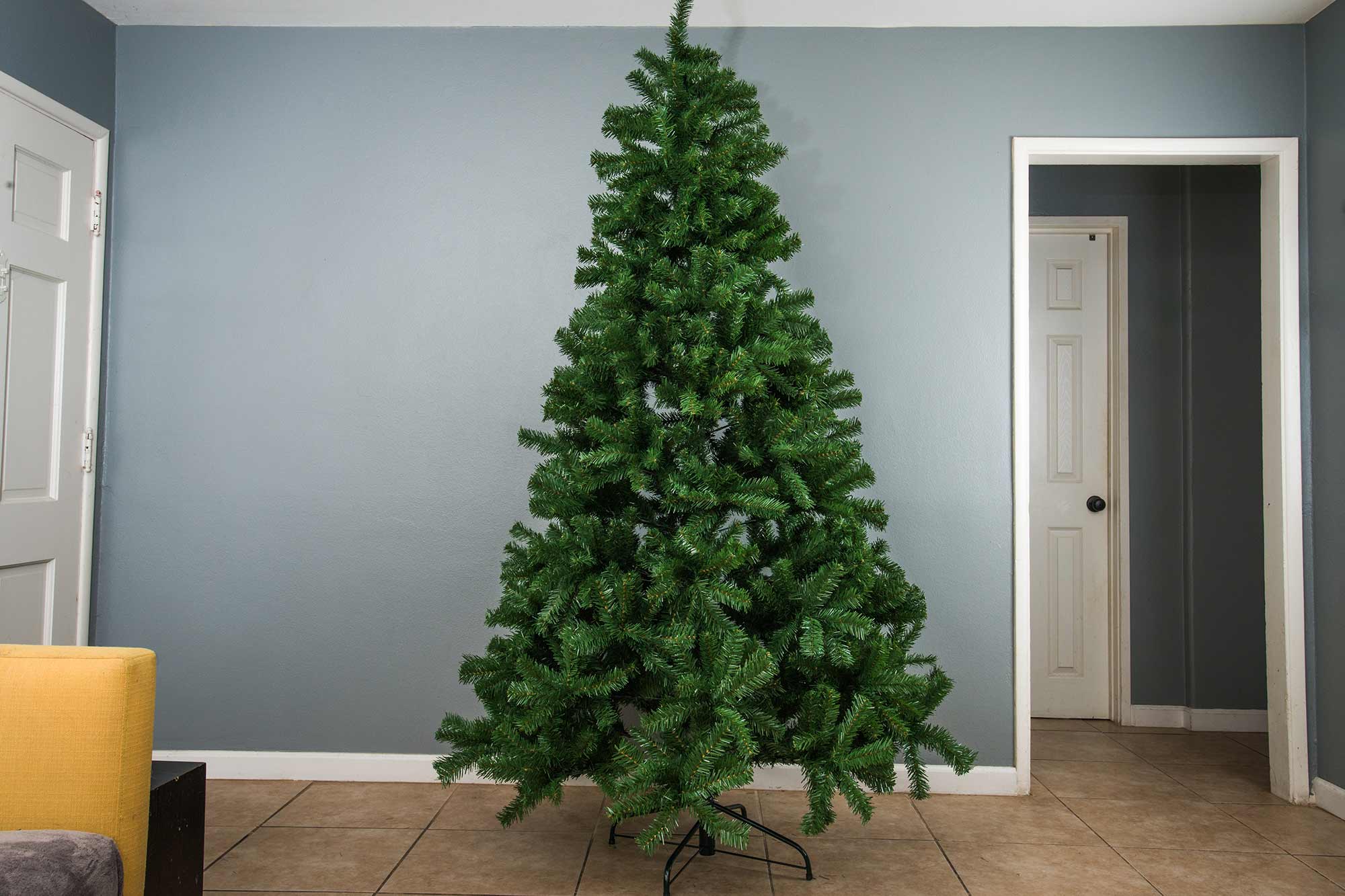
When it comes down to it, a lot of artificial Christmas trees in the $80 – $200 are very similar, if not identical, in design. For this reason, we had a tough time choosing between our top two contenders, the Best Choice Products – Premium Spruce and the National Tree Company – North Valley Spruce.
Ultimately though, we think that the 7.5 foot Best Choice Products is the best artificial Christmas tree. (And we promise we weren’t just swayed by the name.) It’s got 1,346 long branch tips that give it a full and fluffy look, even with its 52-inch width. It also seems to be a slightly lighter green color than the NTC tree, which looks nice with the warm glow of string lights.
Best Overall: Best Choice Products - Premium Spruce
The Premium Spruce from Best Choice Products is easy to assemble and looks lush. Branches stayed in place once we folded them down, and we experienced minimal shedding from loose needles. Plus its lower branches are high enough to fit plenty of presents beneath.
We did sustain some minor branch scratches while fluffing this tree, but the NTC tree injured us, too. (For that reason, we highly recommend that you purchase some gloves before fluffing your tree at home).
We also found the Best Choice tree was really easy to set up. Simply click the three tree sections into place, fluff and you’re done. The only challenging part was the top third of the tree. Some of its branches were compressed so tightly against the center pole that we didn’t realize they needed to be pulled down at first. There were some complaints on Amazon about the top of this tree being too small, and we think that this could be the reason why.

However, once the branches are in place, they stay formed exactly how you set them. The Best Choice tree branches also sit higher off the ground than the NTC tree, meaning that you can easily slide gifts underneath. It had minimal shedding when we set it up, requiring just one quick sweep of a broom to undo the damage. And at less than $90, this tree is also one of the best deals of the holiday season.
Once you’re finished with this tree, it breaks down into three sections, and the branches can be compressed up against it. Even so, it may be hard to fit in the original box again, so we recommend a storage bag.
If you’re looking for a high-quality tree in a different size, Best Choice Products makes similar trees in a variety of sizes.
Key takeaways:
- The 7.5 foot Best Choice Products tree is simple to set up with three pieces that click together.
- The Best Choice Products tree is a great bargain at less than $100, resembling trees that cost $50 – $100 more in composition and material.
- The Best Choice Products’ branches start high off the ground, meaning there’s plenty of room for presents under the tree.
The runner-up: National Tree Company

The 7.5 foot, 52-inch-wide National Tree Company – North Valley Spruce (or NTC tree, for short) was a close second in our tests. It looked almost identical to the Best Choice Products tree, though just slightly less full.
Runner-up: National Tree Company - North Valley Spruce
Of the trees on our list, the NTC's North Valley Spruce was the easiest to assemble — and also the simplest to pack up and store. Compared to our top pick, the branches extend down fairly low so you may run into trouble if you're trying to stage a mountain of gifts.
That being said, this NTC tree was even easier to set up than the Best Choice Products tree. It was so easy, in fact, that two people could set it up in under 45 minutes. The hinged branches literally fell into place as soon as we snapped the three sections of the tree together. Then we did some fluffing and it was ready to go! As mentioned, this tree also left our arms a little bit scratched up after the fluffing process.
Another thing we loved about the NTC tree is that its branch tips are varied in length. It has the same number of branch tips as the Best Choice tree (1,346), but some are short and some are long, giving the tree a more organic and realistic look. Our anti-artificial tree tester even mentioned that this tree “looked better than [he] expected it to” after fluffing.

A couple of things that stopped this tree from being number one? The branch tips on this tree start relatively far from the center pole, meaning that from certain angles, you risk seeing a lot of bare metal hinges. Though, if you plan to decorate the tree with lights and ornaments, this becomes less of a problem. The branches also extend very low to the ground, which means it’s hard to slide sizeable presents underneath.
Like the Best Choice tree, this one breaks down into three sections with branches that can be compressed for storage. And, National Tree Company also makes artificial trees in a variety of other sizes.
One disclaimer about both The Best Choice and National Tree Company trees: like many artificial trees in their price range, they are made with PVC rather than PE. As we mentioned earlier, some people are dubious about the potential health risks of being around PVC. While finding a tree with less PVC and more PE (a safer alternative) is possible, it will typically cost you more.
Key takeaways:
- The 7.5 foot National Tree Company tree was the easiest to set up.
- This tree’s branch tips start further out on the branches, leading to a more sparse look.
- The branches on this tree extend very low to the ground, which creates a fuller look, but makes it harder to put presents underneath.
The best small artificial Christmas tree

Apartment dwellers, we haven’t forgotten about you! If you’re searching for something that looks to-scale in your compact living room, we’ve curated a few 5-foot-and-under options for you as well.
Home Accents Holiday – 3 Foot Unlit Tacoma Pine
We found the Home Accents Holiday – 3 Foot Unlit Tacoma Pine to be the best small artificial Christmas tree. This festive little tree is a holiday steal at under $20. Much like its description says, it can fit just about anywhere. No pre-strung lights on this one mean you don’t have to worry about a burnout before you’ve gotten full use of your tree, either. Reviewers also loved how easy it was to put together. Notably, it felt softer and less-synthetic to the touch than it’s 5-foot older brother. Perhaps because it’s lacking lights that illuminate its tips, it also looks a bit more lush and realistic.
Vickerman – Carmel Pine Tree with Cones
This Charlie Brown-style Vickerman – Carmel Pine Tree with Cones is sparse in appearance, but still looks cute decked out with miniature lights and ornaments. It has a sturdy burlap-wrapped base and is dotted with small, whimsical pinecones. Available in four sizes ranging from 18 inches to 42 inches, its smallest size costs under $20.
| Tree | Number of Branch Tips | Height (ft) | Unique Features |
|---|---|---|---|
| Vickerman - Camel Pine | 995 (includes pinecones) | 2-3.5 | Burlap base |
| Home Accents Holiday - Prelit Wood Trail Pine | 370 | 5 | 200 incandescent lights |
| Home Accents Holiday - Tacoma Pine | 118 | 3 | Two-tone branches |
Home Accents Holiday – 5 Foot Pine with Clear Lights
The pint-sized Home Accents Holiday – 5 Foot Pine with Clear Lights comes pre-trimmed with clear lights. It arrives in two pieces that you slide together. Then you fluff it, plug it in and it’s ready for ornaments. Most reviewers shared that this entire process took them less than an hour. This little tree is compact and festive, especially for the sub- $50 dollar price point. One big negative? The bulbs are incandescent. However, there is a good amount of them for such a small tree, and we found that they cast a nice warm glow when we examined this tree in person.
Best pre-lit: Home Accents Holiday
Because we advised against pre-lit trees (as you typically can’t remove the lights from the tree even if they burn out), we chose to focus our research on unlit trees. That being said, we know that the convenience of a pre-lit tree is sometimes irresistible. And we have to admit, they make festive night lights. So, we’re still sharing our favorite pre-lit pick.
The Home Accents Holiday – 7 Foot Tree with Clear Lights is a great choice for around $100.
Perhaps a good “starter tree” for a young family, it has all of the basic functionalities like quick-set technology and an included stand, lights and fuses. However, this tree’s comparatively low price point shows through in its branch tip count (just 1000 tips) and only 500 lights. Even less reassuringly, the lights are incandescent, which means you risk burnout before you’ve gotten the most out of your tree.
How to fluff an artificial Christmas tree
Once you’ve purchased and assembled your artificial tree, you must fluff it. “Fluffing” is an (admittedly adorable) term for arranging all of the branches on the tree. It may seem like an imposing prospect but, in reality, it just requires a few simple steps repeated over and over again. This is a good time to bribe friends and family members to help you. We think a couple of hours of fluffing in return for some homemade hot chocolate is a good offer.
Step one: Start at the base of your artificial tree. Pull one branch out from the center of the tree.
Step two: Starting at the back of the branch (the part closest to the center of the tree) gently pull the tips of the tree away from the branch. Bend them into opposite directions so that they’re not all pointing the same way.
Step three: Continue doing this until you’ve completed the base of the tree. Take a hot chocolate break, then move on to the middle portion. After that, you can move on to fluffing the top portion. The experts at Balsam Hill recommend that you fluff the top portion before attaching it to your tree.
The bottom line
Artificial Christmas trees aren’t for everyone. If they are your cup of tea, though, it makes sense to invest in one that’s attractive, functional and good quality for the price. We recommend the Best Choice Products – Premium Spruce to satisfy that trifecta. It looks full and festive and comes together quickly with under an hour of setup. At less than $100, it’s also great quality for a low price.
The National Tree Company – North Valley Spruce is another excellent choice. It’s the easiest and most convenient tree to set up in under an hour and its varied-length branch tips make it look more realistic.
If you need a small tree, the Home Accents Holiday – 3 Foot Unlit Tacoma Pine is a quality investment with its soft branch tips and below $20 price point.
The post The Best Artificial Christmas Trees appeared first on Your Best Digs.
]]>The post The Best Money Clips appeared first on Your Best Digs.
]]>Table of contents
- The 20 money clips we tested
- Best overall: Storus – Smart Clip
- The minimalist pick: Adamant
- The best wallet options
- The best banded options
- Other products we tested
- How we selectedt
- How we tested
- Important features to consider
The 20 money clips we tested
| Product | Price | Type | Material |
|---|---|---|---|
| 1. Storus | $ | Clip | Stainless steel |
| 2. Adamant | $ | Clip | Silver plating with black enamel |
| 3. Viosi | $ | Clip wallet | Leather |
| 4. Kinzd | $ | Clip wallet | Varied |
| 5. Prägres | $ | Banded clip | Wood |
| 6. Xband | $ | Banded clip | Nylon elastic |
| Product | Price | Type | Material |
|---|---|---|---|
| 7. Shivam | $ | Clip | Metal |
| 8. SHARKK | $ | Clip | Stainless steel |
| 9. Alaska Bear | $ | Clip | Stainless steel |
| 10. Knife Center | $ | Clip | Aluminum |
| 11. CL Carbonlife | $ | Clip | Carbon fiber |
| 12. Royce Leather Clip | $ | Clip | Leather |
| 13. Izola | $ | Clip | Brass |
| 14. Serman | $ | Clip | Carbon fiber |
| 15. Distil Union | $ | Clip Wallet | Leather |
| 16. idclipz | $ | Clip Wallet | Carbon fiber |
| 17. NapaWalli | $ | Clip Wallet | Leather |
| 18. MUTBAK | $ | Clip Wallet | Leather |
| 19. Alpine Swiss | $ | Clip Wallet | Leather |
| 20. Royce Leather Wallet | $ | Clip Wallet | Leather |
Best overall: Storus – Smart Clip
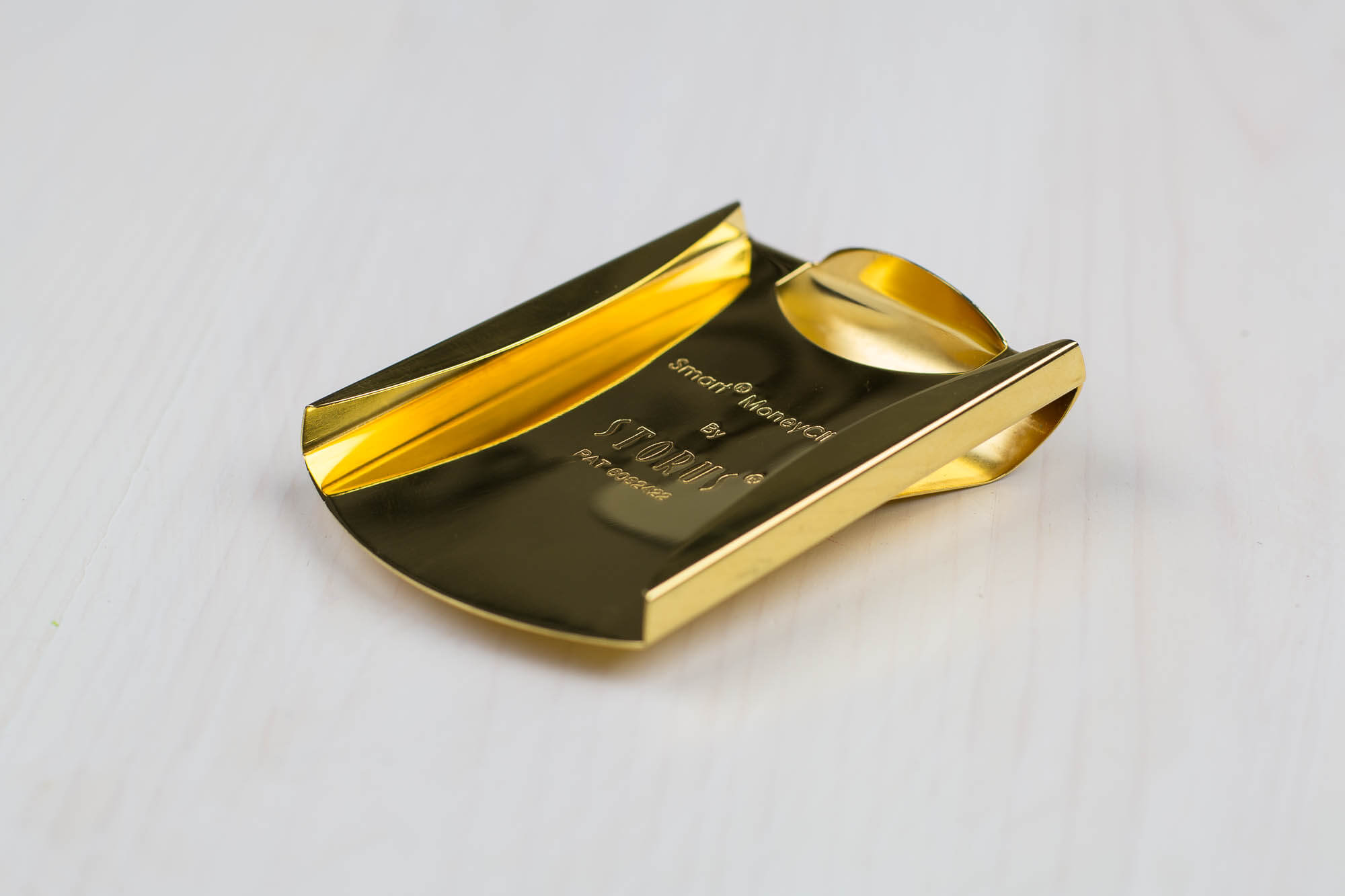
Storus, a division of Mosaic brands Inc, makes innovative and unusual “personal storage solutions” that you don’t see on your average trip to the department store (think dual-sided money clips and jelly wallets.) We ordered their Smart Clip, which costs between about $20 and $40 depending on the finish you choose. But regardless of the color, it’s secure enough to hold money and cards tightly, while still retaining enough room for a good deal of cash and cards.
The dual-sided holders, an anomaly in the money clip world, mean that you can keep cash on one side and cards on the other. The Storus’ durable metal material also stood up well to getting knocked around by keys and purse contents.
Upon receiving all of the money clips that we ordered, the Storus immediately stood out for its unique design. Its curved edges, wave-like aesthetic, and double-sided clips make it a stand-out in a sea of rectangular clips. We ordered it in the gold color and found that the finish didn’t look chintzy or scratch easily. Reviewers on Amazon also noted that the finish did not wear down after extended use. Plus, our tester shared that this clip even garnered a few compliments when they pulled it out to pay.
The only downside of this clip is that it holds five cards maximum on one side, with our tester noting that (in their experience) it could handle no more than four. Keep in mind though that this clip does have two sides, so you could technically store cards on both. The final verdict from our tester? They’d “definitely continue using it.”
The minimalist pick: Adamant
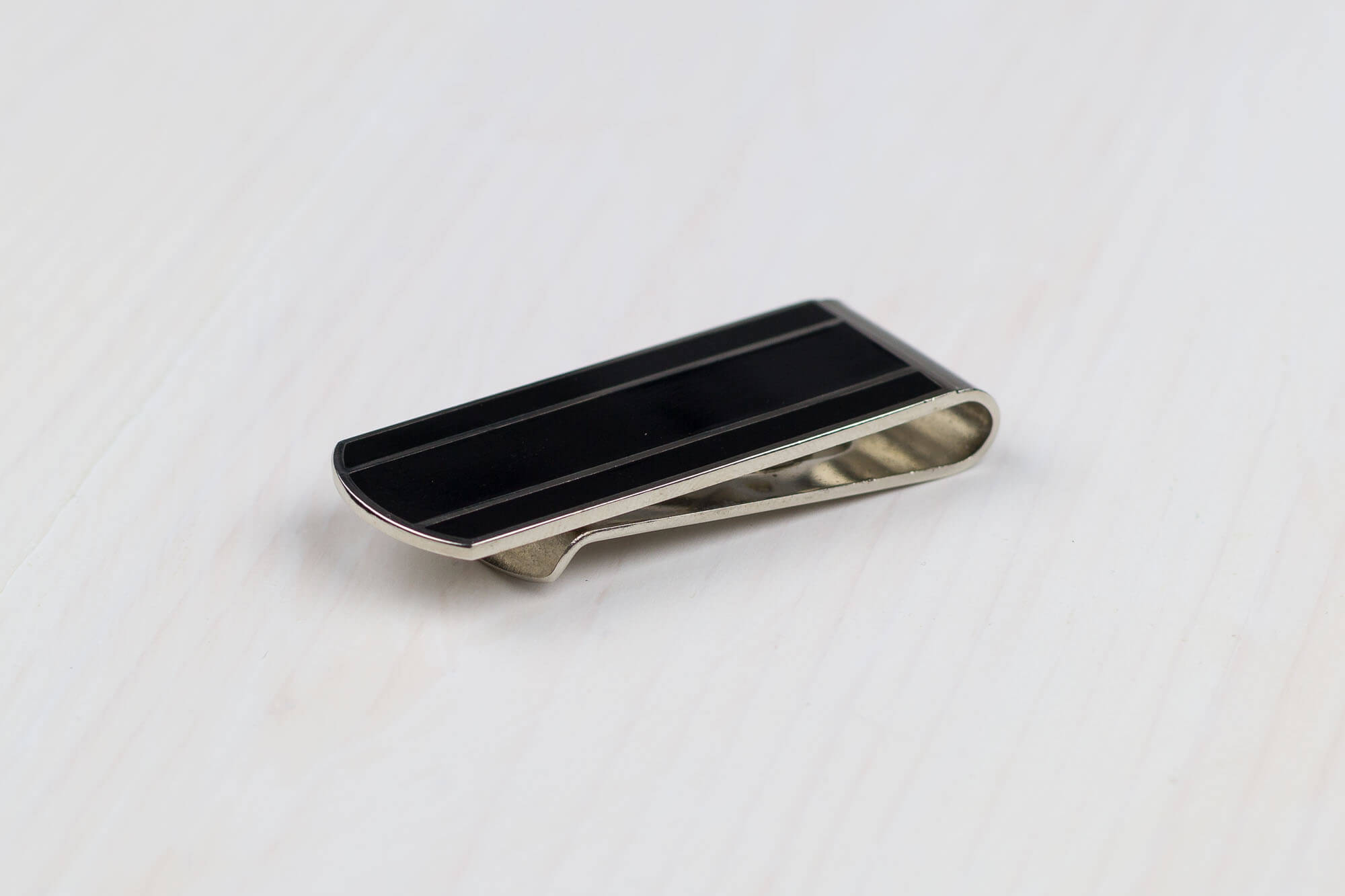
One of the most common responses to our money clip testing was “who carries cash anymore?”
It’s true, there’s no doubt that we are in the digital age, and many of us rely almost exclusively on credit cards for our transactions. If that’s the case for you, you may want to skip the Storus’ dual carrying capacity and head straight for the Adamant instead.
With its cost coming in at just under twenty bucks, this clip’s design is evocative of a bygone era. Its black finish and metallic stripes feel like a vintage car. However, its functionality takes a cue from the modern minimalist movement. The Adamant is best for carrying ID, debit, a couple of credit cards, and nothing else; and it holds onto them with an iron grip. Yet despite its tight hold, our tester noted that it was “arguably the quickest and easiest card experience” he’d ever had when it was time to grab a card to pay.
The only downside? According to our tester, this clip’s tight clasp isn’t all that convenient for inserting and taking out flimsy dollar bills.
The best wallet options
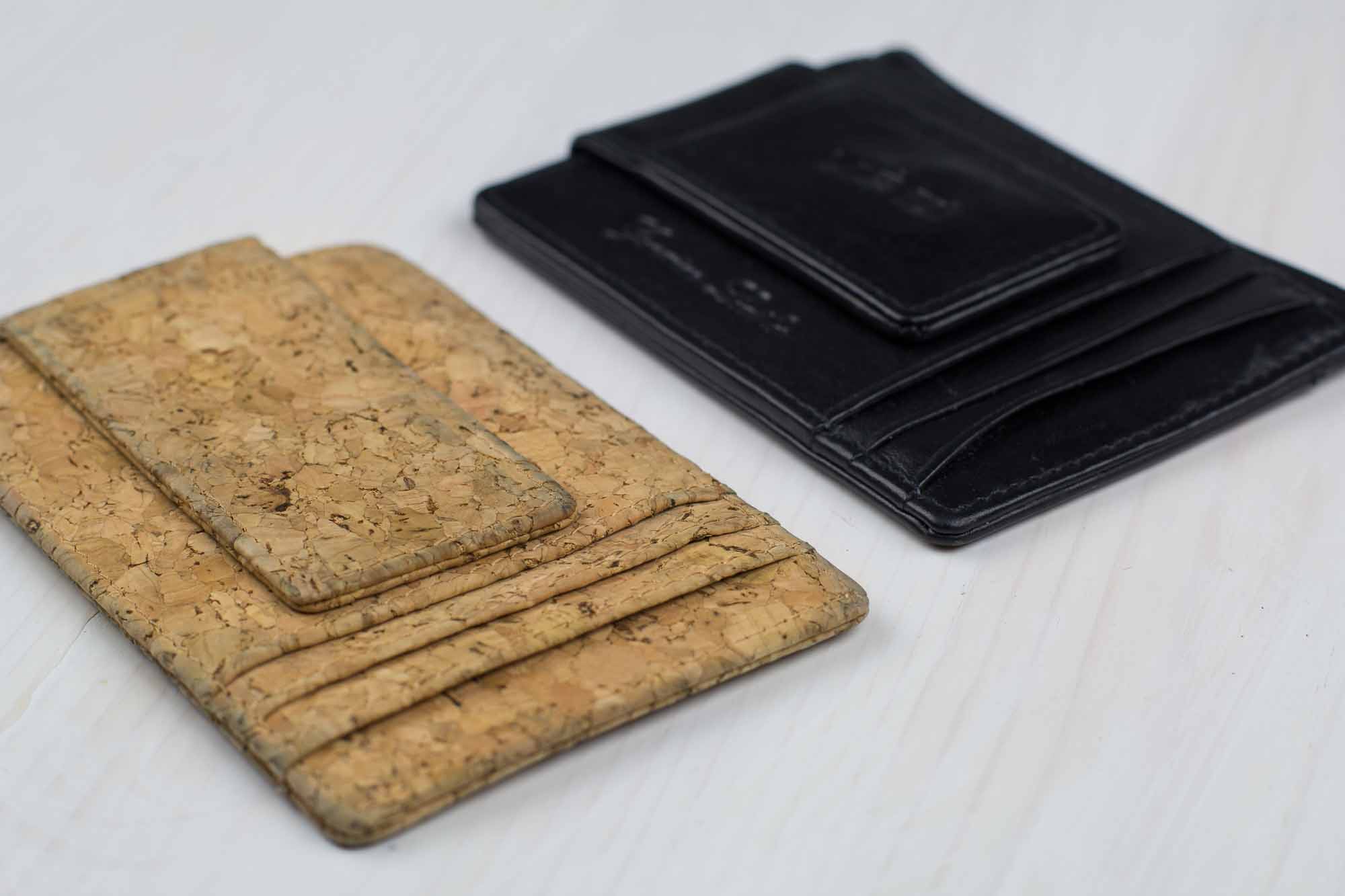
With nearly 2,000 Amazon reviews, a 4.7-star rating, and a sub-20 dollar price point, we knew we had to give the Viosi a try. Luckily, this money clip wallet didn’t disappoint, earning rave reviews from our focus group.
This genuine leather wallet is simple in appearance, with an ID window, several large slots, and a magnetized clip on the outside. Our tester noted that it was convenient to use, with the outside clip making it easy to grab cash. Despite relying on a single magnet, this clip gave us no concerns about security. It held on to money firmly until it was time to be removed.
The three card slots and two larger slots in the Viosi also mean that you don’t have to totally convert to minimalism to carry this wallet. There’s plenty of room in it for cards and receipts.
Looking for something even more budget-friendly? The folks at Kinzd say their goal is to offer “slim wallets at extremely affordable pricing,” and they seem to be doing just that.
Depending on the color in which you purchase it, the Kinzd money clip wallet can cost as low as $13 (at time of publishing). That’s a great value for a wallet that earned a cumulative 4.5 stars from nearly 1,400 reviewers on Amazon.
This wallet was a favorite among our testers, so much so that others requested to try it even after testing was complete. Our tester noted that everything stayed put in this wallet, and its slim profile made it easy to tote around. Plus, the attached clip held cash safely in place.
The Kinzd wallet is also durable, surviving a skirmish with some books and workout shoes at the bottom of our tester’s bag.
The only downside? The magnetized feature on this wallet clip has a tendency to adhere to other items, like keychains. Though, this may not be a downside if you’re looking to pull all of the essentials out of your bag at once!
The best banded options
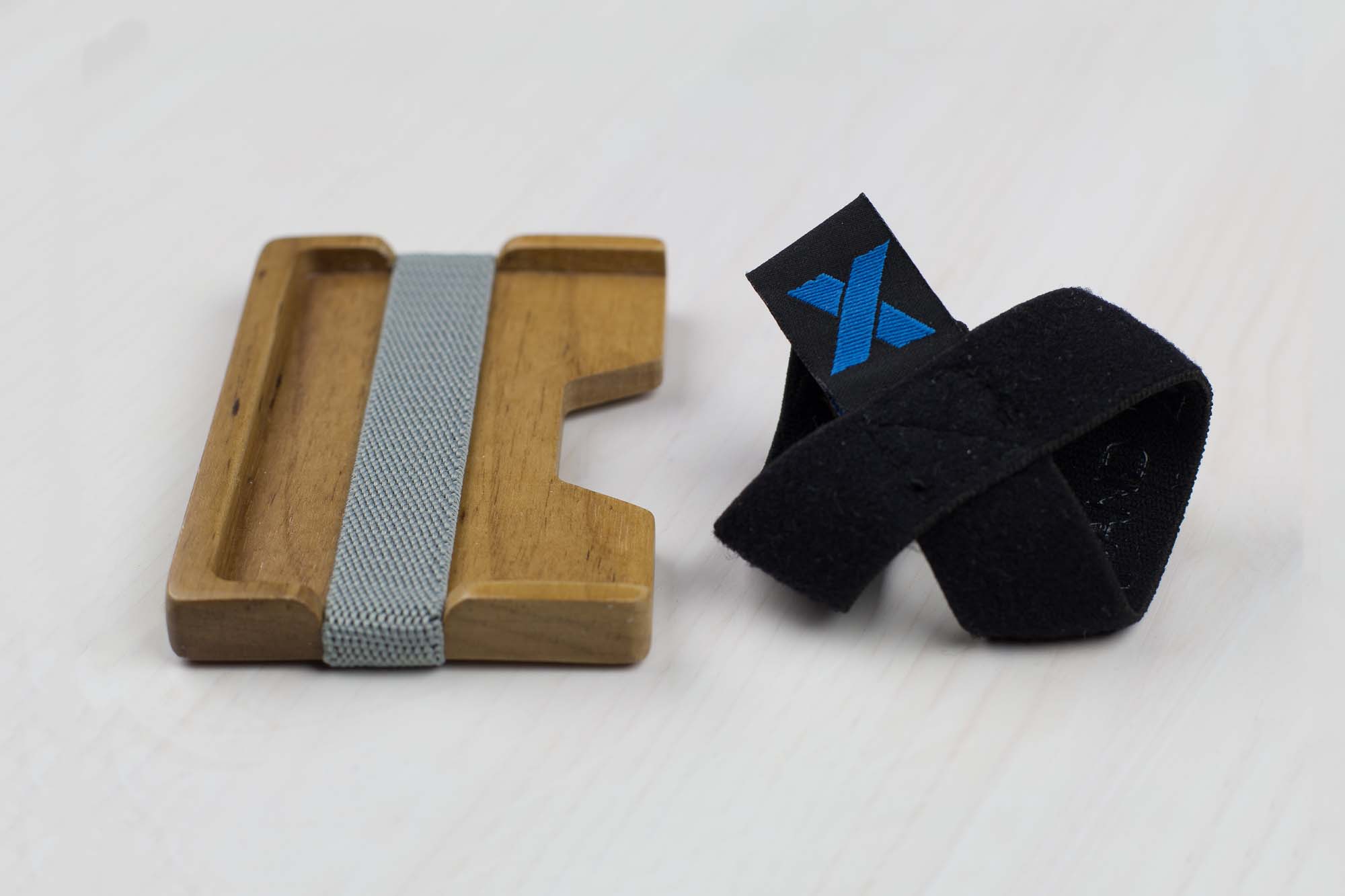
If you’re looking for an alternative way to store your money that’s not a traditional wallet and not quite a money clip, consider the Prägres wood-front wallet. Costing about $14 at time of publication, this contraption is hard to confine to any one money-carrier category.
Our tester was pretty skeptical about this wallet, yet by the end of the week, they were asking if they could keep it permanently. They loved the Prägres’ light weight and slim design, which allowed them to carry it in their front pocket. They also traveled with this wallet and found that whipping it out at the airport to retrieve their ID was easy.
The people at Prägres pride themselves on “wallets that make a statement,” and this one will certainly garner some attention. It has a hard, wooden construction that acts as a sort of frame for your credit cards. A band wraps around the entire frame to keep money and cards in place. On the back side of the wallet, you can slide your paper money under the band. A fun add? The wallet comes with three different colored bands to swap out as desired.
Perhaps most importantly, it kept our tester’s credit cards secure, yet allowed for easy removal when it was time to use them. And just in case you plan to do any cannonballs into the nearest pool, the reviews also state that this wallet will float.
Editor’s Note: The wooden version of this wallet is currently sold out, but Prägres makes a convenient and sleek carbon fiber alternative that comes with a built-in bottle opener.
Looking for an even lower-priced banded alternative? The Xband is our budget pick. Costing under $10, the Xband is minimalist in both price and composition. Simple in design, it has two nylon strips in the shape of, you guessed it, an “X,” that hold your money in place. Reviewers loved the simple functionality of this money carrier, and so did our tester. They noted that it was “super convenient,” and they liked that it stayed securely in their back pocket.
More high praise for this simple band? The Xband was easy to put cards and cash in and made it relatively easy to take cards and cash out. Its description claims that you only need to remove one strap to remove your cash, while the other strap keeps the rest of your contents secure.
The only complaint? Much like traditional money clips, the Xband makes it hard to pull just one bill or card out. It’s easier to remove everything, shuffle through it and then clip or band it all back together.
Other products we tested
| Product | Price | Type | Material |
|---|---|---|---|
| 7. Shivam | $ | Clip | Metal |
| 8. SHARKK | $ | Clip | Stainless steel |
| 9. Alaska Bear | $ | Clip | Stainless steel |
| 10. Knife Center | $ | Clip | Aluminum |
| 11. CL Carbonlife | $ | Clip | Carbon fiber |
| 12. Royce Leather Clip | $ | Clip | Leather |
| 13. Izola | $ | Clip | Brass |
| 14. Serman | $ | Clip | Carbon fiber |
| 15. Distil Union | $ | Clip Wallet | Leather |
| 16. idclipz | $ | Clip Wallet | Carbon fiber |
| 17. NapaWalli | $ | Clip Wallet | Leather |
| 18. MUTBAK | $ | Clip Wallet | Leather |
| 19. Alpine Swiss | $ | Clip Wallet | Leather |
| 20. Royce Leather Wallet | $ | Clip Wallet | Leather |
Money clips

Royce – Leather Magnetic money clip: While the Royce clip didn’t make our top picks, it’s still a quality choice for under $20. Its simple leather construction makes it classy and gender-neutral in appearance. Plus, our reviewer liked that it was “small enough to fit in a women’s pocket, but not too small to misplace.” The biggest downfall of this clip? Our tester didn’t feel the magnet was strong enough to hold more than a couple of cards.
Serman Brands – Real Carbon Fiber money clip: The Serman clip feels well-constructed and extremely lightweight in your pocket or bag. It has RFID-blocking technology and doesn’t scratch easily. What didn’t our tester like about this clip? Its looser grip meant the clips’ contents got knocked around easily, and it’s also not the most visually attractive option on the market.
Money clip wallets
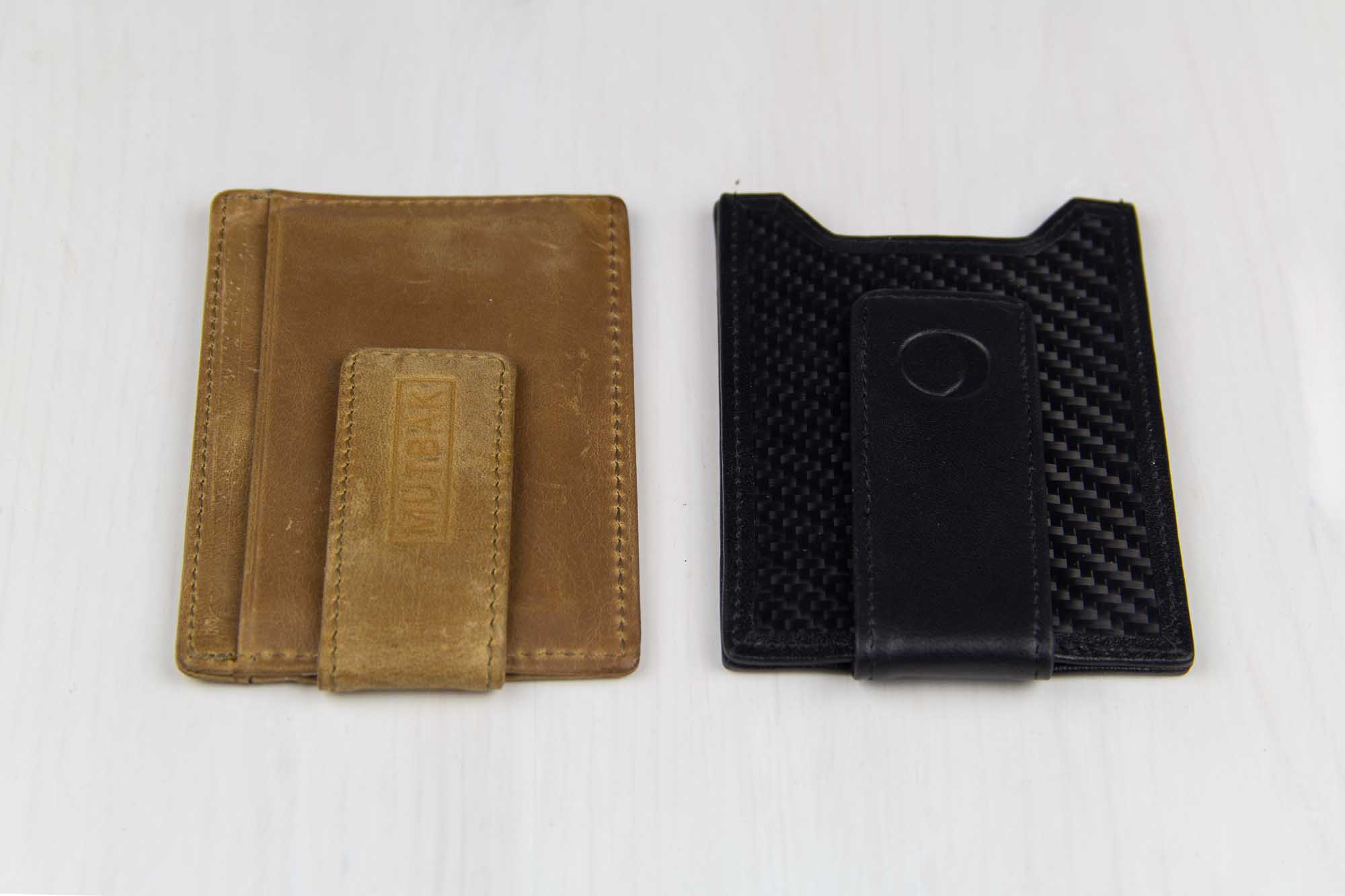
idclipz – Slim Carbon Fiber money clip wallet: Though the idclipz wallet clip didn’t make it into our top picks, our tester had rave reviews for it. They loved that it was slim enough to carry in their front pocket and that the magnetized clip was strong enough to feel secure. The only downside? A common complaint among our money clip testers: it’s hard to pull one bill out of the clip without everything else coming with it. For another magnetized choice, try the Viosi.
MUTBAK – Bunker: Our tester loved the MUTBAK for its slim profile and secure clip. It’s also one of the trendier-looking wallet clips on our list, with a worn-in leather look. The only major drawback to the MUTBAK is its overly deep credit card pockets, which make it hard to retrieve your plastic quickly. Still, if you need a slimmer wallet for a quick vacation, the MUTBAK would be a good choice.
Clips we don’t recommend
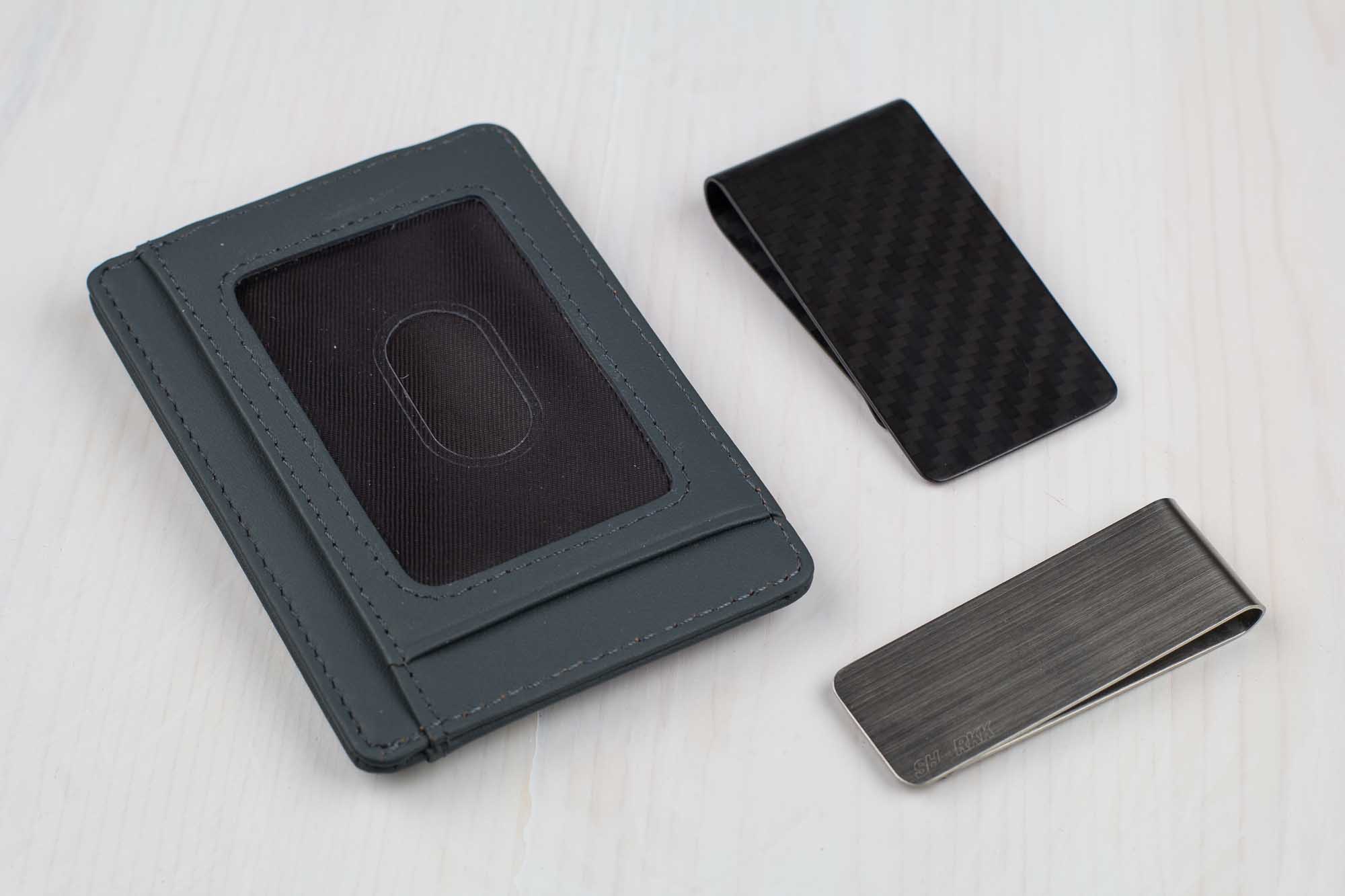
CL Carbonlife – Carbon Fiber Money Clip: Though reviewers on Amazon loved the CL Carbonlife, our tester found that the material was too rigid and made getting money out a difficult experience. In our experience, the Storus is a better pick for your money.
Sharkk – Stainless Steel Clip: We think our tester put it best: “the good news about this clip is that the metal is incredibly sturdy and will NOT release your plastic cards. The bad news is that it will NOT release your plastic cards.” They found that the Sharkk was too stiff, would not budge, and even scratched their credit cards when they tried to yank them out. For a similar design that won’t damage your plastic, we recommend the Adamant.
NapaWalli – Front Pocket Clip Wallet: The NapaWalli has great aesthetic appeal, and our testers liked its small, slim size. However, its downfall was its pockets. Our testers found them so stiff that getting cards out “was a chore.” We recommend the Viosi instead.
Some more luxurious picks
Like any accessory, appearance matters. So we decided to share some top-shelf picks that have serious visual appeal. We didn’t test these clips, but they get high style points from an aesthetic perspective. We like the Craighill – Square and Wave money clips for their unique shapes, and the Maxx and Unicorn – brass clip for its geometric appeal. And we also have our eyes on these aluminum money clips.
How we selected
When it comes to choosing a money clip, there are two primary factors: fashion and function. We aimed to choose clips that had both. We also know that money clips aren’t complicated. At their simplest, they’re just a bent piece of metal. But even so, there are some distinctions you can make about which are higher quality and will serve you better over time.
So, we combed through Amazon reviews to find clips that users loved for their function and efficiency. Then, we consulted trendy sites like HiConsumption and The Coolist to find clips that fashion-forward folks would want to own. Since these sites focus on curation rather than testing, we were sure to thoroughly test every money clip on this list.
In our research, we found that while many people were looking for traditional money clips, many others were also looking for money clip wallets. Money clip wallets are simply cardholders with money clips attached. Most lack the traditional “pocket,” for cash, which many reviewers note cuts down on bulkiness. Still, others liked money bands, which, while not truly a “clip,” performed a similar purpose of holding cash and cards together without the bulk of a wallet.
We decided to test all three of these “clip” types for our review, dividing them into the categories of money clips, money clip wallets, and banded money clips.
How we tested
Group testing
For a product as simple and straightforward as a money clip, we figured the best way to test it was to get it into the hands of everyday users. So, we rounded up ten co-workers (both men and women) and gave them a few simple rules:
- Ditch your wallet and carry all of your cash and cards in a money clip (or money clip wallet, or banded money clip) for one week.
- Use it everywhere you go, as you would a normal wallet.
- No cheating with an auxiliary coin purse, money pouch, or card carrier.
Our testers did as they were told. Because of the clips’ slim profiles, many of our testers were forced to ditch the old gift cards, outdated IDs and crumpled receipts they’d been carrying. Many saw this as an unforeseen benefit of switching to a clip.
After our testers finished out their week, we asked them a series of questions:
- Was your money clip convenient to use?
- Did your money and cards stay securely in the clip?
- How easy was it to both add and remove cash and cards to and from your clip?
- How did you carry your clip? (Front pocket? Back pocket? Purse?)
- Would you continue to use your money clip after testing?
After our testers answered these questions, they repeated the process again with a second money clip (or wallet or band).
Once we had our answers, we did a qualitative analysis to decide which clips were worth testing further. We eliminated the clips that testers found egregiously difficult to use or otherwise problematic.
Quality check
Once we had only tester-approved clips remaining, we examined their quality. Did the clips have sharp edges that were likely to scratch a phone screen? Did they feel like they would snap when bent past their natural angles? Did they spring back into place each time they were opened? We noted our observations, then used all of this information to determine the top clip in each category.
Should you be using a money clip?
The answer to this question depends largely on your habit and preferences. If you’re of the minimalist persuasion (or think that you could be), then a money clip is a natural choice. It forces you to cut back to the bare essentials. As one of our money clip testers put it:
“It was difficult to pare down my wallet to my ID, two credit cards, and cash, but it finally accomplished something that I’ve been wanting to do for a while — get my big fat wallet out of my back pocket.”
If you’re dedicated to carrying several forms of ID, your coffee shop rewards card, and a picture of your sweetheart everywhere you go, a money clip may not be right for you.
It’s also worth considering that a money clip, not unlike cuff links or a tie bar, can be an accessory for a special occasion. We spoke with men’s fashion and style blogger, Adam York of Your Average Guy who noted that “when the situation demands it…unleashing a bundle of crisp bank notes tightly clasped together within a stainless steel money clip will always have a timeless appeal.”
Still undecided? Let’s take a look at some pros and cons of carrying a money clip:
Pros:
- Most clips are sleek and unobtrusive, so they won’t ruin the look of an outfit. The Art of Manliness points out that “often underrated, [money] clips are even slimmer than wallets and can be eye-catching if you find a good one.”
- Most clips will fit in your front pocket, eliminating the need to sit on your wallet.
- Money clips force you to stop carrying unnecessary items (like old gift cards) everywhere.
- From a style perspective, money clips have a classic, vintage appeal.
Cons:
- Most clips cannot hold as many items as a conventional wallet.
- Some are so lightweight that users say they wouldn’t know if the clip fell out of their pocket.
- Some may consider money clips to be an “outdated” accessory.
- Poor-quality or too-tight clips could potentially scratch your credit cards.
One last note; there’s no doubt that in the modern age, many of us no longer carry paper money. In fact, according to the Washington Post half of Americans carry less than $20 in cash each day, and 9 percent of Americans carry none. Happily, many clips are just as effective at holding only a few plastic cards. (We’re looking at you, Adamant.)
How to use a money clip
If you’ve decided that a money clip is a good option for you, you may be wondering how to use one. Don’t roll your eyes; we know the obvious answer is “you clip your money together!”
However, there actually is some strategy to using one effectively. First, if you have paper money, you should fold it in half. Fold smaller bills on the outside to discourage people from stealing your money. Keep in mind that if you only carry large bills, you’ll likely end up with more change. Once folded, place the money into the clip, folded side first. Then, slide your credit cards in on top of the cash.
If you are using a magnetic money clip, you may want to avoid using it to carry credit cards. There is some concern that doing so will mess with the chip reader on your card. However, reviewers of the magnetic money clips that we tested didn’t find any issue with this.
Important features to consider
Type of clip: There are a few different types of clips from which you can choose. If you’re planning to carry primarily cash, choose a money clip or band. If you have several cards to carry as well, you may want to consider a money clip wallet.
Aesthetics: At the end of the day, all money clips essentially do the same thing: clip your money. So the biggest difference between any money clip is how it looks. There are clips available in everything from carbon fiber to leather to sterling silver, so do some browsing (and set a budget) before you decide. Also consider the weight and width of the clip, since you’ll likely be carrying it most places you go.
Quality: Does your money clip spring back into place after you open it? Does it seem like it will break if it’s a little overstuffed? Does it have sharp edges that’ll damage your phone screen? Or does it have a cheap finish that’ll show scratches from its scuffle with your keychain? Keep this in mind when selecting one.
Capacity: Some of the more poorly designed clips that we tested could barely open wide enough to fit one bill. Others could probably hold a paycheck’s worth of cash, no problem.
Cost: Based on our assessment of user reviews, there wasn’t a whole lot of quality difference between the cheaper and more expensive money clips. Some reviews claimed that the $20 clips (like the Storus) lasted them a decade, while more expensive ones looked worn-down after a year. So again, this really comes down to aesthetics. If you want something in solid aluminum or something gold-plated, prepare to pay a lot more.
RFID blocking: Many of the money clip wallets that we tested came with RFID blocking technology, which is supposed to stop thieves from stealing your credit card data. Does your wallet actually need this feature? It’s debatable. You can also achieve the same RFID-blocking effect with a piece of aluminum foil.
The bottom line
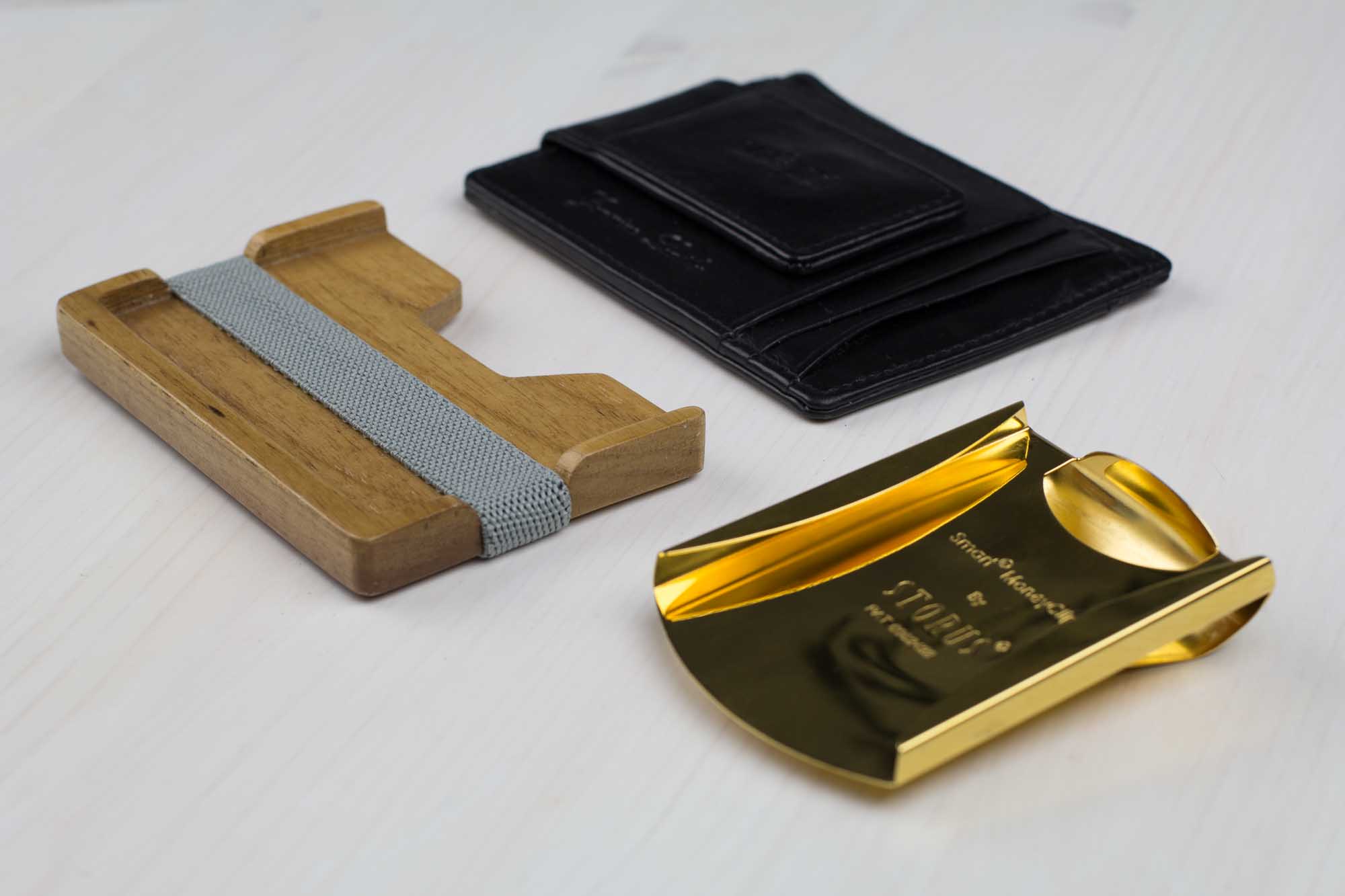
There’s no doubt that minimalism is having a moment, and a money clip ensures that decluttering begins in your pocket (or purse). It should be an item that you buy once and don’t have to think about again for a long time. It should be simple, functional and of course stylish. For our top pick, we think the Storus – Smart Clip achieves all of those goals. If you’re looking for the best wallet style clip, the Viosi – front pocket money clip gives you great value at a low price, and for the best banded money clip, the Prägres has our vote.
The post The Best Money Clips appeared first on Your Best Digs.
]]>The post The Best Planners for 2018 appeared first on Your Best Digs.
]]>Table of contents
- How we tested the planners
- Best overall: Erin Condren – Hardbound LifePlanner
- The runner-up: Me & My Big Ideas – Happy Planner
- The other planners we tested
- The bottom line
How we tested the planners
We had a group of professionals at our content marketing agency (that also runs Your Best Digs) pick a new weekly planner for the coming year.
Each tester used a planner individually for at least as week. Then, we held a focus group so participants could look at all of the planners and rank them. The group ranked the planners in order of best to worst, with 1 being best, and 11 being worst. We averaged the scores to create an average ranking. The lower the score, the better the planner rated. The results of that testing, and all the notes, data and etc, are available in a handy Google doc for your reference, here.
The team was firmly aware that there can’t be a true “best planner” universally — because in many ways, a planner is an extension of personal preference and style. However, with enough opinions, we definitely feel we can help push you towards a planner you’ll enjoy.
Update: For the 2018 planner testing, we followed a similar process. This time, we added a qualitative element to our focus group and individual testing. We gave each tester surveys with open-ended questions like “what do you like about this planner?” and “what is this planner not good for?” The result was a more in-depth understanding of what makes the best planners the best, and you’ll see that reflected in the analysis of this year’s winners.
The best planners for 2018

| Planner | Price | Months | Dimensions (inches) |
|---|---|---|---|
| 1. Erin Condren - LifePlanner | $ | 12 | 10 x 8 x 0.8 |
| 2. Me & My Big Ideas - Happy Planner | $ | 18 | 11.5 x 10.1 x 1.3 |
| 3. The Simple Elephant | $ | 12 | 8.3 x 0.8 x 5.9 |
| 4. Tools4Wisdom | $$ | 12 | 11 x 8.5 x 0.8 |
| 5. Freedom Mastery - Deluxe Law of Attraction Planner | $$$ | 12 | 10.5 x 7.8 x 1.3 |
Best overall: Erin Condren – Hardbound LifePlanner

The Erin Condren – 2018 Hardbound LifePlanner was created by a stay-at-home mom (Erin Condren) who had a passion for design. Her designs, and ultimately her LifePlanner, gained a cult following, and landed her big breaks on Rachel Ray and the Ellen Show. Today, the Erin Condren planner is one of the most blogged-about agendas out there, and it’s loved for more than just its pretty cover art.
Check out the 2019 edition of this planner here.
Our selective testers were impressed by the amount of writing space it provided. In fact, all but one tester agreed that it has enough room to write down everything they want. It also scored well in overall size, with the majority of respondents noting that it was not too big and heavy, nor too small and light. Everyone who used it said that its fonts were easy to read, and “high quality” was one of the most commonly-used descriptors for this planner.
Top Pick: Erin Condren
The Erin Condren's quality construction makes it stand out from other cutesy planners on the market. It's packed with encouraging quotes that may be the pick-me-up you need during a busy workweek. With large note sections and high-quality construction, the Erin Condren planner is the visually pleasing solution to organization.
The primary tester who used this agenda found the paper and cover to be good quality, and said that it was easy to write in with pens like the ones we tested in our pen review. They also loved the monthly overview, and were a big fan of the motivational quotes at the end of each week. On the other hand, they caution against using this planner if you’re an avid traveler; it’s a little too big to throw in a carry on.
The Erin Condren comes with a “color-coordinated” place-holder ribbon and finished pages with a splash of color, which means it’ll always look good sitting out on your desk or tabletop. We also like that it comes with a few dot grid pages for those who dabble in bullet journaling.
Other things our testers liked about this planner: it lies almost entirely flat like a book when you open it, which makes writing in it easy. One tester also noted that “the space for each day is just enough” to write their multitude of daily tasks in. If we had to pick something we didn’t like about the Erin Condren, we would say that there isn’t a ton of room for making lists. Some testers also wanted to see more interactive prompts about goals and objectives.
The runner-up: Me & My Big Ideas – Happy Planner

The Happy Planner from Me & My Big Ideas is the brainchild of a Mother-Daughter duo who started their business together creating stickers for scrapbooking. This background is evident in their highly-customizable Me & My Big Ideas – Happy Planner, which is replete with personalizable accessories, and yes, stickers. That being said, it still has all of the features required of a serious (and seriously helpful) planner. In fact, it was a close contender for first place in our tests.
Our testers all thought that it had attractive, easy to read fonts and a great layout. The majority of our our picky team of testers said that they would definitely commit to using this as their yearly planner. All but one person also said that there’s plenty of room to write in it. Testers loved the fun colors and colorfully-illustrated quotes sprinkled throughout the Happy Planner. They also loved that there was a dedicated birthdays section, enough room to take notes and tabbed sections that make accessing each month easier. Notably, this one is also an 18-month planner, making it perfect for long term and/or academic use, and planning long term project initiatives.
Of course, there are factors that stopped the Happy Planner from being number one, and they almost exclusively have to do with the planner’s construction. The majority of our testers found this planner too heavy for everyday use, and found that the large binding rings made it difficult to write near the center of the planner. This planner is also designed to have removable pages that you tear towards you to remove. So long as you tear them in the right direction, you can also put them back in the binding. However, it’s easy to accidentally tear them out from the side, which makes them impossible to put back in the binding.
We tested the 2018 planner, check out the 2019 planner here.
Other great planners we tested
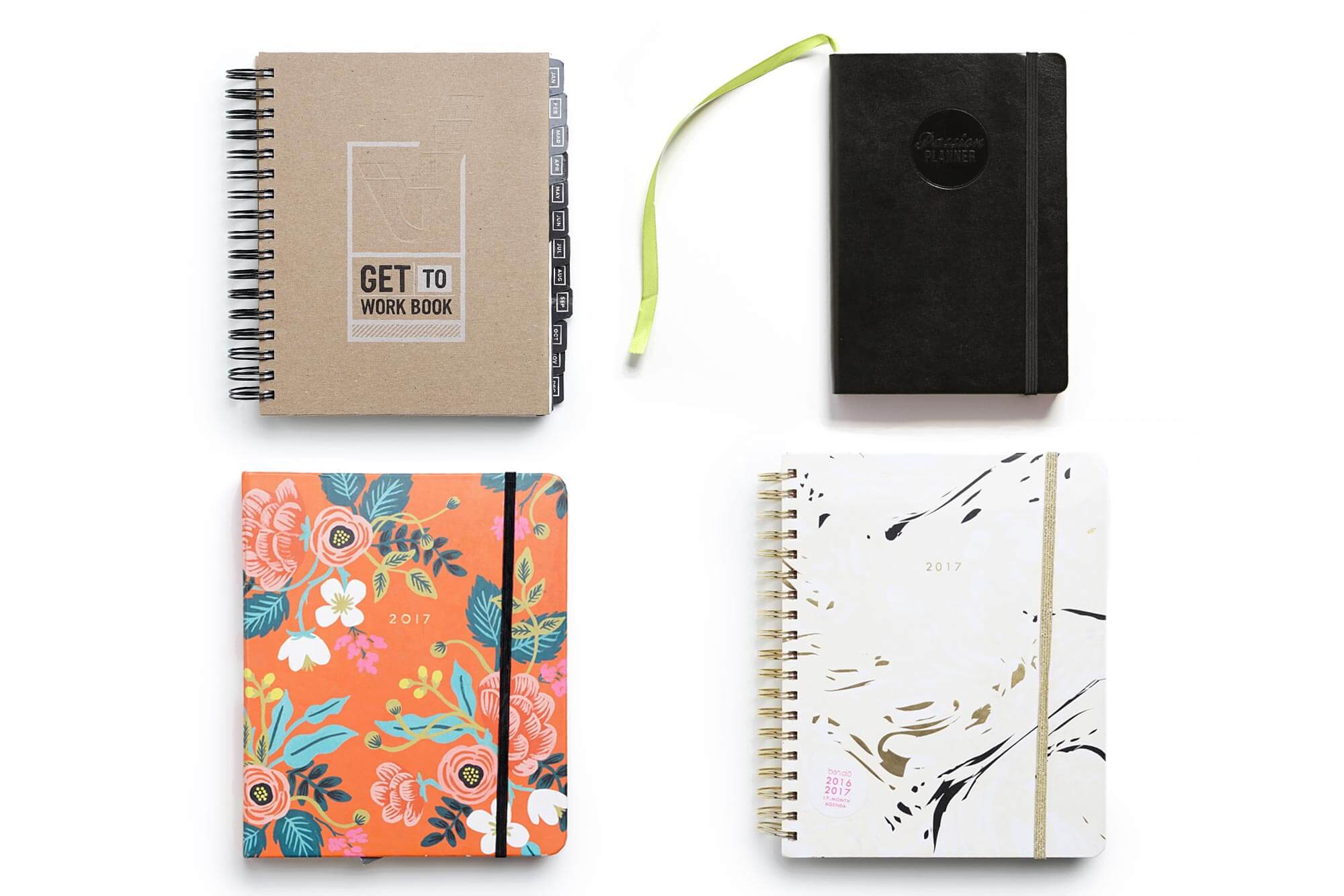
Last year’s best overall planner
In 2017 the Get to Work Book was our pick for best planner overall. Our group liked the Get to Work Book’s big, clean areas to write and overall inspirational design. It features large note taking areas, as well as helpful tabs that make flipping through or getting to the right page a breeze. It also includes great monthly reflection sections, as well as a “action items this week” area that makes prioritizing your most important tasks a breeze.
On the negative side, some people had concerns with the Get to Work Book’s size: it’s pretty bulky and will take up significant room on your desk. It’s also slightly masculine looking, which likely accounted for its slightly lower scores from the women in the group. The group also didn’t rate for price: the Get to Work Book is the most expensive planner we tested, at $50+. Notably, it was also the top-rated planner by men.
Long term testing notes: After using this planner for a year, our long-term tester found that it was simply too bulky for his every day use. Despite that, he thought the layout was “amazing” and could be an invaluable resource if you don’t mind lugging it around, or plan to have it stay on your desk.
Another planner highly rated by men
The Passion Planner was another hit with guys, a second-place pick from three of our male testers. As with the Get to Work it didn’t fare quite as well with women, however, and was number 9 out of 11 in overall ranking once the scores were averaged.
The team liked its monthly reflection areas, built in bookmark and significant note taking sections. The Passion Planner was also unique in having hourly breakdowns by day, which was a bit polarizing: some loved it, some hated it. If this makes sense for your planning style, the Passion Planner could be a great pick. However, if it doesn’t, the hourly breakdowns might feel like detail for the sake of it, and actually get in the way of your daily planning. Overall, the Passion Planner is a solid choice if it fits your scheduling style. The 2019 version is available here.
The top pick by women
The Rifle Paper 17 month agenda received the highest ranking from women, with an average rank of 2. It didn’t fare as well with the men, at a 6.5 average score, but that’s to be expected given its feminine aesthetic. The ban.do wasn’t too far behind, but on average, it far outpaced the field. The planner was lauded for more than its design inside and out: it also includes motivational quotes on each weekly page, tabs for quick reference, and is nicely sized for toting around or not taking up much space on your desk. Some reviewers noted they didn’t love the thinnish pages and felt like they could rip them out, but that was the only real negative for this planner. The 2018/1019 version is available here.
Long term testing notes:
Our long term tester for this planner noted that she thought the size of this planner was ideal, with enough room to write everything she wanted to. She liked the weekly and monthly views, and the functional tabs and pockets and durable cover.
Over the course of the year, she found that she didn’t like the way the monthly sections were separated from the monthly calendar, and she also disliked the daily sections being split into columns. Overall though, she plans to use a Rifle paper agenda again in 2018.
Another planner highly rated by women
The ban.do marble blonde planner is also a great choice for those who want a feminine look. It’s bursting with personality, and has a huge amount of note taking space. It also comes with two sheets of stickers, making this by far the most “fun” of any the planners we looked at. Overall, the ban.do ranked 3.75 on average with the women, and only slightly lower with the men, at 4 overall. On the negative side, the ban.do is a heavy, bulky planner compared to the rest of the models we tested, and that was a turnoff for some people. However, if you have a big desk and don’t plan on lugging it around, the ban.do can excel at the job asked of it.
Long term testing notes:
Our long term tester for this planner noted that she liked using the fun stickers over the course of the year, and she appreciated the way monthly and weekly calendars were right next to each other. She also liked all the fun and quirky holidays pre-printed on the calendar pages.
She disliked the planner’s overall bulkiness, and found it could be improved with a note section in the weekly calendars and a bookmark. The 2019 version is available here.
The rest:
The Action Day planner is a no frills, no personality planner that confused most of our group. It has 16 pages at the beginning telling you how to use it, which people either loved or hated, and it has no real note taking section besides in the very back of the planner.
The WTF planner is another fun option, but it feels more like a book than a planner, with pages that are hard to hold open. This makes it functionally difficult to use and was the main deterrent keeping it from a higher ranking than the 6 average it got from our group.
The team liked the horizontal, undated weekly planner, but came to the conclusion that it’s more of a supportive device than a standalone. For people who like the quick, constant visual reference, it can be a great desk add-on: but it’s not something with enough flexibility to be your primary planner.
The Sugar Paper planner was the highest rated option in our “other” group. The team liked its big note taking areas, intuitive layouts, and nice design end-to-end. Some didn’t love the legibility of its gold font or that the weekly views are condensed into one page, when they could have been two.
The Medium Monthly Planner is as minimalist as it comes: essentially paper in a brown shell. That was a turnoff for most looking for better functionality than a simple looking planner like this can offer.
The Simple Elephant was well loved by our testers, with a high quality, professional design. Importantly, this was the only planner in which our testers unanimously agreed that there was enough room to write everything. It’s packed with inspiring prompts for goal setting and objective tracking, and it doubles as a gratitude journal too.
The Freedom Mastery – Deluxe Law of Attraction Planner was another highly-rated agenda in our tests. It comes chock-full of stickers, prompts and inspiration, acting as part agenda and part vision board. If you like all of the inspiration, the Freedom Mastery may be perfect for you. However, testers looking for something simple wanted to steer clear of this one.
If you are looking for something simple, the Tools4Wisdom planner may be the best choice for you. This one had an academic feel to it, and our testers liked that it had plenty of room in which to write. It’s got all of the basic facets, like daily, weekly and monthly views. At the end of the day, it’s just generic, which may be exactly what some people want.
The bottom line
Long story short, if a planner works for you, it’s the best planner. But some planners are better than others, and a really great planner does more than work: it inspires you to use it and be more organized.
For 2018, we found that the Erin Condren – 2018 Hardbound LifePlanner is the best planner for achieving that goal. It’s efficient, attractive and inspiring, all inside a well-constructed binding that’ll easily last you through the year. Check out the 2019 edition of this planner here.
The Me and My Big Ideas – Happy Planner is another great option, with removable and re-insertable pages and tabbed months that make staying organized a breeze. Check out the 2019 version here.
While you’re looking for a new planner, don’t forget to stock up on writing supplies for the year: here’s our review of the best pens. We also have a review of the best mechanical pencils, if you need to frequently move agenda items around.
The post The Best Planners for 2018 appeared first on Your Best Digs.
]]>



